Optimization
Q3'25: Technology Update – Low Precision and Model Optimization
Authors
Nikolay Lyalyushkin, Liubov Talamanova, Alexander Suslov, Souvikk Kundu, Andrey Anufriev.
Summary
During Q3 2025, substantial progress was made across several fronts in efficient LLM inference — particularly in low-precision weight quantization, KV-cache eviction and compression, attention reduction through sparse and hybrid architectures, and architecture-aware optimization for State Space Models and Mixture-of-Experts. Notably, compression methods began to see adoption for FP4 formats, extending beyond traditional integer quantization, and numerous studies show that advanced KV-cache optimizations push the state of the art, achieving order-of-magnitude memory savings and notable speedups.
Highlights
- Bridging the Gap Between Promise and Performance for Microscaling FP4 Quantization (https://arxiv.org/pdf/2509.23202). The authors provide a rigorous analysis of FP4 microscaling formats (MXFP4 and NVFP4) for LLM quantization, introduce Micro-Rotated-GPTQ (MR-GPTQ) and the QuTLASS GPU kernels to bridge the performance gap for such formats. The method uses MSE-optimized grids, static activation reordering, and fused online Hadamard rotations to recover 98-99% of FP16 accuracy while achieving up to 4x inference speedups on modern GPUs. Key insights from the analysis include:
- The effectiveness of Hadamard transforms depends on the quantization group size; while they are beneficial for MXFP4 and INT4, they can actually degrade NVFP4 accuracy.
- MR-GPTQ consistently improves the accuracy of the lower-performing MXFP4 format, bringing it within 1-2% of NVFP4's performance.
- On average, NVFP4 and INT4 (with group size 32) offer similar quality.
- MXFP4 kernels may achieve ~15% higher throughput than NVFP4 on B200 GPUs, likely due to simpler hardware implementation.
The code available at: https://github.com/IST-DASLab/FP-Quant.

- Radial Attention: O(n log n) Sparse Attention with Energy Decay for Long Video Generation (https://arxiv.org/pdf/2506.19852). The paper "Radial Attention" introduces a sparse attention mechanism to optimize long video generation. Its core method reduces computational complexity from O(n2) to O(nlogn) using a static mask inspired by "Spatiotemporal Energy Decay," where attention focuses on spatially and temporally closer tokens. This architecture is highly optimized for inference. It delivers up to a 3.7x speedup on extended-length videos compared to standard dense attention, without any discernible loss in visual quality. For a concrete 500-frame, 720p video, the mechanism slashes the raw attention computation by a factor of 9x. The industrial impact is significant. Designed as a "plug-and-play" module, Radial Attention can be integrated into powerful pre-trained models like Wan2.1-14B and HunyuanVideo through efficient LoRA-based fine-tuning.

- Expected Attention: KV Cache Compression by Estimating Attention from Future Queries Distribution (https://arxiv.org/pdf/2510.00636). Expected Attention is a training-free KV cache compression method for LLMs that does not rely on observed attention scores, making it compatible with FlashAttention, where attention matrices are never materialized. It estimates the importance of cached key–value pairs by predicting how future queries will attend to them. Since hidden states before attention and MLP layers are empirically Gaussian-like, the method can analytically compute expected attention scores for each KV pair and rank them by importance for pruning. During decoding, Expected Attention maintains a small buffer of 128 hidden states to estimate future query statistics and performs compression every 512 generation steps. On LLaMA-3.1-8B, it achieves substantial memory savings—up to 15 GB reduction for 120k-token contexts. At a 50% compression ratio, Expected Attention maintains near-identical performance to the uncompressed baseline, effectively halving KV cache size while preserving output quality. Code: https://github.com/NVIDIA/kvpress
-
Papers with notable results
Quantization
- SINQ: Sinkhorn-Normalized Quantization for Calibration-Free Low-Precision LLM Weights (https://arxiv.org/pdf/2509.22944). The authors introduce a novel data-free post-training quantization method - SINQ. Instead of the traditional single-scale approach, SINQ employs dual scales: one for rows and another for columns. The method adapts the Sinkhorn-Knopp algorithm to normalize the standard deviations of matrix rows and columns. The algorithm is lightweight - operates at only 1.1x the runtime of basic RTN. The method proves robust across model scales, from small 0.6B parameter models to massive 235B parameter Mixture-of-Experts architectures. SINQ demonstrates orthogonality to other quantization advances. When combined with non-uniform quantization levels (NF4) or activation-aware calibration (A-SINQ with AWQ), it provides additional improvements.

- 70% Size, 100% Accuracy: Lossless LLM Compression for Efficient GPU Inference via Dynamic-Length Float (https://arxiv.org/pdf/2504.11651). The paper presents DFloat11, a dynamic-length float encoding scheme that exploits the low entropy of BFloat16 weights in large language models to achieve ~30% storage savings (reducing from 100% to ~70% size) without any loss in accuracy (bit-for-bit identical outputs). They do this by frequency-based variable-length coding of weight values, and couple it with a custom GPU decompression kernel allowing efficient inference. Experiments on large LLMs show major throughput gains and extended context length under fixed GPU memory budgets, making deployment more practical on resource-constrained hardware.
- XQUANT: Breaking the Memory Wall for LLM Inference with KV Cache Rematerialization (https://arxiv.org/pdf/2508.10395). This paper introduces XQuant, a memory-efficient LLM inference method that quantizes and caches input activations (X) of each transformer layer instead of Key-Value pairs. During inference, K and V are rematerialized on-the-fly by multiplying the cached X with the projection matrices, halving the memory footprint compared to standard KV caching. XQuant uses uniform low-bit quantization for X, which is more robust to aggressive quantization than K/V, enabling high compression with minimal accuracy loss. Building on this, XQuant-CL exploits cross-layer similarity in X embeddings by compressing the differences between successive layers, which have a smaller dynamic range due to the transformer's residual stream. Both XQuant and XQuant-CL outperform state-of-the-art KV cache quantization methods like KVQuant, while retaining accuracy close to the FP16 baseline. For GQA models, X is down-projected via offline SVD into a smaller latent space, preserving memory efficiency and accuracy. On LLaMA-2-7B and LLaMA-2-13B, XQuant achieves 7.7× memory savings with <0.1 perplexity degradation, while XQuant-CL reaches 12.5× savings at 2-bit precision (0.1 perplexity degradation) and 10× savings at 3-bit precision (0.01 perplexity degradation).
- Quamba2: A Robust and Scalable Post-training Quantization Framework for Selective State Space Models (https://arxiv.org/pdf/2503.22879). State Space Models (SSMs) are highly sensitive to quantization due to their linear recurrence process, which magnifies even minor numerical perturbations, making traditional Transformer quantization methods ineffective. The authors identify several distinctive properties of SSMs: (1) the input and output channel orders remain consistent, and (2) the activated channels and states are stable across time steps and input variations. Leveraging these insights, they propose Quamba2, a post-training quantization framework specifically tailored for SSMs. Quamba2 utilizes these properties through three key strategies: an offline sort-and-cluster process for input quantization, per-state-group quantization for input-dependent parameters, and cluster-aware weight reordering. The approach supports multiple precision configurations—W8A8, W4A8, and W4A16—across both Mamba1 and Mamba2 architectures. Empirical results show that Quamba2 surpasses existing SSM quantization methods on zero-shot and MMLU benchmarks. It achieves up to 1.3× faster pre-filling, 3× faster generation, and 4× lower memory usage on models such as Mamba2-8B, with only a 1.6% average accuracy drop. Code is available at https://github.com/enyac-group/Quamba.

- Qronos: Correcting the Past by Shaping the Future... in Post-Training Quantization (https://arxiv.org/pdf/2505.11695). The paper introduces Qronos, a new state-of-the-art post-training quantization (PTQ) algorithm for compressing LLMs. Its core innovation is that it unifies two critical error-handling strategies for the first time: it corrects for the "inherited" error propagated from previous layers and the "local" error from weights quantization within the current layer. This dual approach yields state-of-the-art results for small LLMs like Llama3-1B/3B/8B models. It can serve as a drop-in replacement for existing methods like GPTQ, running efficiently on resource-constrained hardware like AI laptops.

- Quantization Hurts Reasoning? An Empirical Study on Quantized Reasoning Models (https://arxiv.org/pdf/2504.04823). This paper conducts a systematic study on quantized reasoning models, evaluating the open-sourced DeepSeek-R1-Distilled Qwen and LLaMA families ranging from 1.5B to 70B params, QwQ-32B, and Qwen3-8B. The authors conducted quantization for weights, KV cache, and activation tensors. They claim that W8A8 or W4A16 may be treated as a form of lossless quantization. Specifically, for weights with 8-bit nearly all the quantization types generally lead to lossless accuracy, with no clear leading algorithm. While at 4-bit, FlatQuant emerges as a preferred algorithm and can yield near-lossless performance for the weight-only quantization scenario. For KV cache, the authors suggested 4-bit quantization as a safer choice, as at lower precision the models suffer from significant accuracy drop. Additionally, the authors claim that quantization may make more critical tasks more prone to error, with extreme low-precision models often generating longer sequences, hinting at longer thinking scenario. The code is available at: https://github.com/ruikangliu/Quantized-Reasoning-Models.
Pruning/Sparsity
- PagedEviction: Structured Block-wise KV Cache Pruning for Efficient Large Language Model Inference (https://arxiv.org/pdf/2509.04377). The authors propose PagedEviction, a structured block-wise KV cache eviction strategy designed for vLLM’s PagedAttention to enhance memory efficiency during large language model inference. The method computes token importance using the ratio of the L2 norm of Value to Key tokens, avoiding the need to store attention weights for compatibility with FlashAttention. It evicts an entire block only when the current block becomes full, reducing fragmentation and minimizing per-step eviction overhead. PagedEviction achieves high compression efficiency with minimal accuracy loss, significantly outperforming prior methods on long-context tasks. For example, it improves ROUGE scores by 15–20% over StreamingLLM and KeyDiff at tight cache budgets while closely matching full-cache performance at larger budgets across LLaMA-3.2-1B-Instruct and 3B-Instruct models.
- REAP: One-Shot Pruning for Trillion-Parameter Mixture-of-Experts Models (https://arxiv.org/pdf/2510.13999). The authors show that merging experts introduces an irreducible error and substantially reduces the functional output space of the compressed SMoE layer. Leveraging this insight, they propose Router-weighted Expert Activation Pruning (REAP), a one-shot pruning method that removes low-impact experts while preserving model quality. REAP assigns each expert a saliency score that combines its router gate-values with its average activation norm, effectively identifying experts that are rarely selected and have minimal influence on the model’s output. Across sparse MoE architectures from 20B to 1T parameters, REAP consistently outperforms prior pruning and merging methods, particularly at 50% compression. It achieves near-lossless compression on code generation tasks, retaining performance after pruning 50% of experts from Qwen3-Coder-480B and Kimi-K2. Code is available at: https://github.com/CerebrasResearch/reap.
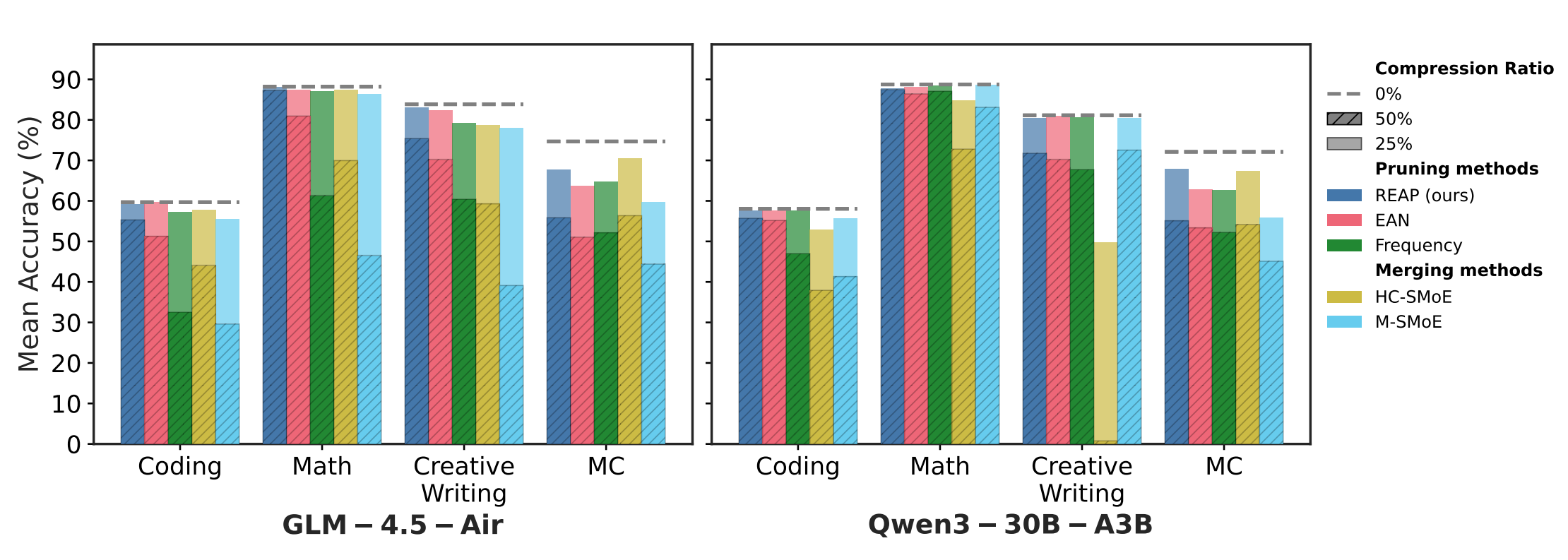
- The Unseen Frontier: Pushing the Limits of LLM Sparsity with Surrogate-Free ADMM (https://arxiv.org/pdf/2510.01650). This paper tackles the limitation of existing pruning methods for large language models, which struggle to exceed 50–60% sparsity without severe performance loss. The authors attribute this to the use of indirect objectives, such as minimizing layer-wise reconstruction errors, which accumulate mistakes and lead to suboptimal outcomes. To address this, the proposed method, ELSA, directly optimizes the true task objective — minimizing loss on actual downstream tasks — rather than relying on surrogate goals. It leverages the ADMM framework, a proven mathematical technique that decomposes complex problems into simpler alternating steps, to guide the pruning process while maintaining alignment with the model’s real objectives. A lightweight variant, ELSA-L, further improves scalability by using lower-precision data formats, enabling efficient pruning of even larger models. ELSA achieves 7.8× lower perplexity than the best existing method on LLaMA-2-7B at 90% sparsity. Although some accuracy loss remains, this represents a major breakthrough, and the authors argue that improved global optimization, like their approach, could further narrow this gap.
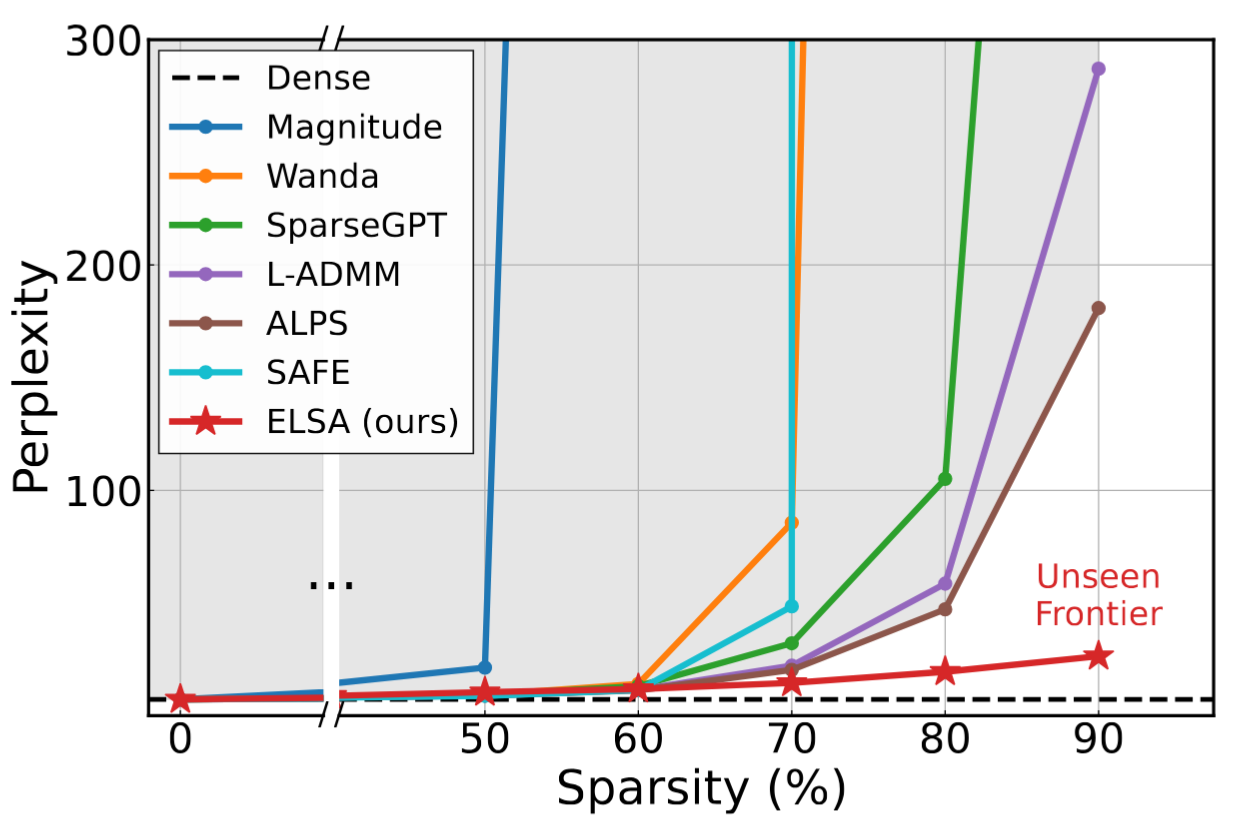
Other
- Top-H Decoding: Adapting the Creativity and Coherence with Bounded Entropy in Text Generation (https://openreview.net/pdf/0b494e52bae7fe34f7af35e0d5bfa6bd0dcb39b8.pdf). Toward effective incorporation of the confidence of the model while generating tokens, the authors propose top-H decoding. The authors first establish the theoretical foundation of the interplay between creativity and coherence in truncated sampling by formulating an entropy-constrained minimum divergence problem. Then they prove this minimization problem to be equivalent to an entropy-constrained mass maximization (ECMM) problem, which is NP-hard. Finally, the paper presents top-H decoding, a computationally viable greedy algorithmic approximation to solve the ECMM problem. Extensive empirical evaluations demonstrate that top-H outperforms the state-of-the-art (SoTA) alternative of min-p sampling by up to 25.63% on creative writing benchmarks, while maintaining robustness on question-answering datasets such as GPQA, GSM8K, and MT-Bench. Additionally, an LLM-as-judge evaluation confirms that top-H indeed produces coherent outputs even at higher temperatures, where creativity is especially critical. In summary, top-H advances SoTA in open-ended text generation and can be easily integrated into creative writing applications. The code is available at: https://github.com/ErfanBaghaei/Top-H-Decoding.
- Stop Spinning Wheels: Mitigating LLM Overthinking via Mining Patterns for Early Reasoning Exit (https://arxiv.org/pdf/2508.17627). The authors introduce a lightweight framework to detect and terminate reasoning at the optimal Reasoning Completion Point (RCP), preventing unnecessary token generation in large reasoning models. They categorize the reasoning process of LLMs into three stages: insufficient exploration, compensatory reasoning, and reasoning convergence. Typically, LLMs produce correct answers during the compensatory reasoning stage, while the reasoning convergence stage often triggers overthinking, leading to excessive resource usage or even infinite loops. The RCP is defined as the boundary marking the end of the compensatory reasoning stage and typically appears at the end of the first complete reasoning cycle, beyond which additional reasoning offers no accuracy gain. To balance efficiency and accuracy, the authors distilled insights from CatBoost feature importance analysis into a concise and effective set of stepwise heuristic rules. Experiments on benchmarks such as AIME24, AIME25, and GPQA-D demonstrate that the proposed strategy reduces token consumption by over 30% while maintaining or improving reasoning accuracy.

- A Systematic Analysis of Hybrid Linear Attention (https://arxiv.org/pdf/2507.06457). This work systematically analyzes hybrid linear attention architectures to balance computational efficiency with long-range recall in large language models. The authors construct hybrid models by interleaving linear and full attention layers at varying ratios (24:1, 12:1, 6:1, 3:1) to analyze their impact on performance and efficiency. The key insight is that gating, hierarchical recurrence, and controlled forgetting mechanisms are critical to achieve Transformer-level recall in hybrid architectures when deployed at a 3:1 to 6:1 linear-to-full attention ratio, reducing KV cache memory by a factor of 4-7x.
- Gumiho: A Hybrid Architecture to Prioritize Early Tokens in Speculative Decoding (https://arxiv.org/pdf/2503.10135). The authors deliver a new Speculative Decoding (SD) method for accelerating Large Language Model (LLM) inference. This is an incremental improvement of the Eagle SD method from NVIDIA. Its core insight is that early tokens in a speculative decoding draft are disproportionately more important than later ones. The paper introduces a novel hybrid architecture to exploit this: a high-accuracy serial Transformer for the crucial first tokens and efficient parallel MLPs for subsequent ones. Gumiho surpasses the existing SOTA method EAGLE-2 by 4.5%∼15.8%, but does not have a comparison with EAGLE-3. The code: https://github.com/AMD-AGI/Gumiho
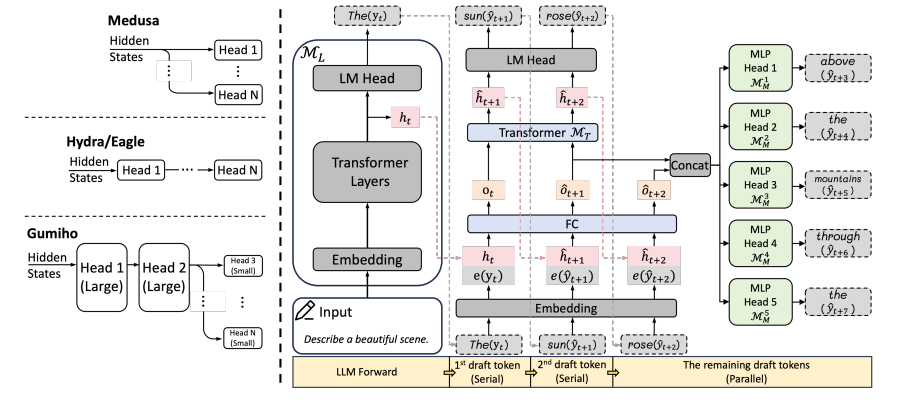
Software
- OptiLLM (https://github.com/algorithmicsuperintelligence/optillm) is an OpenAI API-compatible optimizing inference proxy that implements 20+ state-of-the-art techniques to dramatically improve LLM accuracy and performance on reasoning tasks - without requiring any model training or fine-tuning. It is possible to beat the frontier models using these techniques across diverse tasks by doing additional compute at inference time.
- FlashDMoE (https://flash-moe.github.io): Fast Distributed MoE in a Single Kernel - a fully GPU-resident MoE operator that fuses expert computation and inter-GPU communication into a single persistent GPU kernel. FlashDMoE enables fine-grained pipelining of dispatch, compute, and combine phases, eliminating launch overheads and reducing idle gaps.
- LMCache (https://github.com/LMCache/LMCache) is an LLM serving extension that cuts TTFT and boosts throughput in long-context scenarios. By storing the KV caches of reusable texts across various locations, including (GPU, CPU DRAM, Local Disk), LMCache reuses the KV caches of any reused text (not necessarily prefix) in any serving engine instance. Integrated with vLLM, LMCache delivers 3–10× faster responses and lower GPU usage in tasks like multi-round QA and RAG.
- Flash Attention 4 (FA4) is a newly developed CUDA kernel optimized for Nvidia’s Blackwell architecture, delivering roughly a 20% performance improvement over previous versions. It achieves this speedup through an asynchronous pipeline of operations and several mathematical optimizations, including a fast exponential approximation and a more efficient online softmax. Tri Dao presented early results of FA4 at Hot Chips, and further implementation details were later shared in a blog post: https://modal.com/blog/reverse-engineer-flash-attention-4.
Q2'25: Technology Update – Low Precision and Model Optimization
Authors
Alexander Suslov, Alexander Kozlov, Nikolay Lyalyushkin, Nikita Savelyev, Souvikk Kundu, Andrey Anufriev, Pablo Munoz, Liubov Talamanova, Daniil Lyakhov, Yury Gorbachev, Nilesh Jain, Maxim Proshin, Evangelos Georganas
Summary
This quarter marked a major shift towards efficiency in large-scale AI, driven by the unsustainable computational and memory costs of current architectures. The focus is now on making models dramatically faster and more hardware-friendly, especially for demanding long-context and multimodal tasks. 🚀 There is a growing adoption of dynamic, data-aware techniques like dynamic sparse attention and token pruning, which intelligently reduce computation by focusing only on the most critical information. Furthermore, optimization is increasingly tailored to new hardware through ultra-low precision; quantization is being pushed to the extreme, with native 1-bit (BitNet) inference and 4-bit (FP4) training becoming viable by aligning directly with new GPU capabilities.
A parallel trend is the creation of simple, readable frameworks like Nano-vLLM, whose lightweight design aims to lower the barrier to entry for developers and researchers.
Highlights
- MMInference: Accelerating Pre-filling for Long-Context Visual Language Models via Modality-Aware Permutation Sparse Attention (https://arxiv.org/pdf/2502.02631). The authors introduce MMInference (Multimodality Million tokens Inference), a dynamic sparse attention method that accelerates the prefilling stage for long-context multi-modal inputs. The core ideas stemfrom analyzing the attention patterns specific to multi-modal inputs in VLMs: (1) Visual inputs exhibit strong temporal and spatial locality, leading to a unique sparse pattern the authors term the "Grid pattern".(2) Attention patterns differ significantly within a modality versus across modalities. The authors introduces the permutation-based method for offline searching the optimal sparse patterns for each head based on the input andoptimized kernels to compute attention much faster. MMInference speeds up the VLM pre-filling stage by up to 8.3x (at 1 million tokens) without losing accuracy and without needing any model retraining.The paper demonstrates maintained performance across various multi-modal benchmarks (like Video QA and Captioning) using state-of-the-art models (LongVila, LlavaVideo, VideoChat-Flash, Qwen2.5-VL). The code is available at https://aka.ms/MMInference.
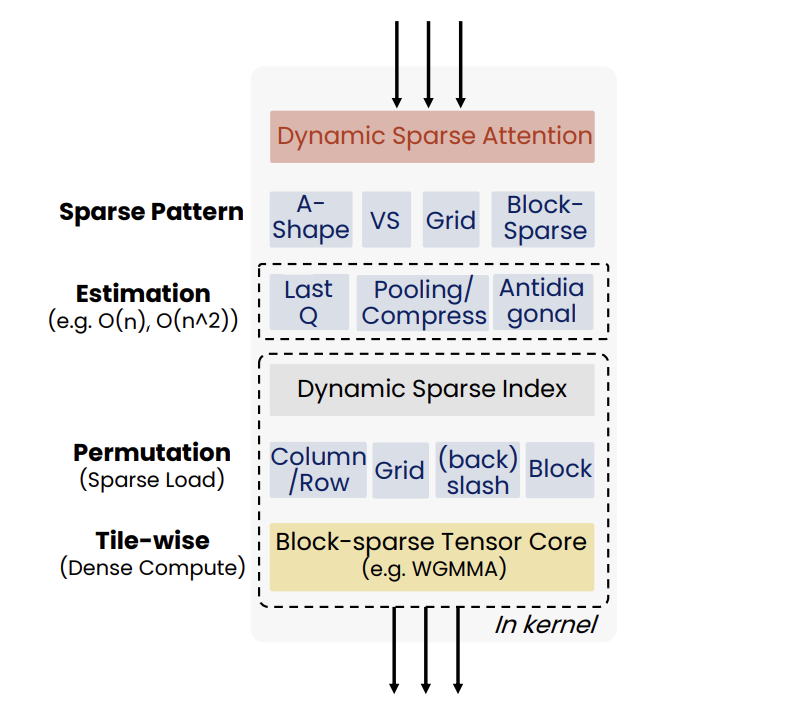
- Beyond Text-Visual Attention: Exploiting Visual Cues for Effective Token Pruning in VLMs (https://arxiv.org/pdf/2412.01818). The authors introduce VisPruner, a training-free method for compressing visual token sequences in VLMs, dramatically reducing computational overhead. Unlike prior approaches that rely on text-visual attention scores - often biased and dispersed - VisPruner leverages visual cues directly from the visual encoder. They identify two key flaws in attention-based pruning: (1) attention shift: positional bias causes attention to favor lower image regions (tokens closer to the text in sequence); (2) attention dispersion: attention is spread too uniformly, making it hard to identify important tokens. VisPruner first selects a small set of important tokens using [CLS] attention (typically focused on foreground objects), then complements them with diverse tokens selected via similarity-based filtering to preserve background and contextual information. This visual-centric pruning strategy avoids reliance on language model internals and is compatible with fast attention mechanisms like FlashAttention. VisPruner outperforms finetuning-free baselines like FastV, SparseVLM, and VisionZip across 13 benchmarks—including high-resolution and video tasks—even when retaining as little as 5% of the original visual tokens. It achieves up to 95% FLOPs reduction and 75% latency reduction.

- OuroMamba: A Data-Free Quantization Framework for Vision Mamba Models (https://www.arxiv.org/pdf/2503.10959). The authors present OuroMamba, the first data-free post-training quantization (DFQ) method for vision Mamba-based models (VMMs). The authors identify two key challenges in enabling DFQ for VMMs, (1) VMM’s recurrent state transitions restricts capturing of long-range interactions and leads to semantically weak synthetic data,(2) VMM activation exhibit dynamic outlier variations across time-steps, rendering existing static PTQ techniques ineffective. To address these challenges, OuroMamba presents a two-stage framework: (1) OuroMamba-Gen to generate semantically rich and meaningful synthetic data. It applies constructive learning on patch level VMM features generated through neighborhood interactions in the latent state space, (2) OuroMamba-Quant to employ mixed-precision quantization with lightweight dynamic outlier detection during inference. In specific, the paper presents a threshold based outlier channel selection strategy for activation that gets updated every time-step. Extensive experiments across vision and generative tasks show that our data-free OuroMamba surpasses existing data-driven PTQ techniques, achieving state-of-the-art performance across diverse quantization settings. Additionally, the authors demonstrate the efficacy via implementation of efficient GPU kernels to achieve practical latency speedup of up to 2.36×.

- TailorKV: A Hybrid Framework for Long-Context Inference via Tailored KV Cache Optimization (https://arxiv.org/pdf/2505.19586). TailorKV is a novel framework designed to optimize the KV cache in LLMs for long-context inference, significantly reducing GPU memory usage and latency without sacrificing model performance.Instead of applying a one-size-fits-all compression strategy, TailorKV intelligently tailors compression based on the characteristics of each Transformer layer. The authors look at how each layer distributes its attention across tokens: (1) If a layer spreads attention broadly across many tokens, it’s considered to be dense. These layers are good candidates for quantization, because compressing them doesn’t significantly harm performance (usually shallow layers). (2) If a layer focuses attention on just a few tokens, it’s considered to be sparse. These layers are better suited for sparse retrieval, where only the most important tokens are kept in memory (deeper layers). To make this decision, they compute a score for each layer that reflects how concentrated or spread out the attention is. If the score is above a certain threshold, the layer is labeled quantization-friendly; otherwise, it’s considered sparsity-friendly. This classification is done offline, meaning it’s calculated once before inference, so it doesn’t affect runtime performance. TailorKV drastically reduces memory usage by quantizing 1 to 2 layers to 1-bit precision and loading only 1% to 3% of the tokens for the remaining layers.Maintains high accuracy across diverse tasks and datasets, outperforming state-of-the-art methods like SnapKV, Quest, and PQCache on LongBench. Code is available at: https://github.com/ydyhello/TailorKV.

- Log-Linear Attention (https://arxiv.org/pdf/2506.04761). The authors present Log-Linear Attention, a general framework that extends linear attention and state-space models by introducing a logarithmic growing memory structure for efficient long-context modeling. The paper identifies two key limitations in prior linear attention architectures: (1) the use of fixed-size hidden states restricts their ability to model multi-scale temporal dependencies, and (2) their performance degrades on long sequences due to the lack of hierarchical context aggregation.To address these challenges, Log-Linear Attention places a particular structure on the attention mask, enabling the compute cost to be log-linear and the memory cost to be logarithmic in sequence length (O(TlogT) training time,O(logT) inference time and memory). Conceptually, it uses a Fenwick tree–based scheme to hierarchically partition the input into power-of-two-sized segments. Each query attends to a logarithmic number of hidden states, summarizing increasingly coarse ranges of past tokens. This design emphasizes recent context with finer granularity, while efficiently compressing distant information.The framework is instantiated on top of two representative models: Mamba-2 and Gated DeltaNet, resulting in Log-Linear Mamba-2 and Log-Linear Gated DeltaNet. These variants inherit the expressive recurrence structures of their linear counterparts but benefit from logarithmic memory growth and sub-quadratic training algorithms via a custom chunk-wise parallel scan implementation in Triton.Experiments across language modeling, long-context retrieval, and in-context reasoning benchmarks show that Log-Linear Attention consistently improves long-range recall while achieving competitive or better throughput than FlashAttention-2 at longer sequence lengths (>8K). The code is available at https://github.com/HanGuo97/log-linear-attention.
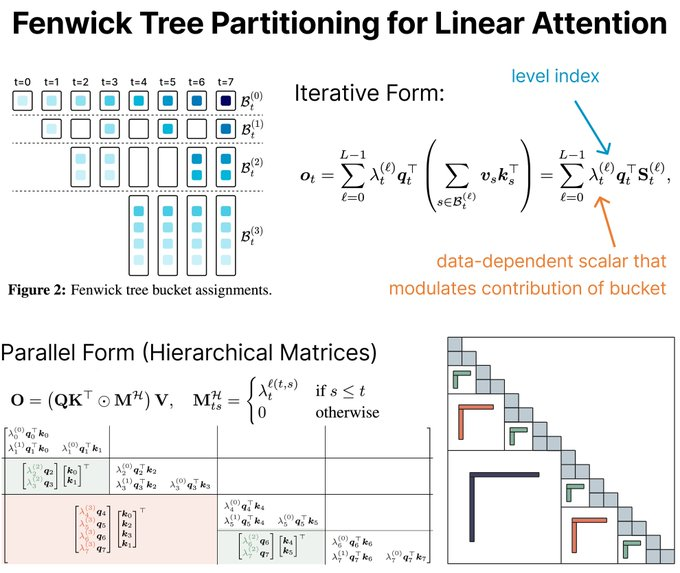
- The Sparse Frontier: Sparse Attention Trade-offs in Transformer LLMs (https://arxiv.org/pdf/2504.17768). The authors introduce SparseFrontier, a systematic evaluation of dynamic sparse attention methods aimed at accelerating inference in LLMs for long-context inputs (up to 128K tokens). The core ideas stem from an extensive analysis of sparse attention trade-offs across different inference stages, model scales, and task types: (1) Sparse attention during decoding tolerates higher sparsity than during prefilling, particularly in larger models, due to differences in memory and compute bottlenecks.(2) No single sparse pattern is optimal across all tasks - retrieval, aggregation, and reasoning tasks each require different units of sparsification (e.g., blocks vs. tokens) and budget strategies. During prefilling, the best sparsification structure (e.g., blocks or verticals and slashes) is task-dependent, with uniform allocation across layers performing comparably to dynamic allocation. During decoding, page-level Quest excels by preserving the KV cache structure, avoiding the performance degradation associated with token pruning during generation. Their FLOPS analysis shows that for long context, large sparse models outperform smaller dense ones at the same compute cost. They also establish scaling laws predicting accuracy from model size, sequence length, and compression ratio.The code is available at: https://github.com/PiotrNawrot/sparse-frontier.
Papers with notable results
Quantization
- SeedLM: Compressing LLM Weights into Seeds of Pseudo-Random Generators (https://arxiv.org/pdf/2410.10714). This paper introduces SeedLM, a novel data-free post-training compression method for Large Language Models (LLMs) that uses seeds of pseudo-random generators and some coefficients to recreate model weights. SeedLM aims to reduce memory access and leverage idle compute cycles during inference, effectively speeding up memory-bound tasks by trading compute for fewer memory accesses.The method generalizes well across diverse tasks, achieving better zero-shot accuracy retention at 4- and 3-bit compression compared to OmniQuant, AWQ and QuIP#. Additionally, FPGA-based tests demonstrate close to 4x speedup for memory-bound tasks such as generation for 4bit per value over an FP16 Llama baseline.
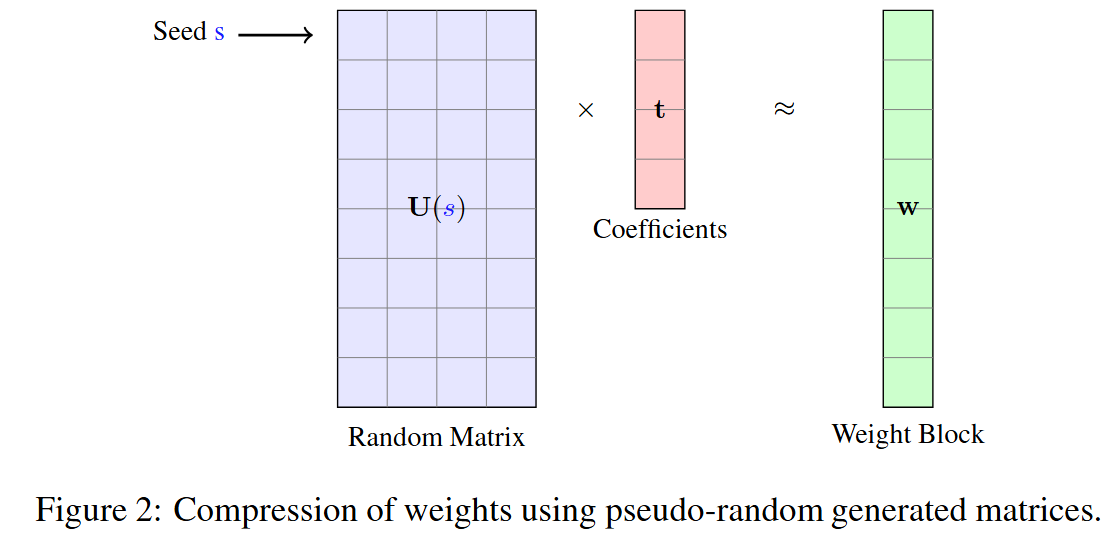
- LoTA-QAF: Lossless Ternary Adaptation for Quantization-Aware Fine-Tuning (https://arxiv.org/pdf/2505.18724). LoTA-QAF is a quantization-aware fine-tuning method for LLMs designed for efficient edge deployment. Its key innovation is a ternary adaptation approach, where ternary adapter matrices can only increment, decrement, or leave unchanged each quantized integer weight (+1, −1, or 0) within the quantization grid during fine-tuning. This tightly restricts the amount each quantized value can change, ensuring the adapters do not make large modifications to weights. The method enables lossless merging of adaptation into the quantized model, preserving computational efficiency and model performance with no quantization-induced accuracy loss at merge. The method uses a novel ternary signed gradient descent (t-SignSGD) optimizer to efficiently update these highly constrained ternary weights. Evaluated on the Llama-3.1/3.3 and Qwen-2.5 families, LoTA-QAF consistently outperforms previous quantization-aware fine-tuning methods such as QA-LoRA, especially at very low bit-widths (2-bit and 3-bit quantization), recovering up to 5.14% more accuracy on MMLU compared to LoRA under 2-bit quantization, while also being 1.7x–2x faster at inference after merging. Task-specific fine-tuning shows LoTA-QAF improves on other quantization-aware methods, though it slightly lags behind full-precision LoRA in those scenarios.The code is available at: https://github.com/KingdalfGoodman/LoTA-QAF.
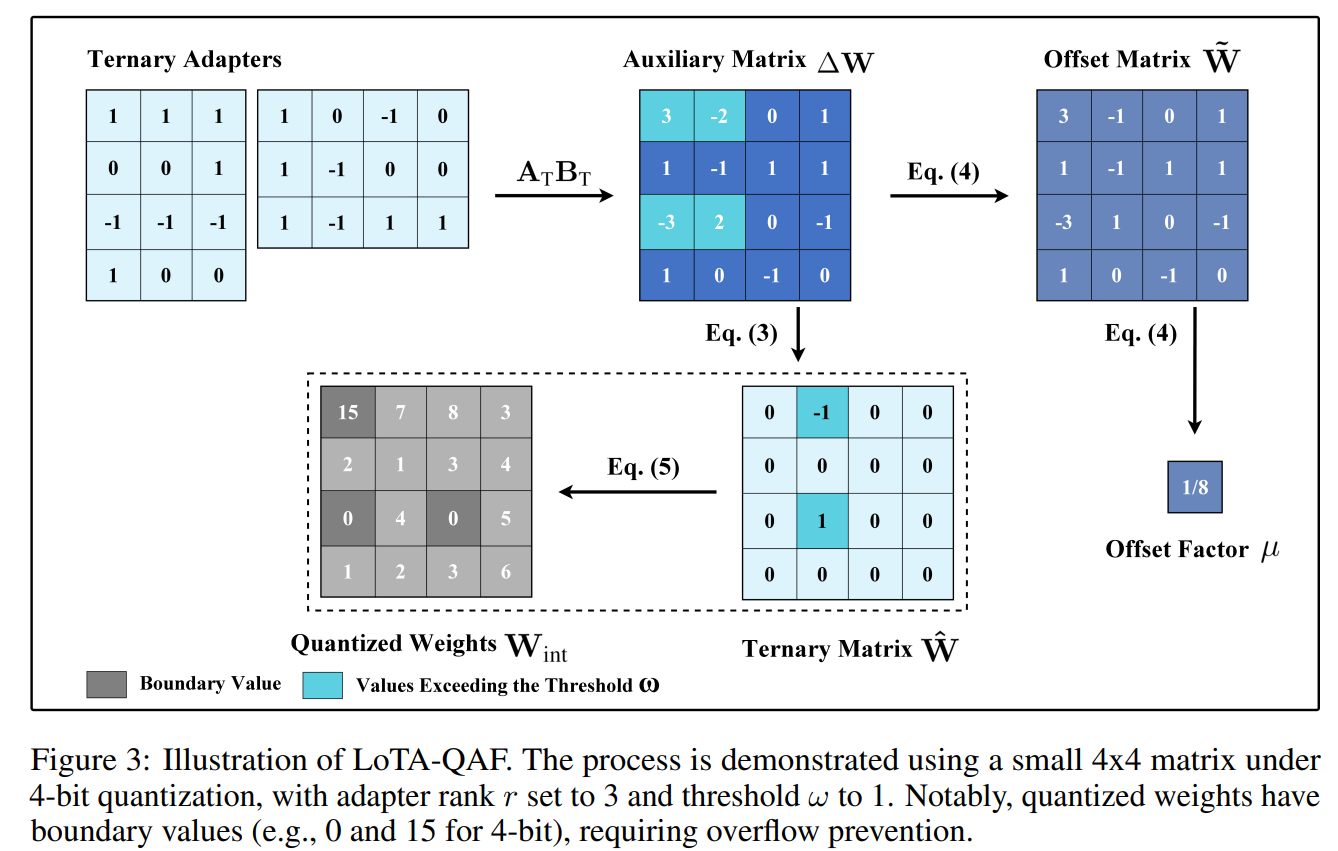
- SageAttention3: Microscaling FP4 Attention for Inference and An Exploration of 8-bit Training (https://arxiv.org/abs/2505.11594). The authors introduce SageAttention3, a novel FP4 micro-scaling quantization technique for Transformer attention designed to achieve a 5x speedup in inference on NVIDIA GPUs and an 8-bit novel training approach that preserves model accuracy during finetuning while reducing memory demands. The method applies FP4 quantization to the two main attention matrix multiplications, using a microscaling strategy with a group size of 16 elements per scale factor. This fine granularity limits the impact of outlier values that can otherwise cause significant quantization error. To address issues with quantizing the attention map, the authors propose a two-level quantization scheme. First, each row of attention map is scaled into the range[0, 448 × 6], which ensures the FP8 scaling factor (required by hardware) fully utilizes its representation range. Then, FP4 quantization is applied at the block level. This two-step process significantly reduces quantization error compared to direct quantization. Empirical results show that SageAttention3 delivers substantial inference speedups with minimal quality loss on language, image, and video generation benchmarks. The code is available at: https://github.com/thu-ml/SageAttention.

- MambaQuant: Quantizing the Mamba Family with Variance Aligned Rotation Methods (https://arxiv.org/abs/2501.13484). This paper tackles the challenge of post-training quantization for Mamba architectures. Standard quantization techniques adapted from large language models result in substantial accuracy loss when applied to Mamba models, largely due to extreme outliers and inconsistent variances across different channels in weights and activations. To address these issues, the authors propose MambaQuant, introducing two variance alignment techniques: KLT-Enhanced and Smooth-Fused rotations. These methods effectively equalize channel variances, resulting in more uniform data distributions before quantization. Experimental results show that MambaQuant enables Mamba models to be quantized to 8 bits for both weights and activations with less than 1% loss in accuracy, markedly surpassing previous approaches on both vision and language tasks.
- APHQ-ViT: Post-Training Quantization with Average Perturbation Hessian Based Reconstruction for Vision Transformers (https://arxiv.org/pdf/2504.02508). APHQ-ViT is a PTQ method designed to address the challenges of quantizing Vision Transformers, particularly under ultra-low bit settings. Traditional reconstruction-based PTQ methods, effective for Convolutional Neural Networks, often fail with ViTs due to inaccurate estimation of output importance and significant accuracy degradation when quantizing post-GELU activations. To overcome these issues, APHQ-ViT introduces an improved Average Perturbation Hessian (APH) loss for better importance estimation. Additionally, it proposes an MLP Reconstruction technique that replaces the GELU activation function with ReLU in the MLP modules and reconstructs them using the APH loss on a small unlabeled calibration set. Experiments demonstrate that APHQ-ViT, utilizing linear quantizers, outperforms existing PTQ methods by substantial margins in 3-bit and 4-bit quantization across various vision tasks. The source code for APHQ-ViT is available at https://github.com/GoatWu/APHQ-ViT.
- DL-QAT: Weight-Decomposed Low-Rank Quantization-Aware Training for Large Language Models (https://arxiv.org/abs/2504.09223). DL-QAT is a quantization-aware training (QAT) technique for LLMs that achieves high efficiency by updating less than 1% of parameters. It introduces group-specific quantization magnitudes and uses LoRA-based low-rank adaptation within the quantization space. Tested on LLaMA and LLaMA2, DL-QAT outperforms previous state-of-the-art methods—including QA-LoRA and LLM-QAT - by up to 4.2% on MMLU benchmarks for 3-bit models, while greatly reducing memory and training costs.
- BitNet b1.58 2B4T Technical Report (https://arxiv.org/abs/2504.09223). Microsoft Research released the weights for BitNet b1.58 2B4T, the first open-source, native 1-bit Large Language Model (LLM) at the 2-billion parameter scale and inference framework bitnet.cpp. The new 2B model demonstrates performance comparable to the Qwen 2.5 1.5B on benchmarks, while operating at 2x the speed and consuming 12x less energy.
- Quartet: Native FP4 Training Can Be Optimal for Large Language Models (https://arxiv.org/pdf/2505.14669). The authors introduced a new method "Quarter" for the stable 4-bit floating-point (FP4) training. There is specifically designed for the native FP4 hardware in NVIDIA's new Blackwell GPUs and achieved a nearly 2x speedup on the most intensive training computations compared to 8-bit techniques, all while maintaining "near-lossless" accuracy. The method outlines to perform a forward pass that minimizes MSE (based on QuEST) together with a backwardpass that is unbiased (based on Stochastic Rounding). The code of extremely efficient GPU-aware implementation https://github.com/IST-DASLab/Quartet
- InfiJanice: Joint Analysis and In-situ Correction Engine for Quantization-Induced Math Degradation in Large Language Models (https://arxiv.org/pdf/2505.11574). The authours investigates how quantization significantly harms the mathematical reasoning abilities of LLMs. The study reveals that quantization can degrade reasoning accuracy by up to 69.81% on complex benchmarks, with smaller models being more severely affected. Authors developed an automated pipeline to analyze and categorize the specific errors introduced by quantization. Based on these findings, they created a compact, targeted dataset named "Silver Bullet." The most notable result is that fine-tuning a quantized model on as few as 332 of these curated examples for just 3–5 minutes on a single GPU is sufficient to restore its mathematical reasoning accuracy to the level of the original, full-precision model.
Pruning/Sparsity
- Token Sequence Compression for Efficient Multimodal Computing (https://arxiv.org/pdf/2504.17892). The authors introduce a training-free method for compressing visual token sequences in visual language models (VLMs), significantly reducing computational costs. Instead of relying on attention-based “saliency”—a measure of how much attention a model gives to each token—they use simple clustering to group similar visual tokens and aggregate them. Their “Cluster & Aggregate” approach outperforms prior finetuning-free methods like VisionZip and SparseVLM across 8+ benchmarks, even when retaining as little as 11% of the original tokens. Surprisingly, random and spatial sampling also perform competitively, revealing high redundancy in visual encodings.
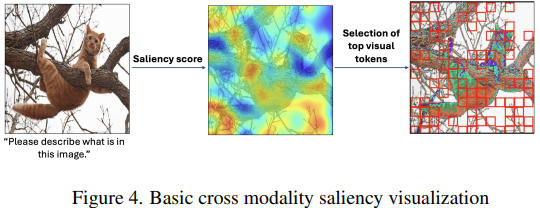
- Beyond 2:4: exploring V:N:M sparsity for efficient transformer inference on GPUs (https://arxiv.org/abs/2410.16135). This paper introduces and systematically studies V:N:M sparsity as a more efficient and flexible alternative to the industry-standard 2:4 sparsity for accelerating Transformer inference on GPUs. In the V:N:M approach, weight matrices are divided into V×M blocks; within each block, most columns are pruned, and 2:4 sparsity is then applied to the remaining columns. This scheme enables significantly higher and more adaptable sparsity ratios, while remaining compatible with existing GPU sparse tensor core acceleration. The authors propose a comprehensive framework for creating V:N:M-sparse Transformers: it features a heuristic method for selecting V and M values to optimize the accuracy-speedup trade-off, a V:N:M-specific channel permutation method for improving accuracy in low-budget training scenarios, and a three-stage LoRA training process for memory-efficient fine-tuning. Experimental results show that V:N:M-sparse Transformers can achieve much higher sparsity levels - such as 75% parameter reduction, while maintaining nearly lossless accuracy on downstream tasks, and outperform 2:4 sparsity in both speed and flexibility.

- TopV: Compatible Token Pruning with Inference Time Optimization for Fast and Low-Memory Multimodal Vision Language Model (https://arxiv.org/pdf/2503.18278v2). The authors introduce a training-free, optimization-based framework for reducing visual token redundancy in VLMs. Visual tokens often dominate the input sequence—up to 95% in some models. TopV addresses this by pruning unimportant visual tokens once during the prefilling stage, before decoding begins.Instead of relying on attention scores, TopV estimates the importance of each visual token by solving an optimal transport problem. In this setup: (1) Source tokens are the input visual tokens entering a specific transformer layer. (2) Target tokens are the output visual tokens after that layer has processed the input—specifically, the output after the Post-LN sub-layer. TopV calculates how much each input token contributes to the output using the Sinkhorn algorithm, guided by a cost function that considers: (1) How similar the tokens are in content (feature similarity), (2) How close they are in the image (spatial proximity), (3) How central they are in the image (centrality). To prevent visual collapse—especially in detail-sensitive tasks like OCR and captioning—TopV includes a lightweight recovery step. From the discarded tokens, TopV uniformly samples a subset at regular intervals (e.g., every 4th or 6th token) and reinserts them into the token sequence alongside the top-k tokens, ensuring spatial diversity and semantic coverage without significant overhead.TopV performs pruning once after the prompt and image are processed. The pruned visual token set remains fixed throughout decoding, enabling efficient and consistent inference.
- SparseVLM: Visual Token Sparsification for Efficient Vision-Language Model Inference (https://arxiv.org/pdf/2410.04417). SparseVLM introduces a lightweight, training-free framework for visual token sparsification in vision-language models (VLMs). Unlike text-agnostic approaches, it leverages cross-attention to identify text-relevant visual tokens (“raters”) and adaptively prunes others based on the rank of the attention matrix. Crucially, SparseVLM doesn’t discard all pruned tokens—instead, it recycles the most informative ones (those with high attention relevance scores). These are grouped using a density peak clustering algorithm, and each cluster is compressed into a single representative token. The reconstructed tokens are then reinserted into the model, replacing the larger set of pruned tokens with a compact, information-rich representation. Applied to LLaVA, SparseVLM achieves a 4.5× compression rate with only a 0.9% accuracy drop, reduces CUDA latency by 37%, and saves 67% memory. The code is available at https://github.com/Gumpest/SparseVLMs.
Other
- Hogwild! Inference: Parallel LLM Generation via Concurrent Attention (https://arxiv.org/pdf/2504.06261). Hogwild! Inference introduces a novel paradigm for parallel inference for reasoning tasks that departs significantly from prior structured approaches by enabling dynamic, parallel collaboration. The method runs multiple LLM "workers" concurrently, allowing them to interact in real-time through a shared Key-Value (KV) cache. This shared workspace lets workers see each other's progress as it happens, fostering emergent teamwork without rigid, pre-planned coordination. A key innovation is the efficient use of Rotary Position Embeddings (RoPE) to synchronize the workers' views of the shared cache with minimal computational overhead. Empirical results show significant wall-clock speedups—up to 3.6x with 4 workers—on complex reasoning tasks. This is achieved "out of the box" on existing models without requiring fine-tuning and can be stacked with another optimization methods such as speculative decoding. The technique fundamentally improves the speed-cost-quality trade-off for inference, shifting the paradigm from sequential "chains of thought" to collaborative "teams of thought". The code is available at https://github.com/eqimp/hogwild_llm.
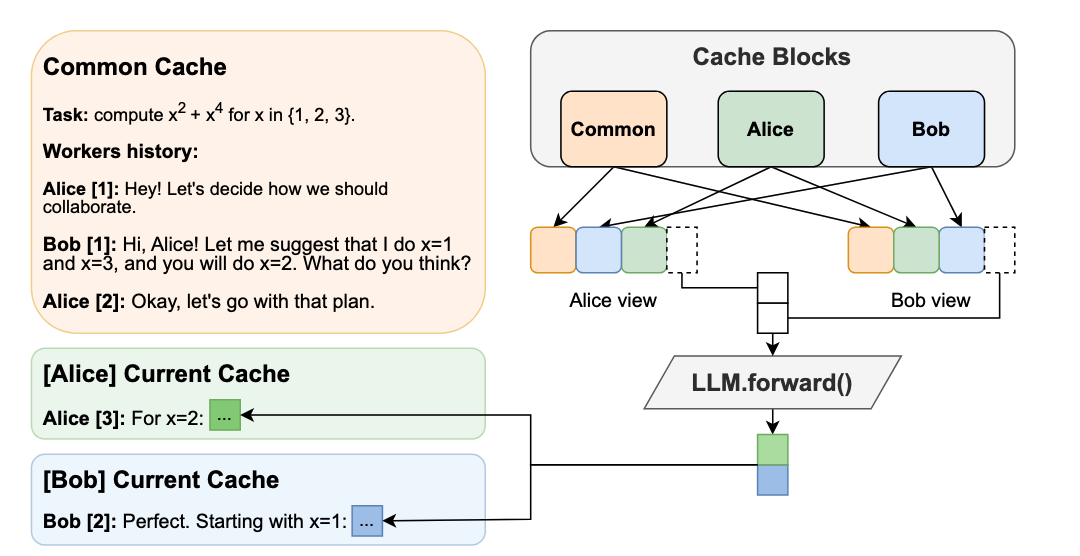
- Parallel Scaling Law for Language Models (https://arxiv.org/pdf/2505.10475). The authors introduce a novel "parallel" scaling method for LLMs (ParScale), distinct from traditional parameter (Dense, MoE) or inference-time (CoT) scaling. The technique processes a single input through 'P' parallel streams, each modified by a unique, learnable prefix vector. These streams are run concurrently on the same base model, and their outputs are intelligently aggregated by a small network. This method yields a quality improvement equivalent to increasing the model size by a factor of log(P), without actually expanding the core parameter count. For example, 8 parallel streams can match the performance of a model three times larger. ParScale is highly efficient for local inference, where memory bandwidth is the main bottleneck. Compared to direct parameter scaling for similar quality, it can require up to 22x less additional RAM and add 6x less latency. The approach can be applied for pretrained models, even with frozen weight, fine-tune only perscale components. The code is available at https://github.com/QwenLM/ParScale.
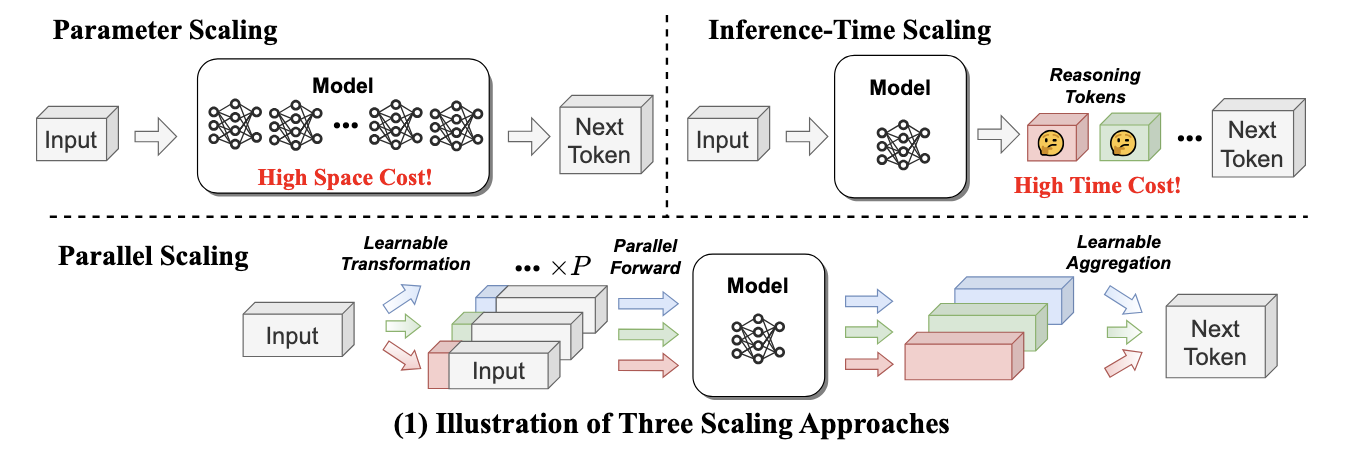
- Packing Input Frame Context in Next-Frame Prediction Models for Video Generation (https://arxiv.org/pdf/2504.12626). FramePack is a framework for next-frame prediction video generators that enables long-duration video synthesis with a constant computational cost (O(1)), regardless of length. It circumvents growing context windows by maintaining a fixed-size token buffer and codes input frames as shown in the figure below. To maintain temporal consistency and mitigate error accumulation, the system employs a bi-directional sampling scheme, alternating between forward and backward prediction passes. This efficiency allows a 13-billion parameter model to generate over 1800 frames (1 minute @ 30 fps) on a GPU with only 6GB of VRAM. The O(1) complexity in memory and latency makes FramePack a practical solution for generating minute-long videos on consumer hardware, with generation speeds of ~1.5 seconds per frame reported on an RTX 4090.The code is available at https://github.com/lllyasviel/FramePack.
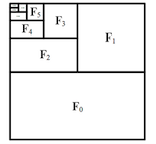
- MoDM: Efficient Serving for Image Generation via Mixture-of-Diffusion Models (https://arxiv.org/pdf/2503.11972). Diffusion-based text-to-image generation models trade latency for quality: small models are fast but generate lower quality images, while large models produce better images but are slow. This paper presents MoDM, a novel caching-based serving system for diffusion models that dynamically balances latency and quality through a mixture of diffusion models.Unlike prior approaches that rely on model-specific internal features, MoDM caches final images, allowing seamless retrieval and reuse across multiple diffusion model families.This design enables adaptive serving by dynamically balancing latency and image quality: using smaller models for cache-hit requests to reduce latency while reserving larger models for cache-miss requests to maintain quality. Small model image quality is preserved using retrieved cached images. MoDM has a global monitor that optimally allocates GPU resources and balances inference workload, ensuring high throughput while meeting Service-Level Objectives (SLOs) under varying request rates. Extensive evaluations show that MoDM significantly reduces an average serving time by 2.5× while retaining image quality, making it a practical solution for scalable and resource-efficient model deployment.
- Fast-dLLM: Training-free Acceleration of Diffusion LLM by Enabling KV Cache and Parallel Decoding (https://arxiv.org/abs/2505.22618). Fast-dLLM is a training-free method to accelerate diffusion-based large language models by introducing a block-wise KV Cache and confidence-aware parallel decoding. The block-wise KV Cache reuses more than 90% of attention activations with bidirectional (prefix and suffix) caching, delivering throughput improvements ranging from 8.1x to 27.6x while keeping accuracy loss under 2%. Confidence-aware parallel decoding selectively generates tokens that exceed a set confidence threshold (like 0.9), achieving up to 13.3x speedup and preserving output coherence thanks to theoretical guarantees. Experimentally, Fast-dLLM achieves up to 27.6× end-to-end speedup on 1024-token sequences (e.g., LLaDA, 8-shot) and keeps accuracy within 2% of the baseline across major reasoning and code benchmarks including GSM8K, MATH, HumanEval, and MBPP.
- SANA-Sprint: One-Step Diffusion with Continuous-Time Consistency Distillation (https://arxiv.org/pdf/2503.09641). SANA-Sprint is a highly efficient text-to-image diffusion model designed for ultra-fast generation. Its core innovation is a hybrid distillation framework that combines continuous-time consistency models (sCM) with latent adversarial diffusion distillation (LADD). This approach drastically reduces inference requirements from over 20 steps to just 1-4. Key performance benchmarks establish a new state-of-the-art. In a single step, SANA-Sprint generates a 1024x1024 image with FID of 7.59. This is achieved with a latency of just 0.1 seconds on an NVIDIA H100 GPU and 0.31 seconds on a consumer RTX 4090. This makes it approximately 10 times faster than its competitor, FLUX-schnell, while also delivering higher image quality.The code is available at https://github.com/NVlabs/Sana.
Software
- FlashRNN: I/O-Aware Optimization of Traditional RNNs on modern hardware (https://arxiv.org/abs/2412.07752). FlashRNN extends traditional RNNs - such as LSTMs and GRUs - by introducing a parallelization scheme where the hidden state is divided into multiple smaller blocks, allowing for parallel computation similar to the head-wise processing in Transformers. The authors develop and open-source custom fused CUDA and Triton kernels that leverage the GPU memory hierarchy efficiently for both forward and backward passes, together with an automatic hardware-aware optimization framework. This approach achieves up to 50x speedup over vanilla PyTorch implementations, making RNNs competitive with Transformer-like models on modern GPUs. The code is available at: https://github.com/NX-AI/flashrnn.
- Nano-vLLM (https://github.com/GeeeekExplorer/nano-vllm). A lightweight vLLM implementation built from scratch.Key Features: (1)🚀 Fast offline inference - Comparable inference speeds to vLLM (2)📖 Readable codebase - Clean implementation in ~ 1,200 lines of Python code (3)⚡ Optimization Suite - Prefix caching, Tensor Parallelism, Torch compilation, CUDA graph, etc.
- NeMo-Inspector: A Visualization Tool for LLM Generation Analysis (https://arxiv.org/pdf/2505.00903). The authors introduce NeMo-Inspector, an open-source tool designed to simplify the analysis of synthetic datasets with integrated inference capabilities.
- FlashInfer: Efficient and Customizable Attention Engine for LLM Inference Serving (https://arxiv.org/pdf/2501.01005). The authors present FlashInfer: a customizable and efficient attention engine for LLM serving. FlashInfer tackles KV-cache storage heterogeneityusing block-sparse format and composable formats to optimize memory access and reduce redundancy, supports JIT compilation and load-balanced scheduling algorithm adjusts to dynamism of user requests while maintaining compatibility with CUDAGraph which requires static configuration. FlashInfer achieve29-69% inter-token-latency reduction compared to Triton, 28-30% latency reduction for long-context inference, and 13-17% speedup for LLM serving with parallel generation.The code is available at https://github.com/flashinfer-ai/flashinfer.
Dynamic quantization support from GPU with XMX
Scope of this document
This article explains the behavior of dynamic quantization on GPUs with XMX, such as Lunar Lake, Arrow lake and discrete GPU family(Alchemist, Battlemage).
It does not cover CPUs or GPUs without XMX(such as Meteor Lake). While the dynamic quantization is supported on these platforms as well, the behavior may differ slightly.
What is dynamic quantization?
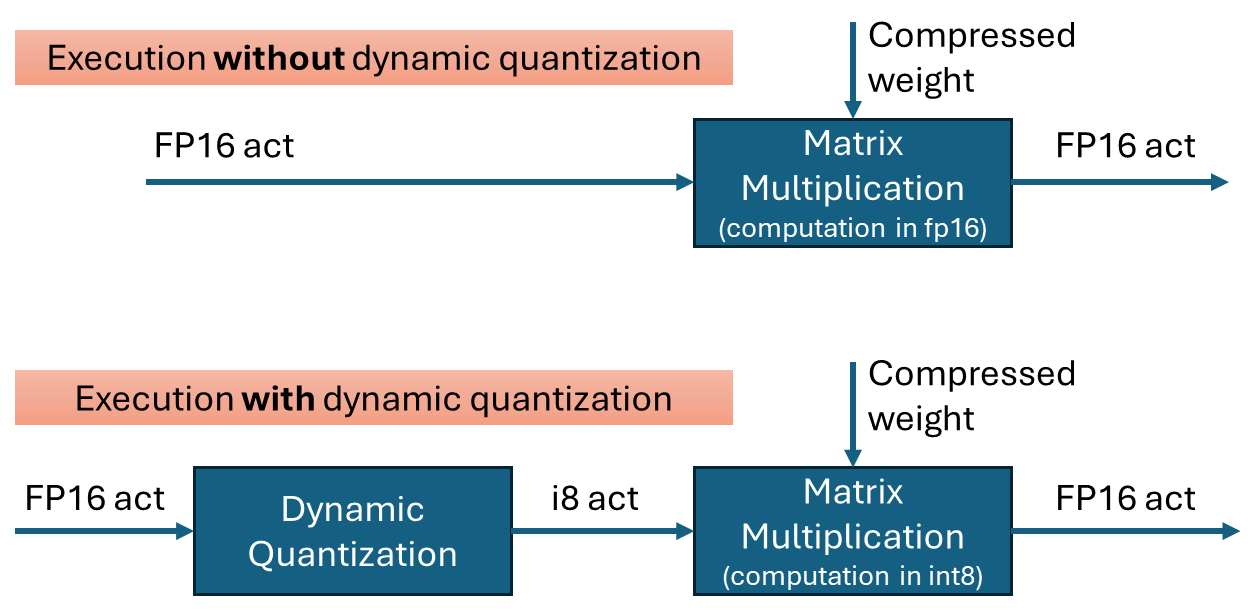
Dynamic quantization is a technique to improve the performance of transformer networks by quantizing the inputs to matrix multiplications. It is effective when weights are already quantized into int4 or int8. By performing the multiplication in int8 instead of fp16, computations can be executed faster with minimal loss in accuracy.
To perform quantization, the data is grouped, and the minimum and maximum values within each group are used to calculate the scale(and zero-point) for quantization. In OpenVINO’s dynamic quantization, this grouping occurs along the embedding axis (i.e., the innermost axis). The group size is configurable, as it impacts both performance and accuracy.
Default behavior on GPU with XMX for OpenVINO 2025.2
In the OpenVINO 2025.2 release, dynamic quantization is enabled by default for GPUs with XMX support. When a model contains a suitable matrix multiplication layer, OpenVINO automatically inserts a dynamic quantization layer before the MatMul operation. No additional configuration is required to activate dynamic quantization.
By default, dynamic quantization is applied per-token, meaning a unique scale value is generated for each token. This per-token granularity is chosen to maximize performance benefits.
However, dynamic quantization is applied conditionally based on input characteristics. Specifically, it is not applied when the token length is short—64 tokens or fewer.(That is, the row size of the matrix multiplication)
For example:
-If you run a large language model (LLM) with a short input prompt (≤ 64 tokens), dynamic quantization is disabled.
-If the prompt exceeds 64 tokens, dynamic quantization is enabled and may improve performance.
Note: Even in the long-input case, the second token is currently not dynamically quantized because row-size in matrix multiplication is small with KV cache.
Performance and Accuracy Impact
The impact of dynamic quantization on performance and accuracy can vary depending on the target model.
Performance
In general, dynamic quantization is expected to improve the performance of transformer models, including large language models (LLMs) with long input sequences—often by several tens of percent. However, the actual gain depends on several factors:
-Low MatMul Contribution: If the MatMul operation constitutes only a small portion of the model's total execution time, the performance benefit will be limited. For instance, in very long-context inputs, scaled-dot-product-attention may dominate the runtime, reducing the relative impact of MatMul optimization.
-Short Token Lengths: Performance gains diminish with shorter token lengths. While dynamic quantization improves compute efficiency, shorter inputs tend to be dominated by weight I/O overhead rather than compute cost.
Accuracy
Accuracy was evaluated using an internal test set and found to be within acceptable limits. However, depending on the model and workload, users may observe noticeable accuracy degradation.
If accuracy is a concern, you may:
-Disable dynamic quantization, or
-Use a smaller group size (e.g., 256), which can improve accuracy at some cost to performance.
How to Verify If dynamic quantization is Enabled on GPU with XMX
Since dynamic quantization occurs automatically under the hood, you may want to verify whether it is active. There are two main methods to check:
-Execution graph (exec-graph): The transformed graph generated by OpenVINO will include an additional "dynamic_quantize" layer if dynamic quantization is applied. You can inspect this by dumping the execution graph using the benchmark_app tool, assuming your model can be run with it. Please see the documentation for details: https://docs.openvino.ai/nightly/get-started/learn-openvino/openvino-samples/benchmark-tool.html
-Opencl-intercept-layer: You can view the list of executed kernels using the opencl-intercept-layer. Both call logging and device performance timing modes will show the "dynamic_quantize" kernel if it is executed. https://github.com/intel/opencl-intercept-layer
GraphTransformation with Dynamic Quantization
When dynamic quantization is enabled (i.e., dynamic_quantization_group_size != 0), a dynamic_quantize node is inserted before the target matrix multiplication nodes. (See the diagram above) Since the input length for LLMs is only known at inference time, the execution path is determined dynamically. If the input length is short (≤ 64 tokens), the dynamic_quantize node is skipped. For longer inputs, the node is executed to apply quantization.
If dynamic quantization is disabled (dynamic_quantization_group_size == 0), the dynamic_quantize node is not added to the graph at all.
Related properties
-dynamic_quantization_group_size: Sets the group size for dynamic quantization. In OpenVINO 2025.2, for GPUs with XMX, the default value is UINT64_MAX, which corresponds to per-token quantization.
For instructions on setting this property, please refer to: https://docs.openvino.ai/2025/openvino-workflow-generative/inference-with-optimum-intel.html#enabling-openvino-runtime-optimization
-OV_GPU_ASYM_DYNAMIC_QUANTIZATION: Enables asymmetric dynamic quantization. This means that in addition to the scale, a zero-point value is also computed during quantization. This setting is configured via an environment variable.
-OV_GPU_DYNAMIC_QUANTIZATION_THRESHOLD: Defines the minimum token length (or row size of the matrix) required to apply dynamic quantization. If the input token length is less than or equal to this value, dynamic quantization is not applied.
The default value is 64.
This setting can also be configured via an environment variable.
Dynamic shapes support in OpenVINO JIT compiler boosts inference performance by 40%
Authors: Ivan Novoselov, Alexandra Sidorova, Vladislav Golubev, Dmitry Gorokhov
Introduction
Deep learning (DL) has become a powerful tool for addressing challenges in various domains like computer vision, generative AI, and natural language processing. Industrial applications of deep learning often require performing inference in resource-constrained environments or in real time. That’s why it’s essential to optimize inference of DL models for particular use cases, such as low-latency, high-throughput or low-memory environments. Thankfully, there are several frameworks designed to make this easier, and OpenVINO stands out as a powerful tool for achieving these goals.
OpenVINO is an open-source toolkit for optimization and deployment of DL models. It demonstrates top-tier performance across a variety of hardware including CPU (x64, ARM), AI accelerators (Intel NPU) and Intel GPUs. OpenVINO supports models from popular AI frameworks and delivers out-of-the box performance improvements for diverse applications (you are welcome to explore demo notebooks). With ongoing development and a rapidly growing community, OpenVINO continues to evolve as a versatile solution for high-performance AI deployments.
The primary objective of OpenVINO is to maximize performance for a given DL model. To do that, OpenVINO applies a set of hardware-dependent optimizations The optimizations are typically performed by replacing a target group of operations with a custom operation that can be executed more efficiently. In the standard approach, these custom operations are executed using handcrafted implementations. This approach is highly effective when optimizing a few patterns of operations. On the other hand, it lacks scalability and thus requires too much effort when dozens of similar patterns should be supported.
To address this limitation and build a more flexible optimization engine, OpenVINO introduced Snippets, an integrated Just-In-Time (JIT) compiler for computational graphs. Snippets provide a flexible and scalable approach for operation fusions and enablement. The graph compiler automatically identifies subgraphs of operations that can benefit from fusion and combines them into a single node, referred to as “Subgraph”. Snippets then apply a series of optimizing transformations to the subgraph and JIT compile an executable that efficiently performs the computations defined by the subgraph.
One of the most common examples of such subgraphs is Scaled Dot-Product Attention (SDPA) pattern. SDPA it is a cornerstone of transformer-based architectures which dominate most of the state-of-the-art models. There are numerous SDPA pattern flavours and variations dictated by model-specific adjustments or optimizations. Thanks to compiler-based design, Snippets support most of these configurations. Fig. 1 illustrates the general structure of the SDPA pattern supported by Snippets, highlighting its adaptability to different model requirements:
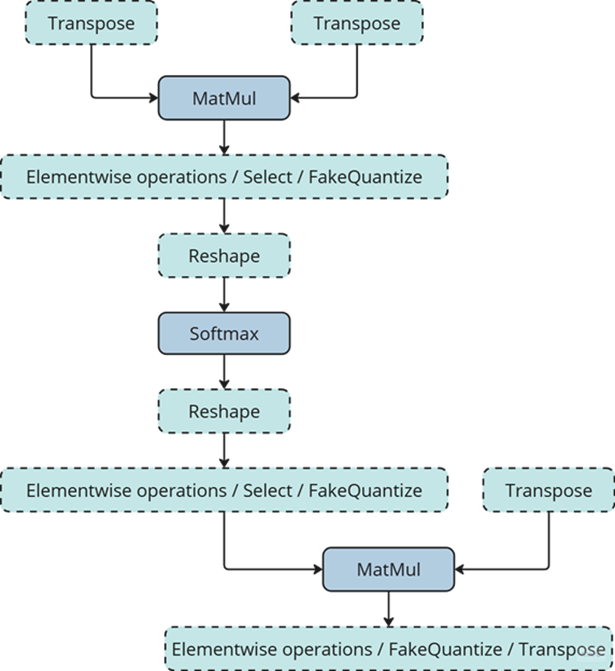
Note that SDPA has quadratic time and memory complexity with respect to sequence length. It means that by fusing SDPA-like patterns, Snippets significantly reduce memory consumption and accelerate transformer models, especially for large sequence lengths.
Snippets effectively optimized SDPA patterns but had a key limitation: they did not support dynamic shapes. In other words, input shapes must be known at the model compilation stage and can’t be changed in runtime. This limitation reduced the applicability of Snippets to many real-world scenarios where input shapes are not known in advance. While it is technically possible to JIT-compile a new binary for each unique set of input shapes, this approach introduces significant recompilation overheads, often negating the performance gains from SDPA fusion.
Fortunately, this static-shape limitation is not inherent to Snippets design. They can be modified to support dynamic shapes internally and generate shape-agnostic binaries. In this post, we discuss Snippets architecture and the challenges we faced during this dynamism enablement.
Architecture
The first step of the Snippets pipeline is called Tokenization. It is applied to an ov::Model, which represents OpenVINO Intermediate Representation (IR). It’s a standard IR in the OV Runtime you can read more about it here or here. The purpose of this stage is to identify parts of the initial model that can be lowered by Snippets efficiently. We are not going to discuss Tokenization in detail because this article is mostly focused on the dynamism implementation. A more in-depth description of the Tokenization process can be found in the Snippets design guide. The key takeaway for us here is that the subsequent lowering is performed on a part of the initial ov::Model. We will call this part Subgraph, and the Subgraph at first is also represented as an ov::Model.
Now let’s have a look at the lowering pipeline, its schematic representation is shown on Fig.2a. As can be seen from the picture, the lowering process consists of three main phases: Data Flow Optimizations, Control Flow Optimizations and Binary Code Generation. Let’s briefly discuss each of them.
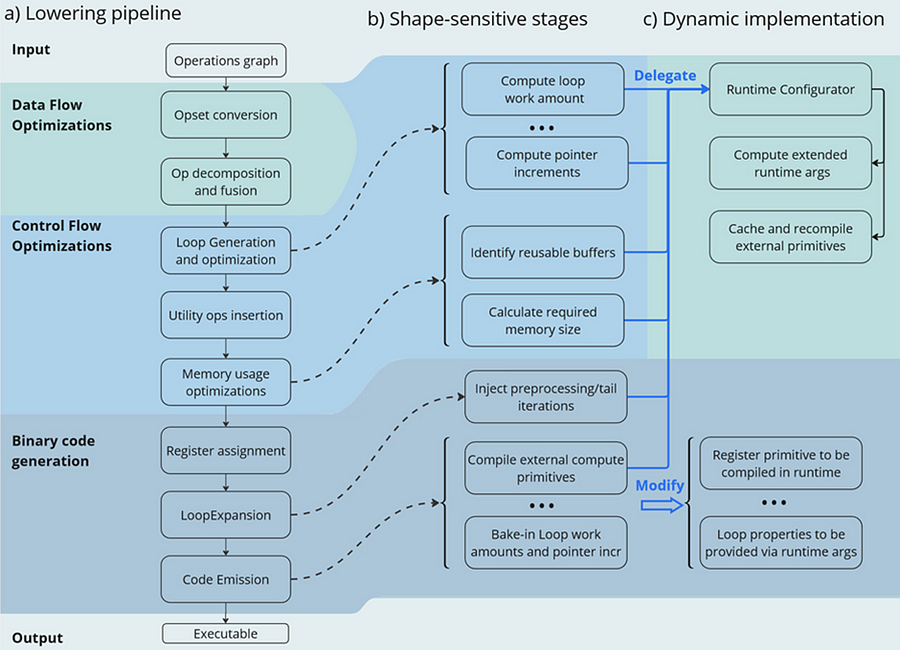
Lowering Pipeline
The first stage is the Data Flow optimizations. As we mentioned above, this stage’s input is a part of the initial model represented as an ov::Model. This representation is very convenient for high-level transformations such as opset conversion, operations’ fusion/decomposition and precision propagation. Here are some examples of the transformations performed on this stage:
- ConvertPowerToPowerStatic — operation Power with scalar exponent input is converted to PowerStatic operation from the Snippets opset. The PowerStatic ops then use the values of the exponents to produce more optimal code.
- FuseTransposeBrgemm — Transpose operations that can be executed in-place with Brgemm blocks are fused into the Brgemm operations.
- PrecisionPropagation pass automatically inserts Converts operations between the operations that don’t natively support the desired execution precision.
The next stage of the lowering process is Control Flow optimizations (or simply CFOs). Note that the ov::Model is designed to primarily describe data flow, so is not very convenient for CFOs. Therefore, we had to develop our own IR (called Linear IR or simply LIR) that explicitly represents both control and data flows, you can read more about LIR here. So the ov::Model IR is converted to LIR before the start of the CFOs.
As you can see from the Fig.2a, the Control Flow optimization pipeline could roughly be divided into three main blocks. The first one is called Loop Generation and Optimization. This block includes all loop-related optimizations such as automatic generation of loops based on the input tensors’ dimensions, loop fusion and blocking loops generation.
The second block of Control Flow optimizations is called Utility Ops Insertion. We need this block of transformations here to insert utility operations that depend on loop control structures, specifically on their entry and exit points locations. For example, operations like Load, Store, MemoryBuffer, LoopBegin and LoopEnd are inserted during this stage.
The last step of CFO is the Memory Usage Optimizations block. These transformations determine required sizes of internal memory buffers, and analyze how much of that memory can be reused. A graph coloring algorithm is employed to minimize memory consumption.
Now all Control Flow optimizations are performed, and we are ready to proceed to the next stage of the lowering pipeline — Binary Code Generation (BCG). As one can see from Fig.2a, this stage consists of three substages. The first one is Register Assignment. We use a fairly standard approach here: calculate live intervals first and use the linear scan algorithm to assign abstract registers that are later mapped to physical ones.
The next BSG substage is Loop Expansion. To better understand its purpose, let’s switch gears for a second and think about loops in general. Sometimes it’s necessary to process the first or the last iteration of a loop in a special way. For example, to initialize a variable or to process blocking loops’ tails. The Loop Expansion pass unrolls these special iterations (usually the first or the last one) and explicitly injects them into the IR. This is needed to facilitate subsequent code emission.
The final step of the BCG stage is Code Emission. At this stage, every operation in our IR is mapped to a binary code emitter, which is then used to produce a piece of executable code. As a result, we produce an executable that performs calculations described by the initial input ov::Model.
Dynamic Shapes Support
Note that some stages of the lowering pipeline are inherently shape-sensitive, i.e. they rely on specific values of input shapes to perform optimizations. These stages are schematically depicted on the Fig. 2b.
As can be seen from the picture, shapes are used to determine loops’ work amounts and pointer increments that should be performed on every iteration. These parameters are later baked into the executable during Code Emission. Another example is Memory Usage Optimizations, since input shapes are needed to calculate memory consumption. Loop Expansion also relies on input shapes, since it needs to understand if tail processing is required for a particular loop. Note also that Snippets use compute primitives from third-party libraries, BRGEMM block from OneDNN for example. These primitives should as well be compiled with appropriate parameters that are also shape-sensitive.
One way to address these challenges is to rerun the lowering pipeline for every new set of input shapes, and to employ caching to avoid processing the same shapes twice. However, preliminary analysis indicated that this approach is too slow. Since this re-lowering needs to be performed in runtime, the performance benefit provided by Snippets is essentially eliminated by the recompilation overheads.
The performed experiments thus indicate that we can afford to run the whole lowering pipeline only once during the model compilation stage. Only some minor adjustments can be made at runtime. In other words, we need to remove all shape-sensitive logic from the lowering pipeline and perform the compilation without it. The remaining shape-sensitive transformations should be performed at runtime. Of course, we would also need to share this runtime context with the compiled shape-agnostic kernel. The idea behind this approach is schematically represented on Fig. 2c.
As one can see from the picture, all the shape-sensitive transformations are now performed by a new entity called Runtime Configurator. It’s probably easier to understand its purpose in some examples.
Imagine that we need to perform a unary operation get_result(X) on an input tensor X — for example, apply an activation function. To do this, we need to load some input data from memory into registers, perform the necessary computations and write the results back to memory. Of course this read-compute-write sequence should be done in a loop since we need to process the entire input tensor. These steps are described in more detail in Fig. 3 using pseudocode. Fig. 3a corresponds to a static kernel while Fig. 3b represents a dynamic one.
Let’s consider the static kernel as a starting point. As the first step, we need to load pointers to input and output memory blobs to general-purpose registers (or simply GPRs) denoted G_IN and G_OUT on the picture. Then we initialize another GPR that stores the loop work amount (G_WA). Note that the loop is used to traverse the input tensor, so the loop’s work amount is fixed because the tensor’s dimensions are also known at the BCG stage. The next six steps in the picture (3 to 8) are in the loop’s body.
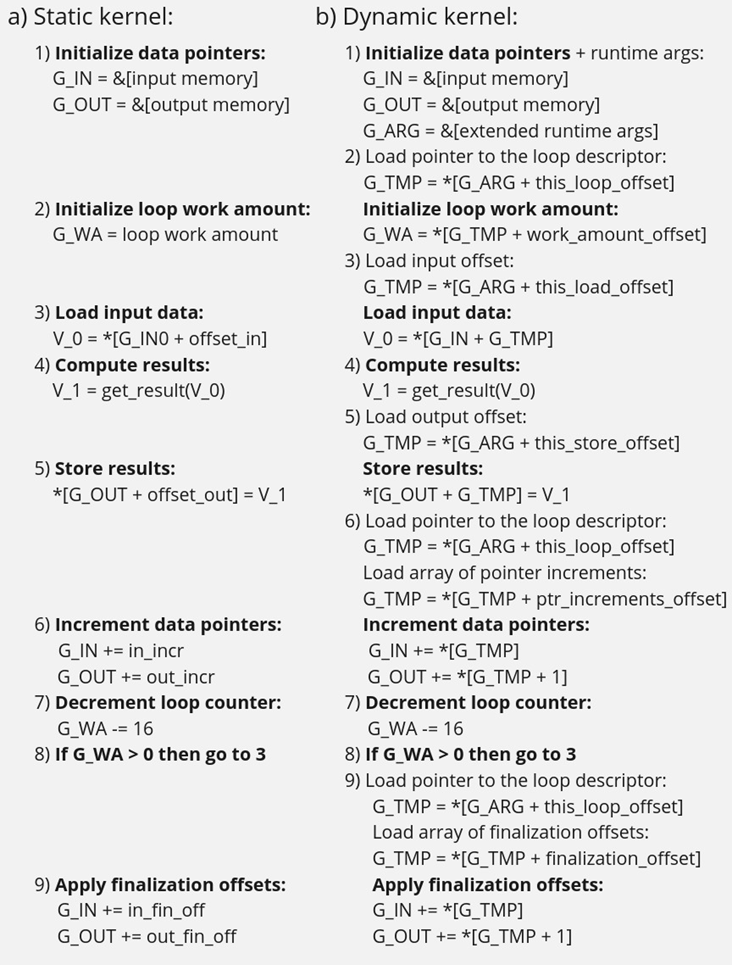
In step 3, we load input data into a vector register V_0, note that the appropriate pointer is already loaded to G_IN, and offset_in is fixed because the input tensor is static. Next, we apply our get_result function to the data in V_0 and place the result in a spare vector register V_1. Now we need to store V_1 back to memory, which is done on step 5. Note that offset_out is also known in the static case. This brings us almost to the end of the loop’s body, and the last few things we need to do are to increment data pointers (step 6), decrement loop counter (step 7), and jump to the beginning of the body, if needed (step 8).
Finally, we need to reset data pointers to their initial values after the loop is finished, which is done using finalization offsets on step 9. Note that this step could be omitted in our simplified example, but it’s often needed for more complicated use cases, such as when the data pointers are used by subsequent loops.
Now that we understand the static kernel, let’s consider the dynamic one, which is shown in Fig. 3b. Unsurprisingly, the dynamic kernel performs essentially the same steps as the static one, but with additional overhead due to loading shape-dependent parameters from the extended runtime arguments. Take step 1 as an example, we need to load not only memory pointers (to G_IN and G_OUT), but also a pointer to the runtime arguments prepared by the runtime configurator (to G_ARG).
Next, we need to load a pointer to the appropriate loop descriptor (a structure that stores loops’ parameters) to a temporary register G_TMP, and only then we can initialize the loop’s work amount register G_WA (step 2). Similarly, in order to load data to V_0, we need to load a runtime-calculated offset from the runtime arguments in step 3. The computations in step 4 are the same as in the static case, since they don’t depend on the input shapes. Storing the results to memory (step 5) requires reading a dynamic offset from the runtime arguments again. Next, we need to shift the data pointers, and again we have to load the increments from the corresponding loop descriptor in G_ARG because they are also shape-dependent, as the input tensor can be strided. The following two steps 7 and 8 are the same as in the static case, but the finalization offsets are also dynamic, so we have to load them from G_ARG yet again.
As one can see from Fig. 3, dynamic kernels incorporate additional overhead due to reading the extended runtime parameters provided by the runtime configurator. However, this overhead could be acceptable as long as the input tensor is large enough (Load/Store operations would take much longer than reading runtime arguments from L1) and the amount of computation is sufficient (get_results is much larger than the overhead). Let’s consider the performance of this design in the Results section to see if these conditions are met in practical use cases.
Results
We selected three platforms to evaluate the dynamic pipeline’s performance in Snippets. These platforms represent different market segments: the Intel Core machine is designed for high-performance user and professional tasks. While the Intel Xeon is a good example of enterprise-level hardware often used in data centers and cloud computing applications. The information about the platforms is described in the table below:
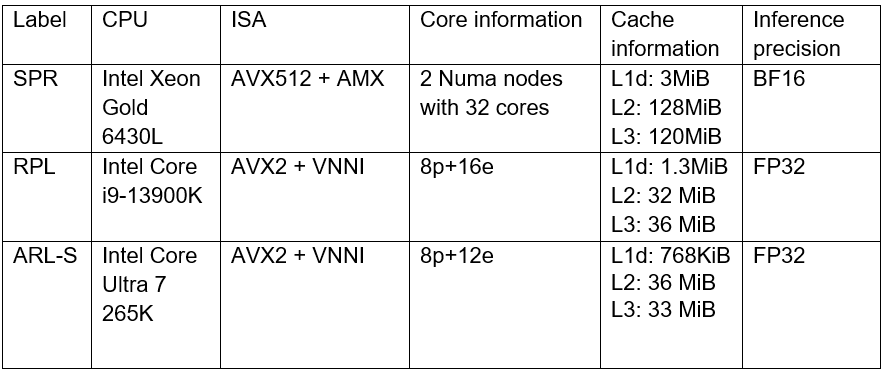
As discussed in the Introduction, Snippets support various SDPA-like patterns which form the backbone of Transformer models. These models often work with input data of arbitrary size (for example, sequence length in NLP). Thus, dynamic shapes support in Snippets can efficiently accelerate many models based on Transformer architecture with dynamic inputs.
We selected 43 different Transformer-models from HuggingFace to measure how the enablement of dynamic pipeline in Snippets affects performance. The models were downloaded and converted to OpenVINO IRs using Optimum Intel. These models represent different domains and were designed to solve various tasks in natural language processing, text-to-image image generation and speech recognition (see full model list at the end of the article). What unifies all these models is that they all contain SDPA subgraph and thus can be accelerated by Snippets.
Let’s take a closer look at the selected models. The 37 models of them solve different tasks in natural language processing. Their performance was evaluated using a list of 2000 text sequences with different lengths, which also mimics the real-word scenario. The total processing time of all the sequences were measured in every experiment. Note that the text sequences were converted to model inputs using model-specific tokenizers prior to the benchmarking. The lengths’ distribution of the tokenized sequences is shown on Fig. 4. As can be seen from the picture, the distribution is close to normal with the mean length of 31 tokens.
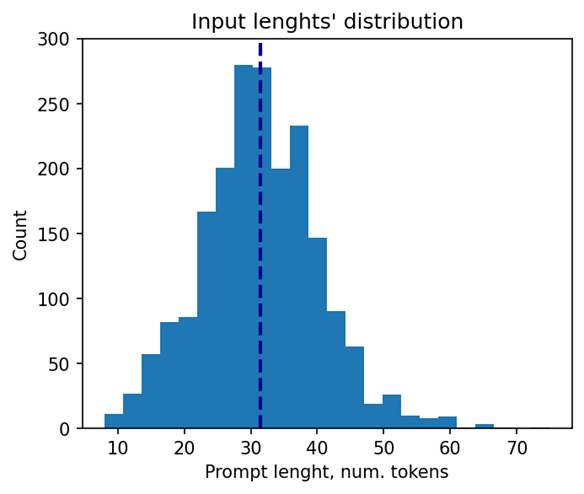
The other 6 models of the selected model scope solve tasks in text-to-image image generation (Stable Diffusion) and speech recognition (Whisper). These models decompose into several smaller models after export to OpenVINO representation using Optimum Intel. Stable Diffusion topology is decomposed into Encoder, Diffuser and Decoder. The most interesting model here is Diffuser because it’s the one responsible for denoising of the latent image representation. This generation stage is repeated several times, so it is the most computationally intensive, which mostly effects on the generation time of the image. Whisper is also decomposed into Encoder and Decoder, which also contain SDPA patterns. The Encoder encodes the spectrogram from the feature extractor to form a sequence of encoder hidden states. Then, the decoder autoregressively predicts text tokens, conditional on both the previous tokens and the encoder hidden states. Currently, Snippets support efficient execution of SDPA only in Whisper Encoder, while Decoder is a subject for future support. To evaluate the inference performance of Stable Diffusion and Whisper models, we collect generation time of image/speech using LLM Benchmark from openvino.genai. This script provides a unified approach to estimate performance for GenAI workloads in OpenVINO.
Performance Improvements
Note that the main goal of these experiments is to estimate the impact of Snippets on the performance of the dynamic pipeline. To do that, we performed two series of experiments for every model. The first version of experiments is with disabled Snippets tokenization. In this case, all operations from the SDPA pattern are performed on the CPU plugin side as stand-alone operations. The second variant of experiments — with enabled Snippets tokenization. The relative difference between numbers collected on these two series of experiments is our performance metric — speedup, the higher the better. Firstly, let’s take a closer look at the resulting speedups for the BERT models which are depicted on Fig. 5.
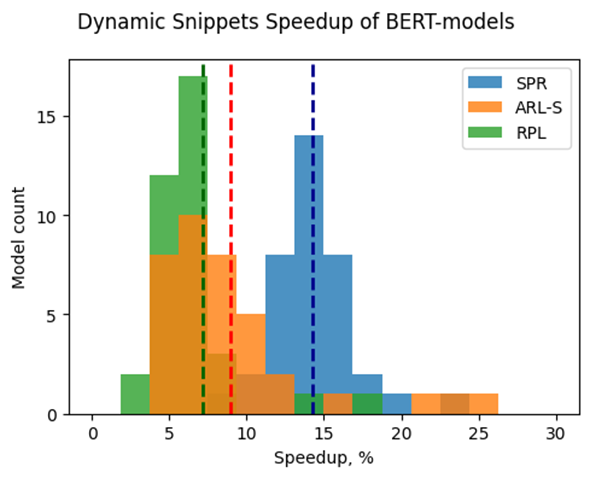
The speedups on RPL range from 3 to 18%, while on average the models are accelerated by 7%. The ARL-S speedups are somewhat higher and reach 20–25% for some models, the average acceleration factor is around 9%. The most affected platform is SPR, it has the highest average speedup of 15 %.
One can easily see from these numbers that both average and maximum speedups depend on the platform. To understand the reason for this variation, we should recall that the main optimizations delivered by Snippets are vertical fusion and tiling. These optimizations improve cache locality and reduce the memory access overheads. Note SPR has the largest caches among the examined platforms. It also uses BF16 precision that takes two times less space per data element compared to F32 used on ARL-S and RPL. Finally, SPR has AMX ISA extension that allows it to perform matrix multiplications much faster. As a result, SDPA execution was more memory bound on SPR, so this platform benefited the most from the Snippets enablement. At the same time, the model speedups on ARL-S and RPL are almost on the same level. These platforms use FP32 inference precision while SPR uses BF16, and they have less cache size than SPR.

Now, let’s consider Stable Diffusion and Whisper topologies and compare their speedups with some of BERT-like models. As can be seen from the Fig. 6, the most accelerated Stable Diffusion topology is StableDiffusion-3-medium — almost 33% on ARL-S and 40% on SPR. The most accelerated model in this Stable Diffusion pipeline is Diffuser. This model has made a great contribution to speeding up the entire image generation time. The reason the Diffuser benefits more from Snippets enablement is that they use larger sequence lengths and embedding sizes. It means that their attention blocks process more data and are more memory constrained compared to BERT-like models. As a result, the Diffuser models in Stable Diffusion benefit more from the increased cache locality provided by Snippets. This effect is more pronounced on the SPR than on the ARL-S and RPL for the reasons discussed above (cache sizes, BF16, AMX).
The second most accelerated model is whisper-large-v3–30% on SPR. This model has more parameters than base and tiny models and process more Mel spectrogram frequency bins than they. It means that Encoder of whisper-large-v3 attention blocks processes more data, like Diffuser part of Stable Diffusion topologies. By the same reasons, whisper-large-v3 benefits more (increased cache locality provided by Snippets).
Memory Consumption Improvements
Another important improvement from Snippets using is reduction of memory consumption. Snippets use vertical fusion and various optimizations from Memory Usage Optimizations block (see the paragraph “Lowering Pipeline” in “Architecture” above for more details). Due to this fact, Subgraphs tokenized by Snippets consumes less memory than the same operations performed as stand-alone in CPU Plugin.
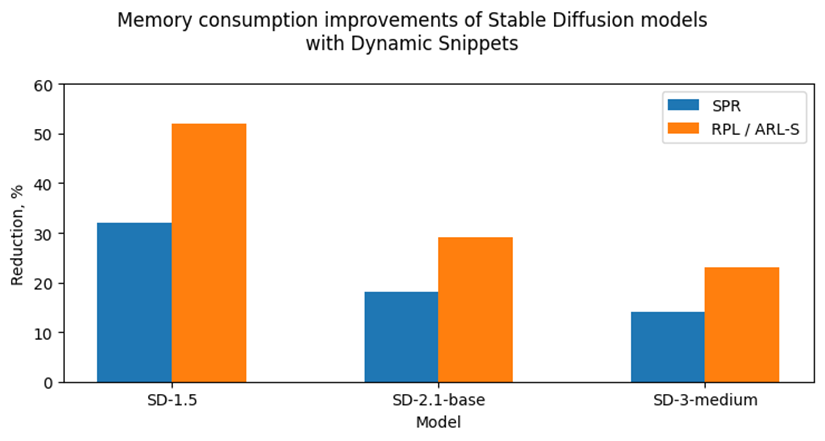
Let’s take a look at the Fig. 7 where we can see improvements in image generation memory consumption using Stable Diffusion pipelines from Snippets usage. As discussed above, the attention blocks in the Diffuser models from these pipelines process more data and consume more memory. Because of that, the greatest impact on memory consumption from using Snippets is seen on Stable Diffusion pipelines. For example, memory consumption of image generation is reduced by 25–50% on RPL and ARL-S platforms with FP32 inference precision and by 15–30% on SPR with BF16 inference precision.
Thus, one of the major improvements from using Snippets is memory consumption reduction. It allows extending the range of platforms which are capable to infer such memory-intensive models as Stable Diffusion.
Conclusion
Snippets is a JIT compiler used by OpenVINO to optimize performance-critical subgraphs. We briefly discussed Snippets’ lowering pipeline and the modifications made to enable dynamism support. After these changes, Snippets generate shape-agnostic kernels that can be used for various input shapes without recompilation.
This design was tested on realistic use cases across several platforms. As a result, we demonstrate that Snippets can accelerate BERT-like models by up to 25%, Stable Diffusion and Whisper pipelines up to 40%. Additionally, Snippets can significantly reduce memory consumption by several tens of percent. Notably, these improvements result from more optimal hardware utilization, so the models’ accuracy remains unaffected.
References
Model list can be found here: https://gist.github.com/a-sidorova/2c2aa584922389138e5ccbad0e0c773b
Intel Xeon Gold 6430L: https://www.intel.com/content/www/us/en/products/sku/231737/intel-xeon-gold-6430-processor-60m-cache-2-10-ghz/specifications.html
Intel Core i9-13900K: https://www.intel.com/content/www/us/en/products/sku/230496/intel-core-i913900k-processor-36m-cache-up-to-5-80-ghz/specifications.html
Intel Core Ultra 7 265K: https://www.intel.com/content/www/us/en/products/sku/241063/intel-core-ultra-7-processor-265k-30m-cache-up-to-5-50-ghz/specifications.html
Notices & Disclaimers
Performance varies by use, configuration, and other factors. Learn more on the Performance Index site.
No product or component can be absolutely secure. Your costs and results may vary. Intel technologies may require enabled hardware, software or service activation.
© Intel Corporation. Intel, the Intel logo, and other Intel marks are trademarks of Intel Corporation or its subsidiaries.
Q1'25: Technology Update – Low Precision and Model Optimization
Authors
Alexander Kozlov, Nikolay Lyalyushkin, Nikita Savelyev, Souvikk Kundu, Andrey Anufriev, Pablo Munoz, Alexander Suslov, Liubov Talamanova, Daniil Lyakhov, Yury Gorbachev, Nilesh Jain, Maxim Proshin, Evangelos Georganas
Summary
This quarter we noticed a significant effort and progress on optimizing LLMs for long-context tasks. The current trend is that each and every LLM is published with the extended (usually interpolated) context which is usually 128K and above. The idea is to naturally process large amount of data within the model instead of preprocess it the way RAG systems do it. It inevitably increases computational complexity specifically of ScaledDotProductAttention operation which gets dominant on long contexts. Thus, many works devoted to the optimization of rather prefill with special computation patterns (A-shape, Tri-shape, XAttention) or using Sparse Attention at the decoding stage.
Highlights
- ParetoQ: Scaling Laws in Extremely Low-bit LLM Quantization by Meta (https://arxiv.org/pdf/2502.02631). The paper presents a unified framework that facilitates comparisons across 1-bit, 1.58-bit, 2-bit, 3-bit, and 4-bit quantization settings. The findings reveal a notable learning transition between 2 and 3 bits: For 3-bits and above, the fine-tuned models stay close to their original pre-trained distributions, whereas for learning 2-bit networks or below, the representations change drastically. By optimizing training schemes and refining quantization functions, the ternary 600M-parameter model even outperforms the previous SoTA ternary 3B-parameter model in accuracy, using only one-fifth of the parameters.
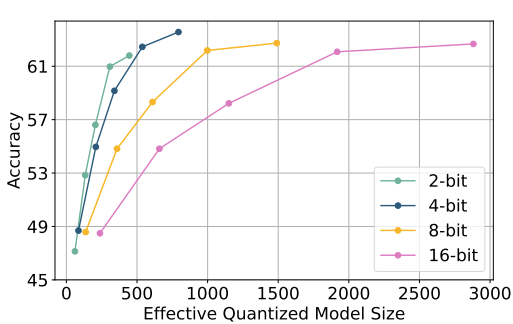
- QuEST: Stable Training of LLMs with 1-Bit Weights and Activations by ISTA and Red Hat AI (https://arxiv.org/pdf/2502.05003). The paper introduces quantization method that allows stable training with 1-bit weights and activations. It achieves this by improving two key aspects of QAT methods: (1) accurate and fast quantization of the (continuous) distributions of weights and activations via Hadamard normalization and MSE-optimal fitting; (2) a new trust gradient estimator based on the idea of explicitly minimizing the error between the noisy gradient computed over quantized states and the “true” (but unknown) full-precision gradient. Experiments on Llama-type architectures show that the method induces stable scaling laws across the entire range of hardware-supported precisions, and can be extended to sparse representations. The code is available at https://github.com/IST-DASLab/QuEST.
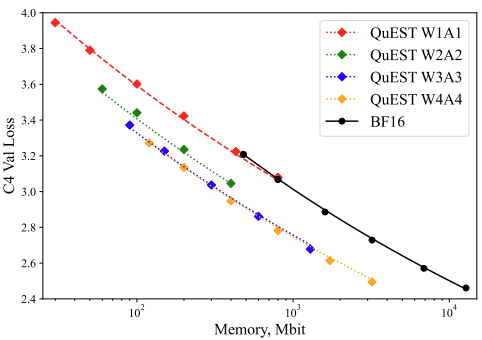
- Native Sparse Attention: Hardware-Aligned and Natively Trainable Sparse Attention by Deepseek-AI, Peking University, University of Washington (https://arxiv.org/pdf/2502.11089). The paper presents a method with hardware-aligned optimizations to achieve efficient long-context modeling. It employs a dynamic hierarchical sparse strategy, combining coarse-grained token compression with fine-grained token selection to preserve both global context awareness and local precision. The approach advances sparse attention design with two key features: (1) Authors achieve substantial speedups through arithmetic intensity-balanced algorithm design, with implementation optimizations for modern hardware. (2) They enable end-to-end training, reducing pretraining computation without sacrificing model performance. Experiments show the model pretrained with the proposed method maintains or exceeds Full Attention models across general benchmarks, long-context tasks, and instruction-based reasoning. It achieves substantial speedups over Full Attention on 64k-length sequences across decoding, forward propagation, and backward propagation. Non-official implementations are available on GitHub.

- LSERVE: EFFICIENT LONG-SEQUENCE LLM SERVING WITH UNIFIED SPARSE ATTENTION by MIT, SJTU, Nvidia (https://arxiv.org/pdf/2502.14866). The paper introduces a system that accelerates long-sequence LLM serving via hybrid sparse attention. This method unifies different hardware-friendly, structured sparsity patterns for both prefilling and decoding attention into a single framework, where computations on less important tokens are skipped block-wise. It demonstrates the compatibility of static and dynamic sparsity in long-context LLM attention. Authors convert half of the attention heads to nearly free streaming heads in both the prefilling and decoding stages. Additionally, we they that only a constant number of KV pages is required to preserve long-context capabilities, irrespective of context length. They then design a hierarchical KV page selection policy that dynamically prunes KV pages based on query-centric similarity. The method accelerates LLM prefilling by up to 2.9x and decoding by 1.3-2.1x over vLLM, maintaining long-context accuracy. Code is released at https://github.com/mit-han-lab/omniserve.

- XAttention: Block Sparse Attention with Antidiagonal Scoring by Tsinghua University, MIT, SJTU, and NVIDIA (https://arxiv.org/pdf/2503.16428). The paper introduces XAttention method that significantly accelerates long-context inference in Transformers models using sparse attention. XAttention’s key innovation is the insight that the sum of antidiagonal values (i.e., from the lower-left to upper-right) in the attention matrix provides a powerful proxy for block importance. This allows for precise identification and pruning of non-essential blocks, resulting in high sparsity and dramatically accelerated inference. On RULER and LongBench for language, VideoMME for video understanding, and VBench for video generation—XAttention achieves accuracy comparable to full attention while delivering substantial computational gains. It shows up to 13.5x acceleration in attention computation. The code is available at https://github.com/mit-han-lab/x-attention.
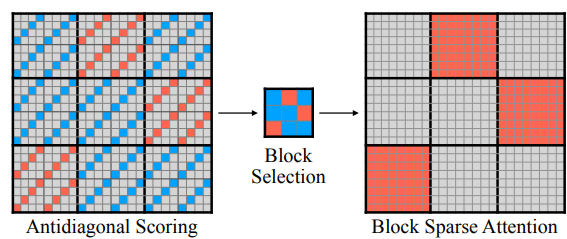
Papers with notable results
Quantization
- Optimizing Large Language Model Training Using FP4 Quantization by Microsoft and University of Science and Technology of China (https://arxiv.org/pdf/2501.17116). The work introduces the FP4 training framework for LLMs, addressing quantization challenges with two key ideas: a differentiable quantization estimator for precise weight updates and an outlier clamping and compensation strategy to prevent activation collapse. To ensure stability, the framework integrates a mixed-precision training scheme and vector-wise quantization. Experimental results demonstrate that our FP4 framework achieves accuracy comparable to BF16 and FP8, with minimal degradation, scaling effectively to 13B-parameter LLMs trained on up to 100B.
- MQuant: Unleashing the Inference Potential of Multimodal Large Language Models via Full Static Quantization by Houmo AI, Southeast University, and Xi’an Jiaotong University (https://arxiv.org/pdf/2502.00425). The work focuses on the problems of VLM quantization with a coarse scale granularity. It proposes several techniques to tackle the quantization problems, namely: Modality-Specific Static Quantization (MSQ), assigning distinct static scales for visual vs. textual tokens; Attention-Invariant Flexible Switching (AIFS), reordering tokens to preserve casual attention while eliminating expensive token-wise scale computations; Rotation Magnitude Suppression (RMS), mitigating weight outliers arising from online Hadamard rotations. On five mainstream VLMs (including Qwen-VL, MiniCPM-V, CogVLM2), the method achieves near-floating-point accuracy under W4A8 setting. The code is planned to be published.
- An Empirical Study of LLaMA3 Quantization: From LLMs to MLLMs by The University of Hong Kong, Beihang University, and ETH Zurich (https://arxiv.org/pdf/2404.14047). Authors assessed the performance of the LLaMA3-based LLaVA-Next-8B model under 2-4 ultra-low bits with post-training quantization methods. Experimental results indicate that LLaMA3 still suffers from non-negligible degradation in linguistic and visual contexts, particularly under ultra-low bit widths. This highlights the significant performance gap at low bit-width that needs to be addressed in future developments. The code is available at: https://github.com/Macaronlin/LLaMA3-Quantization.
- Nanoscaling Floating-Point (NxFP): NanoMantissa, Adaptive Microexponents, and Code Recycling for Direct-Cast Compression of Large Language Models by Harvard University (https://arxiv.org/pdf/2412.19821). This paper profiles modern LLMs and identifies three main challenges of low-bit Microscaling format, i.e., inaccurate tracking of outliers, vacant quantization levels, nd wasted binary code. In response, Nanoscaling (NxFP) proposes three techniques, i.e., NanoMantissa, Adaptive Microexponent, and Code Recycling to enable better accuracy and smaller memory footprint than state-of-the-art MxFP. Experimental results on direct-cast inference across various modern LLMs demonstrate that the proposed methods outperform MxFP by up to 0.64 in perplexity and by up to 30% in accuracy on MMLU benchmarks.
- RoSTE: An Efficient Quantization-Aware Supervised Fine-Tuning Approach for Large Language Models by University of Minnesota and The Chinese University of Hong Kong (https://arxiv.org/pdf/2502.09003). The paper introduces a fine-tuning based method that directly optimizes quantized weights and rotation matrices within a single model architecture. It proposes a bilevel optimization formulation, where upper level subproblem optimizes weight matrices, while lower level subproblem employs a surrogate loss to guide the selection of rotation matrix. Authors designed an algorithm which alternates between (i) a QAT subroutine incorporating a rotation-enabled straightthrough-estimator (STE) update, and (ii) a low complexity heuristic for selecting rotation matrices based on the random Walsh-Hadamard matrix. They provide a theoretical analysis of the benefits of rotation-enabled quantization in QA-SFT by examining the prediction error resulted from the QAT stage of RoSTE. This analysis directly motivates the use of quantization error based surrogate loss and justifies the adoption.
- NESTQUANT: NESTED LATTICE QUANTIZATION FOR MATRIX PRODUCTS AND LLMS by MIT and Hebrew University of Jerusalem (https://arxiv.org/pdf/2502.09720). The paper proposes a PTQ scheme for weights and activations that is based on self-similar nested lattices. Recent work has mathematically shown such quantizers to be information-theoretically optimal for low-precision matrix multiplication. We implement a practical low-complexity version based on Gosset lattice, making it a drop-in quantizer for any matrix multiplication step (e.g., in self-attention, MLP etc). For example, the method quantizes weights, KV-cache, and activations of Llama-3-8B to 4 bits, achieving perplexity of 6.6 on wikitext2.
- ViM-VQ: Efficient Post-Training Vector Quantization for Visual Mamba by Zhejiang University and vivo Mobile (https://arxiv.org/pdf/2503.09509). A practical study of vector quantization method for Visual Mamba networks (ViMs). Authors identify several key challenges: 1) The weights of Mamba-based blocks in ViMs contain numerous outliers, significantly amplifying quantization errors. 2) When applied to ViMs, the latest VQ methods suffer from excessive memory consumption, lengthy calibration procedures, and suboptimal performance in the search for optimal codewords. They propose a post-training vector quantization method tailored for ViMs. It consists of two components: 1) a fast convex combination optimization algorithm that updates both the convex combinations and the convex hulls to search for optimal codewords, and 2) an incremental vector quantization strategy that incrementally confirms optimal codewords to mitigate truncation errors. The results demonstrate that the method achieves stateof-the-art performance in low-bit quantization across various visual tasks.
- SSVQ: Unleashing the Potential of Vector Quantization with Sign-Splitting by Zhejiang University and vivo Mobile (https://arxiv.org/pdf/2503.08668). The paper proposes the vector quantization approach which decouples the sign bit of weights from the codebook. It involves extracting the sign bits of uncompressed weights and performing clustering and compression on all-positive weights. Authors also introduce latent variables for the sign bit and jointly optimize both the signs and the codebook. Additionally, they implement a progressive freezing strategy for the learnable sign to ensure training stability. Experiments on modern models and tasks demonstrate that the method achieves a good compression-accuracy trade-off compared to conventional VQ. Authors also validate the algorithm on a hardware accelerator, showing that SSVQ achieves a 3× speedup over the 8-bit compressed model by reducing memory access.
- MergeQuant: Accurate 4-bit Static Quantization of Large Language Models by Channel-wise Calibration (https://arxiv.org/pdf/2503.07654). The paper introduces per-channel static quantization method. It integrates the per-channel quantization steps with the corresponding scalings and linear mappings through a Quantization Step Migration method, eliminating the quantization overheads before and after matrix multiplication. Authors also propose dimensional reconstruction and adaptive clipping to address the nonuniformity of quantization scale factors and redistribute the channel variations to the subsequent modules to balance the parameter distribution under QSM. They evaluate method on Llama 2 and Llama 3 models in W4A4 setting.
- QuantCache: Adaptive Importance-Guided Quantization with Hierarchical Latent and Layer Caching for Video Generation by Shanghai Jiao Tong University, MGTV, Shanhai Academy (https://arxiv.org/pdf/2503.06545). Authors propose a training-free inference acceleration framework that jointly optimizes hierarchical latent caching, adaptive importance-guided quantization, and structural redundancy-aware pruning. It achieves an end-to-end latency speedup of 6.72x on OpenSora with minimal loss in generation quality. experiments across multiple video generation benchmarks demonstrate the effectiveness of our method for DiT inference. The code and models will be available at https://github.com/JunyiWuCode/QuantCache.
- Matryoshka Quantization by Google DeepMind (https://arxiv.org/pdf/2502.06786). Practitioners are often forced to maintain multiple models with different quantization levels or serve a single model that best satisfies the quality-latency trade-off. On the other hand, integer data types, such as int8, inherently possess a nested (Matryoshka) structure where smaller bit-width integers, like int4 or int2, are nested within the most significant bits. In this paper, the authors propose Matryoshka Quantization (MatQuant), a multi-scale quantization technique that alleviates the aforementioned challenge. It allows us to train and maintain a single quantized model but serve it with the precision demanded by the deployment. Furthermore, leveraging MatQuant’s co-training and co-distillation regularization, int2 precision models extracted by MatQuant outperform standard int2 quantization by up to to 4% and 7% with OmniQuant and QAT as base algorithms respectively. Finally, authors demonstrate that by using an extra bit to represent outliers, a model with an effective precision of 2.05-bit gives an additional 6% improvement with OmniQuant as the base algorithm.
Pruning/Sparsity
- Mamba-Shedder: Post-Transformer Compression for Efficient Selective Structured State Space Models by Intel Labs (https://arxiv.org/pdf/2501.17088v1). This paper explores the compression of SSM-based models, particularly Mamba and its hybrids. The authors discuss the sensitivity of these models to the removal of selected components at different granularities to reduce the model size and computational overhead, thus improving their efficiency while maintaining accuracy. The proposed solutions, collectively referred to as Mamba-Shedder, achieve a speedup of up to 1.4x during inference, demonstrating that model efficiency can be improved by eliminating several redundancies with minimal impact on the overall model performance. The code is available at https://github.com/IntelLabs/Hardware-Aware-Automated-Machine-Learning.
- DeepSeekAI, The Sparsity Revolution That Shook the AI Market: https://www.linkedin.com/pulse/deepseek-ai-sparsity-revolution-shook-market-jabar-riaz-hwvbf. The blogpost discusses two types of sparsity to train efficient and competitive LLM models, namely data sparsity and model sparsity.
Other
- TPU Scaling Book from Google - a series of blog posts on how to optimize LLMs for Google TPUv5: https://jax-ml.github.io/scaling-book/applied-inference.
- The Ultra-Scale Playbook: Training LLMs on GPU Clusters https://huggingface.co/spaces/nanotron/ultrascale-playbook. A tutorial from HuggingFace on the basics of multi-GPU training and how to scale it.
- Qwen2.5-1M Technical Report by Alibaba (https://qianwen-res.oss-cn-beijing.aliyuncs.com/Qwen2.5-1M/Qwen2_5_1M_Technical_Report.pdf). Authors introduce Qwen2.5-1M, a series of models that extend the context length to 1 million tokens. Compared to the previous 128K version, the Qwen2.5-1M series has significantly enhanced long-context capabilities through long-context pretraining and post-training. To reduce inference costs, authors implement a sparse attention method along with chunked prefill optimization for deployment scenarios and a sparsity refinement method to improve precision. Additionally, they detail optimizations in the inference engine, including kernel optimization, pipeline parallelism, and scheduling optimization, which significantly enhance overall inference performance. Qwen2.5-1M models achieve a remarkable 3x to 7x prefill speedup in scenarios with 1 million tokens of context.
- WaferLLM: A Wafer-Scale LLM Inference System by University of Edinburgh and Microsoft (https://arxiv.org/pdf/2502.04563). The paper introduces LLM inference system that is guided by a device model that captures the unique hardware characteristics of wafer-scale architectures. It proposes MeshGEMM and MeshGEMV, the GEMM and GEMV implementations designed to scale effectively on wafer-scale accelerator. Authors focus on four principles when designing the implementation: Massive Parallel cores, Highly non-uniform memory access Latency, Constrained local Memory, and Limited hardware-assisted Routing. Evaluations show that the method achieves 200× better wafer-scale accelerator utilization than state-of-the-art systems. On a commodity wafer-scale accelerator, it delivers 606× faster and 22× more energy-efficient GEMV compared to an advanced GPU. One of the limitations of the method is a limited model size due to a need to replicate memory over the computational units to increase the latency.
- EmbBERT-Q: Breaking Memory Barriers in Embedded NLP by Politecnico di Milano (https://arxiv.org/pdf/2502.10001). The paper proposes a new LM model specifically designed for tiny devices, combining efficiency and effectiveness. Authors analytically evaluate the memory usage and computational complexity of the model and its components, providing a tool to evaluate the weights and activations of memory trade-offs required to operate within tiny device constraints. They also release all code, scripts, and model checkpoints at https://github.com/RiccardoBravin/tiny-LLM.
- M2R2: MIXTURE OF MULTI-RATE RESIDUALS FOR EFFICIENT TRANSFORMER INFERENCE by Apple (https://arxiv.org/pdf/2502.02040). The paper introduce Mixture of Multi-rate Residuals, a framework that dynamically modulates the velocity of residual transformations to optimize early residual alignment. This modification improves inference efficiency by better aligning intermediate representations at earlier stages. Authors show the efficacy of the technique in diverse optimization setups such as dynamic computing, speculative decoding, and MoE Ahead-of-Time. In self-speculative decoding setups, M2R2 achieves up to 2.8X speedups on MT-Bench under lossless conditions. In Mixture-of-Experts architectures, they enhance decoding speed by coupling early residual alignment with ahead-of-time expert loading into high-bandwidth memory. This enables concurrent memory access and computation, reducing the latency bottlenecks inherent in expert switching during decoding. Empirical results show that the method delivers a speedup of 2.9X in MoE architectures.
- Extending Language Model Context Up to 3 Million Tokens on a Single GPU by KAIST and DeepAuto.ai (https://arxiv.org/pdf/2502.08910). To enable efficient and practical long-context utilization, authors introduce an LLM inference framework that accelerates processing by dynamically eliminating irrelevant context tokens through a modular hierarchical token pruning algorithm. The method also allows generalization to longer sequences by selectively applying various RoPE adjustment methods according to the internal attention patterns within LLMs. They also offload the key-value cache to host memory during inference, significantly reducing GPU memory pressure. As a result, the method enables the processing of up to 3 million tokens on a single L40s 48GB GPU without any permanent loss of context information. The framework achieves an 18.95x.
- KernelBench: Can LLMs Write Efficient GPU Kernels? by Stanford University and Princeton University (https://arxiv.org/pdf/2502.10517). The paper introduces KernelBench, an open-source framework for evaluating LMs’ ability to write fast and correct kernels on a suite of 250 carefully selected PyTorch ML workloads. KernelBench represents a real-world engineering environment and making progress on the introduced benchmark directly translates to faster practical kernels. Auhors introduce a new evaluation metric fastp, which measures the percentage of generated kernels that are functionally correct and offer a speedup greater than an adjustable threshold p over baseline. Experiments across various models and test-time methods show that frontier reasoning models perform the best out of the box but still fall short overall, matching the PyTorch baseline in less than 20% of the cases.
- Investigating the Impact of Quantization Methods on the Safety and Reliability of Large Language Models by Skolkovo Institute, Artificial Intelligence Research Institute, HSE University (https://arxiv.org/pdf/2502.15799). Authors introduce OpenSafetyMini, a openended safety dataset designed to better distinguish between models. They evaluate 4 state-ofthe-art quantization techniques across LLaMA and Mistral models using 4 benchmarks, including human evaluations. Findings reveal that the optimal quantization method varies for 4-bit precision, while vector quantization techniques deliver the best safety and trustworthiness performance at 2-bit precision, providing foundation for future research. The dataset and reproduces available at: https://github.com/On-Point-RND/OpenSafetyMini-Investigating-the-Impact-of-Quantization-Methods-on-the-Safety-and-Reliability-of-LLM.
- MOBA: MIXTURE OF BLOCK ATTENTION FOR LONG-CONTEXT LLMS by Moonshot AI, Tsinghua University, and Zhejiang University (https://arxiv.org/pdf/2502.13189v1). In this work, authors propose a solution that adheres to the “less structure” principle, allowing the model to determine where to attend autonomously, rather than introducing predefined biases. They introduce Mixture of Block Attention (MoBA), an approach that applies the principles of Mixture of Experts (MoE) to the attention mechanism. It is based on block partitioning and routing strategy within Multi-Head Self-Attention. The code is available at https://github.com/MoonshotAI/MoBA.
- JUDGE DECODING: FASTER SPECULATIVE SAMPLING REQUIRES GOING BEYOND MODEL ALIGNMENT by Meta GenAI and ETH Zurich (https://openreview.net/pdf?id=mtSSFiqW6y). The paper demonstrates through a series of experiments how the decision mechanism in speculative decoding rejects many high-quality tokens, identifying a key limitation of the technique. Authors adapt verification using ideas from LLM-as-a-judge, eliciting the same versatile rating capability in the target by adding a simple linear layer that can be trained in under 1.5 hours. Using a Llama 8B/70B-Judge, the proposed approach obtains speedups of 9x over standard decoding, achieving an unprecedented 129 tokens/s, while maintaining the quality of Llama-405B on a range of benchmarks.
Software
- FlashMLA by Deepseek: https://github.com/deepseek-ai/FlashMLA. FlashMLA is an efficient MLA decoding kernel for Hopper GPUs, optimized for variable-length sequences serving.
- DeepSeek releases DeepGEMM is a library designed for clean and efficient FP8 General Matrix Multiplications (GEMMs) with fine-grained scaling: https://github.com/deepseek-ai/DeepGEMM.
- SVDQuant Meets NVFP4: 4× Smaller and 3× Faster FLUX with 16-bit Quality on NVIDIA Blackwell GPUs: https://hanlab.mit.edu/blog/svdquant-nvfp4.
- M3 Ultra Runs DeepSeek R1 With 671 Billion Parameters Using 448GB Of Unified Memory, Delivering High Bandwidth Performance At Under 200W Power Consumption, With No Need For A Multi-GPU Setup: https://wccftech.com/m3-ultra-chip-handles-deepseek-r1-model-with-671-billion-parameters/.
- NVIDIA TensorRT Model Optimizer: https://github.com/NVIDIA/TensorRT-Model-Optimizer. A Library to Quantize and Compress Deep Learning Models for Optimized Inference on GPUs.
Q3'24: Technology Update – Low Precision and Model Optimization
Authors
Alexander Kozlov, Nikita Savelyev, Vui Seng Chua, Souvikk Kundu, Nikolay Lyalyushkin, Andrey Anufriev, Pablo Munoz, Alexander Suslov, Liubov Talamanova, Yury Gorbachev, Nilesh Jain, Maxim Proshin
Summary
This quarter, we continue observing the trendon the optimization of LLM-based pipelines. Besides a high interest in weight quantizationto precisions beyond 4-bits, we see a lot of effort in the optimization of usageof KV-cache during the ScaledDotProduct computation: from KV-cache quantizationand decomposition to sparse attention where only a part of KV-cache is used topredict the next token. This gives the opportunity to design more efficientinference pipelines with heterogeneous execution (see RetrievalAttention work).
Highlights
- SpinQuant: LLM Quantizationwith Learned Rotations by Meta (https://arxiv.org/abs/2405.16406). Develop the idea of rotation by a random orthogonal matrix from QuIP, QuIP#, and QuaRotto reduce outliers in the LLMs and obtain better quality of W4A4KV4 quantization. The authors found that not all rotations help equally, and random rotations produce a significant variance in quantized models. Therefore, it is proposed to search for “good” rotation matrices using optimization with Cayley optimization. The matrix optimization procedure takes a little over an hour on smaller representatives of the LLama family on 8 A100 and half a day for 70B models. Regarding quality, they are ahead of baselines (the closest QuaRot is about 1% on average). Adding a rotation inside FFN gives the most significant gain. Code is available: https://github.com/facebookresearch/SpinQuant.

- ACCURATE COMPRESSION OFTEXT-TO-IMAGE DIFFUSION MODELS VIA VECTOR QUANTIZATION by Yandex Research, HSE University, Skoltech, MIPT, Neural Magic, IST Austria (https://arxiv.org/pdf/2409.00492).The authors explore vector-based PTQ strategies for text-to-image diffusion models and demonstrate that the compressed models yield higher quality text-to-image generation than the scalar alternatives under the same bit-widths. They describe an effective fine-tuning technique that further closes the gap between the full-precision and compressed models, leveraging the flexibility of the vector quantized representation. To showcase the method, they compress the weights of SDXL down to 3 bits per parameter. Extensive human evaluation and automated metrics confirm the superiority of our approach over previous diffusion compression methods under the same bit-widths. The authors illustrate that the approach can be effectively applied to distilled diffusion models, such as SDXL, which achieve nearly lossless 4-bit compression. Code is available at https://github.com/yandex-research/vqdm.

- Sparse Refinement for Efficient High-Resolution Semantic Segmentation by MIT, NVIDIA, Tsinghua University, University of Toronto, UC Berkeley (https://arxiv.org/pdf/2407.19014). Authors introduce a novel approach that enhances dense low-resolution predictions with sparse high-resolution refinements. Based on coarse low-resolution outputs, the method first uses an entropy selector to identify a sparse set of pixels with high entropy. It then employs a sparse feature extractor to generate the refinements for those pixels of interest. Finally, it leverages a gated ensembler to apply these sparse refinements to the initial coarse predictions. The method can be seamlessly integrated into any existing semantic segmentation model, regardless of CNN- or ViT-based. SparseRefine achieves significant speedup: 1.5 to 3.7 times when applied to HRNet-W48, SegFormer-B5, Mask2Former-T/L and SegNeXt-L on Cityscapes, with negligible to no loss of accuracy.

- RetrievalAttention: Accelerating Long-Context LLM Inference via Vector Retrieval by Microsoft Research, Shanghai Jiao Tong University, Fudan University (https://arxiv.org/pdf/2409.10516). Authors employ dynamic sparse attention during token generation, allowing the most critical tokens to emerge from the extensive context data. To address theOOD issue, the method constructs a vector index tailored for the attention mechanism, focusing on the distribution of queries rather than key similarities. This approach allows for traversal of only a small subset of key vectors (1% to 3%), effectively identifying the most relevant tokens to achieve accurate attention scores and results. To optimize resource utilization, RetrievalAttention retains KV vectors in the GPU memory following static patterns while offloading the majority of KV vectors to CPU memory for index construction. This strategy enables RetrievalAttention to perform attention computation with reduced latency and minimal GPU memory utilization. The method shows SOTA results in terms of latency-performance.

Papers with notable results
Quantization
- ADFQ-ViT: Activation-Distribution-Friendly Post-Training Quantization for Vision Transformers by Chinese universities (https://arxiv.org/pdf/2407.02763). Authors design the Per-Patch Outlier-aware Quantizer and the Shift-Log2 Quantizer, which addresses the challenges of outliers and irregular distributions in post-LayerNorm activations and the non-uniform distribution of positive and negative values in post-GELU activations. They also introduce the attention-score enhanced module-wise optimization, which optimizes the parameters of the weight and activation quantizer to reduce errors before and after quantization. The method shows very good results for various Vision Transformer models and use cases at W4A4 and W6A6 setups.
- How Does Quantization Affect Multilingual LLMs? by Cohere (https://arxiv.org/pdf/2407.03211). The authors investigate the problem of LLM accuracy degradation after quantization. They use automatic benchmarks, LLM-as-a-Judge methods, and human evaluation, finding that (1) harmful effects of quantization are apparent in human evaluation, and automatic metrics severely underestimate the detriment: a 1.7%average drop in Japanese across automatic tasks corresponds to a 16.0% drop reported by human evaluators on realistic prompts; (2) languages are disparately affected by quantization, with non-Latin script languages impacted worst; and (3) challenging tasks such as mathematical reasoning degrade fastest.
- CLAMP-ViT: Contrastive Data-Free Learning for Adaptive Post-Training Quantization of ViTs by Georgia Institute of Technology and Intel Labs (https://arxiv.org/pdf/2407.05266). The authors incorporate a patch-level contrastive learning scheme to generate richer, semantically meaningful data. Furthermore, they leverage contrastive learning in layer-wise evolutionary search for fixed- and mixed-precision quantization to identify optimal quantization parameters while mitigating the effects of a non-smooth loss landscape. Evaluations across various vision tasks demonstrate the superiority of CLAMP-ViT, with performance improvements of up to 3% in top-1 accuracy for classification, 0.6 mAP for object detection, and 1.5 mIoU for segmentation at a similar or better compression ratio over existing alternatives. The code is available at https://github.com/georgia-tech-synergy-lab/CLAMP-ViT.git.
- RoLoRA: Fine-tuning Rotated Outlier-free LLMs for Effective Weight-Activation Quantization by Hong Kong University of Science and Technology and Meta Reality Labs (https://arxiv.org/pdf/2407.08044).The paper proposes RoLoRA, the scheme for weight-activation quantization. RoLoRA utilizes rotation for outlier elimination and proposes rotation-aware fine-tuning to preserve the outlier-free characteristics in rotated LLMs. Experimental results show RoLoRA consistently improves low-bit LoRA convergence and post-training quantization robustness in weight-activation settings. The code is supposed to be available at https://github.com/HuangOwen/RoLoRA.
- LRQ: Optimizing Post-Training Quantization for Large Language Models by Learning Low-Rank Weight-Scaling Matrices by NAVER Cloud, KAIST AI, AITRICS, SNU AI Center (https://arxiv.org/pdf/2407.11534). The authors propose a post-training weight quantization method for LLMs that reconstructs the outputs of an intermediate Transformer block by leveraging low-rank weight-scaling matrices, replacing the conventional full weight-scaling matrices that entail as many learnable scales as their associated weights. Thanks to parameter sharing via low-rank structure, the method only needs to learn significantly fewer parameters while enabling the individual scaling of weights, thus boosting the generalization capability of quantized LLMs. Authors show the superiority of the method over prior LLM PTQ works under (i) 8-bit weight and per-tensor activation quantization, (ii) 4-bitweight and 8-bit per-token activation quantization, and (iii) low-bitweight-only quantization schemes. The code is available at https://github.com/onliwad101/FlexRound_LRQ.
- AdaLog: Post-Training Quantization for Vision Transformers with Adaptive Logarithm Quantizer by Beihang University (https://arxiv.org/pdf/2407.12951). The paper proposes a non-uniform quantizer that optimizes the logarithmic base to accommodate the power-law-like distribution of activations while simultaneously allowing for hardware-friendly quantization and dequantization. By employing the bias reparameterization, the quantizer is applicable to both the post-Softmax and post-GELU activations. The authors also develop an efficient Fast Progressive Combining Search (FPCS) strategy to determine the optimal logarithm base, as well as the scaling factors and zero points for the uniform quantizers. Experimental results on public benchmarks demonstrate promising results for various ViT-based architectures and vision tasks, especially in the W6A6setup. The code is available at https://github.com/GoatWu/AdaLog.
- RECLAIMING RESIDUAL KNOWLEDGE: A NOVEL PARADIGM TO LOW-BITQUANTIZATION by Irish Universities (https://arxiv.org/pdf/2408.00923). The authors present an efficient, low-bit, and PTQ framework for ConvNets by framing optimal quantization as an architecture search problem to re-capture quantization residual knowledge with low-rank adapters. They introduce a differentiable neural combinatorial optimization approach, searching for the optimal low-rank adapters using a smooth, high-order normalized Butterworth kernel. They also show a result, converting the weights of existing high-rank quantization residual convolutional operators to low-rank adapters without training. The method achieves good 4-bit and 3-bit quantization results by using less than 250 iterations on a small calibration set with 1600 images. Code will be open-sourced.
- VQ4DiT: Efficient Post-Training Vector Quantization for Diffusion Transformers by Zhejiang University and vivo Mobile Communication (https://arxiv.org/pdf/2408.17131). The authors explore the Vector Quantization methods for extremely low bit-width DiTs and introduce DiT-specific improvements for better quantization. They calibrate both the codebook and the assignments of each layer simultaneously. The proposed method calculates the candidate assignment set for each weight sub-vector based on Euclidean distance and reconstructs the sub-vector based on the weighted average. Then, using the zero-data and block-wise calibration method, the optimal assignment from the set is efficiently selected while calibrating the codebook. The method achieves competitive evaluation results compared to full-precision models on the ImageNet.
- MobileQuant: Mobile-friendly Quantization for On-device Language Models by Samsung AI Center, Cambridge (https://arxiv.org/pdf/2408.13933). The authors introduce a post-training quantization approach for LLMs that is supported by current mobile hardware implementations (i.e., DSP, NPU), thus being directly deployable on real-edge devices. The method improves upon prior works through simple yet effective methodological extensions that enable us to effectively quantize most activations to a lower bit-width (i.e., 8-bit) with near-lossless performance. They conduct an on-device evaluation of model accuracy, inference latency, and energy consumption. The results indicate that the proposed method reduces inference latency and energy usage by 20%-50% while still maintaining accuracy compared to models using 16-bit activations.
- Low-Bit width Floating Point Quantization for Efficient High-Quality Diffusion Models by the University of Toronto & Vector Institute (https://arxiv.org/pdf/2408.06995).The authors propose a floating-point quantization method for diffusion models that provides better image quality compared to integer quantization methods. They employ a floating-point quantization method by integrating weight rounding learning during the mapping of the full-precision values to the quantized values in the quantization process. The authors also study integer and floating-point quantization methods in state-of-the-art diffusion models. Additionally, they introduce a methodology to evaluate quantization effects, highlighting shortcomings with existing output quality metrics and experimental methodologies. Finally, their floating-point quantization method increases model sparsity by an order of magnitude, enabling further optimization opportunities.
- DopQ-ViT: Towards Distribution-Friendly and Outlier-Aware Post-Training Quantization for Vision Transformers by Institute of Automation and School of Artificial Intelligence of Chinese Academy of Sciences (https://arxiv.org/pdf/2408.03291v2).The paper focuses on the full quantization of Vision Transformers. The authors propose using the Tan Quantizer, which focuses more on values near 1, thereby better fitting the distribution of post-Softmax activations in Transformer layers. Besides, the method selects the median as the optimal scaling factor, effectively addressing the accuracy degradation issue that occurs after parametrizing post-LayerNorm activations. The method achieves very accurate results especially in W6/A6 for various tasks such as ImageNet or MS COCO.
- Differentiable Product Quantization for Memory Efficient Camera Relocalization by Czech Technical University in Prague, Aalto University, University of Oulu (https://arxiv.org/pdf/2407.15540).The authors introduce a simple and standalone metric learning for Differentiable Product Quantization for 3D scene compression that preserves matching properties of the descriptors and the final camera localization performance; ii) the proposed hybrid method enables a better tradeoff between memory complexity and localization; iii) they analyze the tradeoffs between description and map compression and show how localization is more tolerant to description compression on outdoor and indoor datasets. The code will be publicly available at https://github.com/AaltoVision/dpqe.
- Advancing Multimodal Large Language Models with Quantization-Aware Scale Learning for Efficient Adaptation by Xiamen University and SkyWork AI (https://arxiv.org/pdf/2408.03735).The paper introduces a Quantization-aware scale Learning method based on multimodal warmup. This method is grounded in two key innovations: (1) The learning of group-wise scale factors for quantized LLM weights to mitigate the quantization error arising from activation outliers and achieve more effective vision-language instruction tuning; (2) The implementation of a multimodal warmup that progressively integrates linguistic and multimodal training samples, thereby preventing overfitting of the quantized model to multimodal data while ensuring stable adaptation of multimodal large language models to downstream vision-language tasks. The code is supposed to be available at https://github.com/xjjxmu/QSLAW.
- Mamba-PTQ: Outlier Channels in Recurrent Large Language Models by Intel Labs (https://arxiv.org/pdf/2407.12397).This workshop paper is among the first to study post-training quantization on the Mamba architecture. Similar to Transformer models, it observed the presence of outlier channels in activations (those with absolute maximum values exceeding 6 standard deviations from the layer mean) and found that downstream task performance degrades substantially when these channels are removed. The study presents zero-shot results of naïve symmetrical per-tensor quantization of weights and activations across Mamba1 models, ranging from 130M to 2.8B parameters, providing a baseline for future quantization research on this emerging architecture.
- Foundation of Large Language Model Compression – Part 1: Weight Quantization by CSAIL MIT (https://arxiv.org/pdf/2409.02026).This work introduces CVXQ, a post-training weight quantization framework that assigns varying bit widths down to the per-group level, constrained by a target average bit rate per weight element. Formulated through the lens of Lagrangian convex optimization, the framework leads to a dual-ascent methods that alternately update the bit width and the tradeoff variable until all optimality conditions are met. To overcome the non-differentiability arising from discrete bit widths and considering that weight distributions are Gaussian or Laplacian, the framework leverages a well-known result from rate-distortion theory to provide closed-form derivative estimates during optimization. CVXQ adopts an interesting compounding (non-uniform) quantization, where weights are first projected to the sigmoid domain before applying uniform round-to-nearest quantization. A codebook is employed to enable dequantization via simple lookup, avoiding complex inverse computations. Tested across a wide range of model sizes in OPT and Llama2, CVXQ outperforms GPTQ, AWQ, and OWQ at 3- and 4-bit rates per weight in nearly all cases. Full implementation will be available soon here.
Pruning / Sparsity
- LazyLLM: DYNAMIC TOKEN PRUNING FOR EFFICIENT LONGCONTEXT LLM INFERENCE by Apple and Meta AI (https://arxiv.org/pdf/2407.14057). The paper introduces an LLM acceleration method that selectively computes the KV for tokens important for the next token prediction in both the prefilling and decoding stages. Contrary to static pruning approaches that prune the prompt at once, LazyLLM allows language models to dynamically select different subsets of tokens from the context in different generation steps, even though they might be pruned in previous steps. The method also introduces a concept of AuxCache to store the tokens that are omitted during the previous steps of text generation but required at the current step. Experiments on standard datasets across various tasks demonstrate that LazyLLM can significantly accelerate the generation without fine-tuning, e.g., prefilling stage of the LLama 2 7B model by 2.34x while maintaining accuracy.
- Compact Language Models via Pruning and Knowledge Distillation by Nvidia (https://www.arxiv.org/pdf/2407.14679). Authors propose compression best practices for LLMs that combine depth, width, attention, and MLP pruning with knowledge distillation-based retraining. They arrive at these best practices through a detailed empirical exploration of pruning strategies for each axis, methods to combine axes, distillation strategies, and search techniques for arriving at optimal compressed architectures. They use this guide to compress the Nemotron-4 family of LLMs by a factor of 2-4× and compare their performance to similarly-sized models on a variety of language modeling tasks. Deriving 8B and 4B models from an already pretrained 15B model using this approach requires up to 40x fewer training tokens per model compared to training from scratch; this results in compute cost savings of 1.8x for training the full model family (15B, 8B, and 4B).
- SQFT: Low-cost Model Adaptation in Low-precision Sparse Foundation Models by Intel Labs (https://github.com/IntelLabs/Hardware-Aware-Automated-Machine-Learning). This paper proposes an end-to-end solution for low-precision sparse parameter-efficient fine-tuning of large pre-trained models. It includes an innovative strategy that enables the merging of sparse weights with low-rank adapters without losing the sparsity induced in the base model, overcoming the limitations of previous approaches. SQFT also addresses the challenge of having quantized weights and adapters with different numerical precisions, enabling merging in the desired numerical format without sacrificing accuracy. Multiple adaptation scenarios, models, and comprehensive sparsity levels demonstrate the effectiveness of SQFT. Models and open-source code are available.
- ShadowLLM: Predictor-based Contextual Sparsity for Large Language Models by Cornell University and Google (https://arxiv.org/abs/2406.16635). Contemporary research on contextual sparsity primarily uses magnitude-based metrics to measure the importance of attention heads and neurons in LLMs. This paper aims to assess various importance metrics from the literature, including those based on(1) activation norm, (2) first-order gradient, (3) combination of norm and gradient, (4) second-order gradient, and (5) sensitivity-based metrics. The authors conclude that the PlainAct criterion – the L1-norm of the product of magnitude and gradient – emerges as the better metric by offering a robust sparsity-task tradeoff and learnability in importance rank. The authors also propose using just a single predictor, with the attention scores of the first transformer block as input, to forecast sparsity patterns for the entire LLM, as opposed to DejaVu, which requires predictors at regular intervals of transformer blocks. This innovation simplifies predictor training and implementation while also reducing inference overhead, achieving up to 20% faster generation than DejaVu across sizes of OPT family. Code is here.
- STUN: Structured-Then-Unstructured Pruning for Scalable MoE Pruning by SNU and Snowflake AI Research (https://arxiv.org/pdf/2409.06211). The work discovers a novel way to prune experts of MoE where the method reduces the complexity of expert selection from combinatorial O(kn/√n) down to O(1) using several greedy assumptions. The authors exploit the structure of router weight, applying clustering based on a so-called behavioral similarity metric to identify (dis)similar experts and utilize the centroid as pruned representation to compute a first-order Taylor approximation of the relative distortion. The entire expert pruning can be effectively run without any calibration data and unnecessarily on GPU, especially for the MoE with large numbers of experts. The work also found that expert pruning followed by unstructured pruning provides a better Pareto front. A key result on Snowflake Arctic, a 480B-parameter MoE with 128 experts, shows that STUN achieves 40% sparsity with minimal performance loss in just two hours using a single H100 GPU where unstructured pruning methods alone fall short.
Other
- Accuracy is Not All You Need by Microsoft Research, India (https://arxiv.org/pdf/2407.09141). The authors study the accuracy difference between compressed and source models. They claim that when the accuracy metrics are similar, they observe the phenomenon of flips, wherein answers change from correct to incorrect and vice versa in proportion. The authors conduct a detailed study of metrics across multiple compression techniques, models, and datasets, demonstrating that the behavior of compressed models as visible to end users is often significantly different from the baseline model, even when accuracy is similar. They further evaluate compressed models qualitatively and quantitatively using MT-Bench, showing that compressed models are significantly worse than baseline models in this free-form generative task. They argue that compression techniques should also be evaluated using distance metrics. Finally, the authors propose two metrics, KL-Divergence and % flips, and show that they are well correlated.
- Scaling LLM Test-Time Compute Optimally can be More Effective than Scaling Model Parameters by UC Berkeley and Google DeepMind (https://arxiv.org/pdf/2408.03314).The paper studies the scaling of inference-time computation in LLMs, focusing on answering the question: If an LLM is allowed to use a fixed but non-trivial amount of inference-time compute, how much can it improve its performance on a challenging prompt? Answering this question has implications not only on the achievable performance of LLMs, but also on the future of LLM pretraining and how one should trade inference-time and pre-training compute. Authors analyze two primary mechanisms to scale test-time computation: (1) searching against dense, process-based verifier reward models; and (2) updating the model’s distribution over a response adaptively, given the prompt at test time. They find that in both cases, the effectiveness of different approaches to scaling test-time compute critically varies depending on the difficulty of the prompt. This observation motivates applying a “compute-optimal” scaling strategy, which acts to most effectively allocate test-time compute adaptively per prompt. Using this compute-optimal strategy, authors can improve the efficiency of test-time compute scaling by more than 4x compared to a best-of-N baseline. Additionally, in a FLOPs-matched evaluation, they find that on problems where a smaller base model attains somewhat non-trivial success rates, test-time compute can be used to outperform a 14x larger model.
- Transformers are SSMs: Generalized Models and Efficient Algorithms Through Structured State Space Dual it by Tri Dao and Albert Gu (https://arxiv.org/abs/2405.21060). This paper discusses improvements to Mamba, the selective structure state space model (SSM) proposed as an alternative to Transformer-based models. The authors provide a framework called State Space Duality (SSD) that connects SSMs and variants of the attention mechanism. The Mamba-2 architecture is proposed, which obtains 2-8x speedup compared to the previous version of Mamba, and it is designed to be friendly to tensor and sequence parallelism. Experiments show that Mamba-2 outperforms Mamba and Transformer-based models in different model sizes. The authors also discuss hybrid models that can benefit from the combination of SSD with components from Transformer blocks.
Software
- A thorough analysis of performance and bottlenecks when using 4-bit KV cache on Nvidia with PyTorch: https://pytorch.org/blog/int4-decoding. Authors show step-by-step improvement when computing the Self-Attention operation of the Transformer block and compare results with CUDA and Flash Decoding baselines in 4-bit per-row and per-channel quantization settings of KV-cache.
- Llama.cpp introduced SIMD-friendly ternary weights packing/unpacking: https://compilade.net/blog/ternary-packing
- HuggingFace posted an exploratory work and recipes for ternary weights (1.58 bits) LLM weight compression: https://huggingface.co/blog/1_58_llm_extreme_quantization.
Large Language Model Graph Customization with OpenVINO™ Transformations API
Authors: Xiake Sun, Wenyi Zou, Fiona Zhao
Introduction
A Large Language Model (LLM) is a type of artificial intelligence algorithm that uses deep learning techniques and massively large data sets to understand, summarize, generate and predict new content.
OpenVINO™ optimizes the deployment of LLMs, enhancing their performance and integration into various applications. We already provide general guide to use LLMs with OpenVINO™, from model loading and conversion to advanced use cases.
In this blog, we will introduce some useful method to customize Large Language model’s graph with OpenVINO™ transformation API.
OpenVINO™ Runtime has three main transformation types:
- Modelpass: straightforward way to work with ov::Model directly
- Matcherpass: pattern-based transformation approach
- Graphrewrite pass: container for matcher passes needed for efficient execution.

In this blog, we mainly use ov::pass::MatcherPassto customize model subgraph via pattern-based transformation.
Here are common steps to implement graph customization using ov::pass::MatcherPass.
- Create a pattern
- Implement a callback
- Register the pattern and Matcher
- Execute MatcherPass
In this blog, we will use an open-source LLMs Qwen1.5-7B-Chat-GPTQ-Int4 from Alibaba Cloud with guide for model conversion and graph customization methods.
Qwen Pytorch to OpenVINO™ Model conversion
Here we can use openvino.genai repo to convert Qwen1.5 GPTQ INT4 Pytroch model to OpenVINO™model.
Converted model can be find in path “Qwen1.5-7B-Chat-GPTQ-Int4-OV/pytorch/dldt/GPTQ_INT4-FP16/".
Insert custom layer to OpenVINO™ model
Vocabularysize in the context of LLMs refers to the total number of unique words, or tokens, that the model can recognize and use. The larger the vocabulary size,the more nuanced and detailed the model’s understanding of language can be,however, it also requires more computational and memory resources for deployment. E.g. Qwen’s vocabulary size(151936) is almost 5x that Llama2 (32000), therefore additional optimization is required for efficient deployment.
We found that the following pattern existed in the Qwen model in Figure 2:
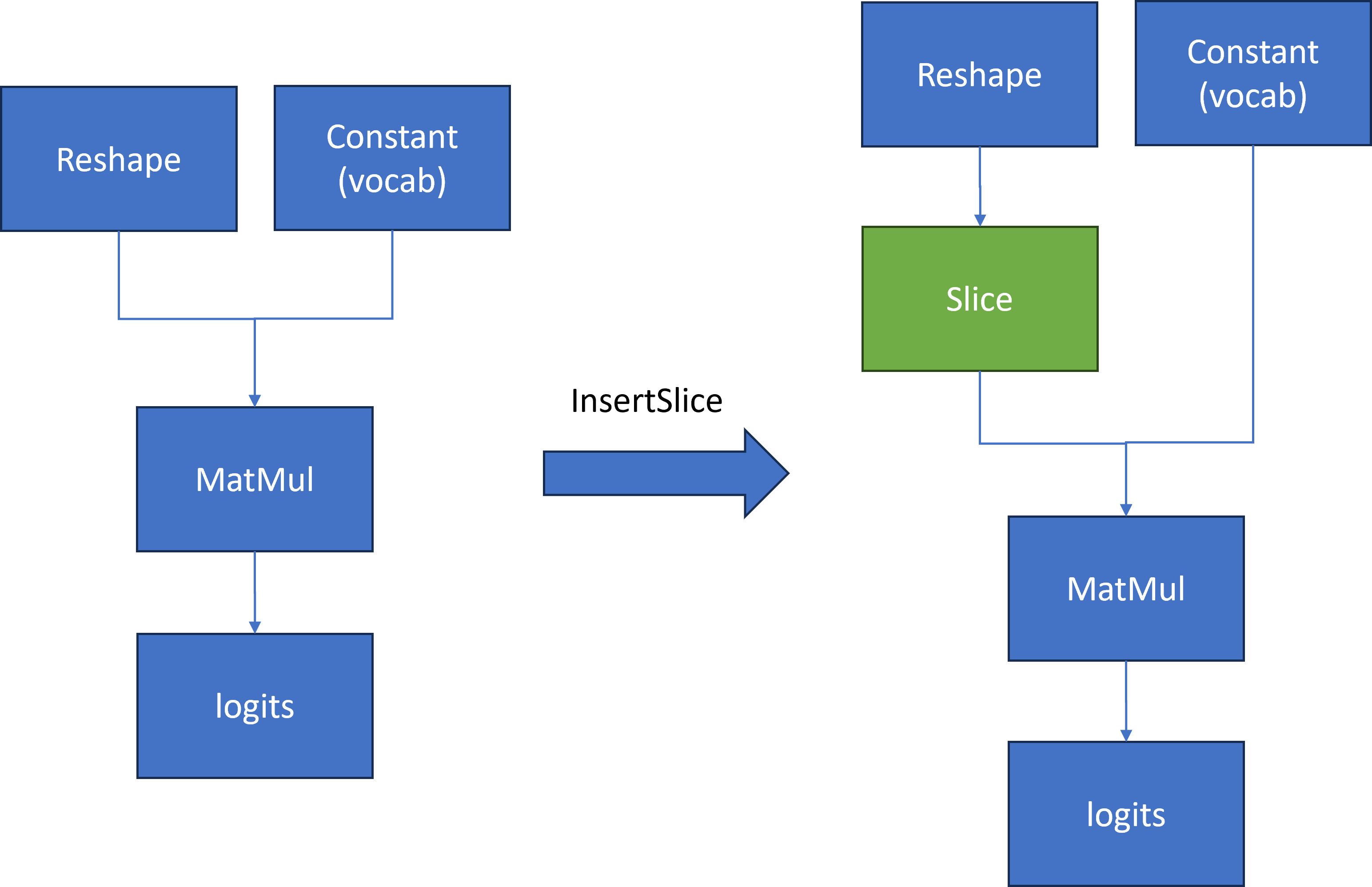
To compute the first token generation for the input prompt with shape [1, seq_length], we need to calculate a MatMul operation based on two inputs.
- First input is a reshape node output with shape[1, seq_length, 4096]
- Second input is a constant value that contains the model’s vocabulary with shape [4096,151936]
Then Matmul calculates two inputs [1, seq_length, 4096] * [4096,151936] to output large logits [1, seq_length,151936]. However, for the next token prediction, we only need the last element [1,4096] in 1st dimension from logits for sampling.
The main idea is to insert a slice operation between Reshape and Matmul nodes to extract only the last element in 2nd dimension of reshape node output as the first input with shape [1,4096] for computation. Therefore, Matmul computation can be reduced from [1, seq_len, 4096] * [1, 4096, 151936] = [1, seq_len, 151936] to [1, 1, 4096] *[4096, 151936] = [1, 1, 151936], which can reduce first token latency and memory consumption.
Here is a sample code to implement the workflow defined in Figure2 to reduce Qwen's last Matmul computation and memory usage:
We defined a OpenVINO™ transformation "InsertSlice" to find the logits (Results) node via ov::pass::MatchPass, then search along root->parent->grandparent node to find the Reshape node. Afterward, we insert a Slice node between the Reshape and Matmul nodes to extract the last element of seq_length with shape [1,1,4096]. In the end, we apply "InsertSlice" transformation to original OpenVINO™ model and save modified model on disk for deployment.
Modify model weights of specified layer in OpenVINO™ model
In case you want to update certain model layer weights after model training or fine-tuning/compression.
E.g. if you have an INT4 weight-compressed model using another model compression method, e.g. AWQ, you may want to transfer model weights optimized with the quantization method.
The most general method will be to convert the original model to OpenVINO™ model if the model direct conversion works. However, if first option is not works out of box, an alternative option is to replace the model weights from OpenVINO™ models with external fine-tuning model weights.
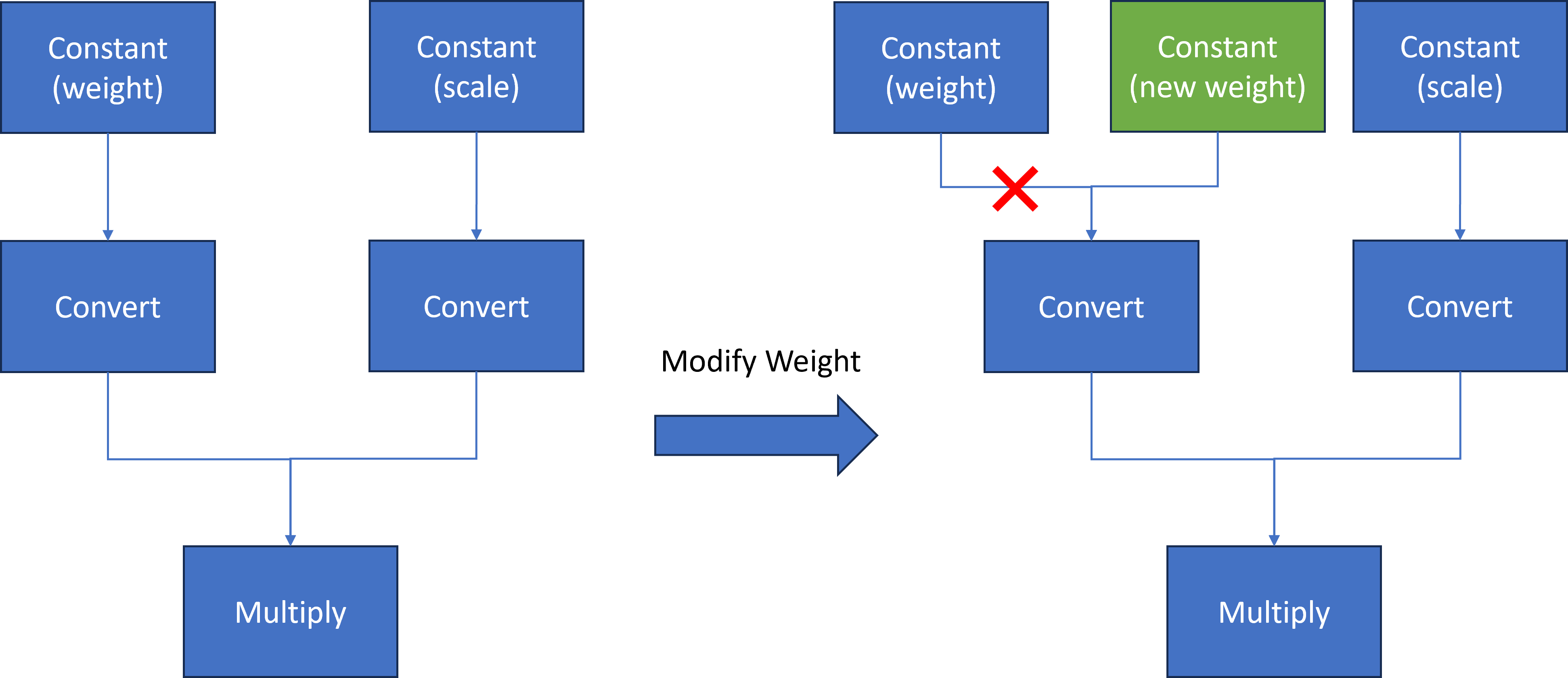
Here we introduce a common method to modify layer weights of Qwen model via OpenVINO™ transformation API.
As Figure 3 shows, the goal is to replace model weights and scale of the original Constant node with external fine-tuned weights and scale data.
At first, we use ov::pass::MatchPass method to find the Convert node after the target node. Then we create a new constant node with external weight saved as a numpy array. Please note, GPTQ int4 model weight is saved asuint4 (U4) binary format, while numpy can only represent data with numpy.uint8. Therefore, we use a help function to pack 2 uint4 binary data as 1 uint8 binary data. Then we replace the Convert input port from the original Constant node to the new Constant node. Since the old constant node has no consumers and is neither the Result nor the Sink operation whose shared pointer counter is zero, the operation will be destructed and not be accessible anymore.
Here is a sample code to implement the workflow defined in Figure3 to replace Qwen Constant node via the new Constant node with external data:
We defined a OpenVINO™ transformation "InsertWeights" to find the target constant node via ov::pass::MatchPass, then we create a new Constat node with external numpy data and pack it as uint4 OpenVINO™ Tensor to replace original constant node in graph. In the end, we apply "InsertWeights" transformation to original OpenVINO™ model and save modified model on disk for deployment.
Conclusion
In this blog, we introduce how to apply graph customization based on OpenVINO™ model with OpenVINO™ transformation API. Furthermore, we show two examples of inserting layers & modifying layer weights based on Qwen LLM model with simple Python code.
Reference
IntegrateOpenVINO™ with Your Application – Model Representation
Q4'23: Technology Update – Low Precision and Model Optimization
Authors
Alexander Kozlov, Nikita Savelyev, Nikolay Lyalyushkin, Vui Seng Chua, Pablo Munoz, Alexander Suslov, Andrey Anufriev, Liubov Talamanova, Yury Gorbachev, Nilesh Jain, Maxim Proshin
Summary
This quarter we observe that most of the work is still dedicated to the Large Language Model optimization. Researchers try to break through W4A8 quantization setup for LLMs achieving the accuracy results that allows considering such optimized models for deployment scenario. Some teams work on lower-precision settings such as 2-bit weight quantization or even binary weight compression. Interestingly, some teams propose to stick to a higher bit-width (FP6) and data-free optimization approach to avoid overfitting to calibration data. We also see an increasing interest in applying various types of weight sparsity in LLMs. And, of course, we should note the tremendous improvement in the inference time of Diffusion models caused by the decrease in the overall number of iterations in the diffusion process. This allows running variations of Stable Diffusion on mobile devices in the below 1 second.
Papers with notable results
Quantization
- AWEQ: Post-Training Quantization with Activation-Weight Equalization for Large Language Models by Jilin University (https://arxiv.org/pdf/2311.01305.pdf). Authors apply a known recipe for DL models quantization to LLM models. It contains weight equalization and bias correction methods stacked together. The difference is in how they estimate parameters and where to apply both methods. The method shows good results for W8A8 and W4A8 settings and outperforms GPTQ method on LLAMA and OPT models.
- AFPQ: Asymmetric Floating Point Quantization for LLMs by China Universities and Microsoft Research Asia (https://arxiv.org/pdf/2311.01792.pdf).Authors propose accurate asymmetric schema for the floating-point quantization. Instead of using typical asymmetric schema with scale and zero point, they use just2 scales: one is for positive values and another - for negative ones. It gives better accuracy NF4/NF3 quantization on different LLAMA models with no memory overhead. Code is available: https://github.com/zhangsichengsjtu/AFPQ.

- Enhancing Computation Efficiency in Large Language Models through Weight and Activation Quantization by Hanyang University, SAPEON Korea Inc., Seoul National University (https://arxiv.org/pdf/2311.05161.pdf). Authors present two techniques: activation-quantization-aware scaling (a trade-off between SQ and AWQ) and sequence-length-aware calibration (adaptation of OPTQ to various sequence lengths) to enhance PTQ by considering the combined effects on weights and activations and aligning calibration sequence lengths to target tasks. They also introduce dINT, a hybrid data format combining integer and denormal representations, to address the underflow issue in W4A8 quantization, where small values are rounded to zero. The combined approach allows for achieving superior results compared to baselines. However, dINT has a limitation of efficient implementation on a general-purpose HW, such as CPU and GPU.
- POST-TRAINING QUANTIZATIONWITH LOW-PRECISION MINIFLOATS AND INTEGERS ON FPGAS by AMD Research, National University of Singapore, and Tampere University (https://arxiv.org/pdf/2311.12359.pdf). Authors compare integer and mini float quantization techniques, encompassing a combination of state-of-the-art PTQ methods, such as weight equalization, bias correction, SmoothQuant, learned rounding, and GPTQ. They explore the accuracy-hardware tradeoffs, providing analysis for three models -ResNet-18, MobileNetV2, and ViT-B32 - based on a custom FPGA implementation. Experiments indicate that mini float quantization typically outperforms integer quantization for bit-widths of four or more, both for weights and activations. However, when compared against FPGA hardware cost model, integer quantization often retains its Pareto optimality due to its smaller hardware footprint at a given precision.

- I&S-ViT: An Inclusive& Stable Method for Pushing the Limit of Post-Training ViTs Quantization by Xiamen University, Tencent, and Peng Cheng Laboratory (https://arxiv.org/pdf/2311.10126.pdf). The paper introduces a method that regulates the PTQ of ViTs in an inclusive and stable fashion. It first identifies two issues in the PTQ of ViTs: (1)Quantization inefficiency in the prevalent log2 quantizer for post-Softmax activations; (2) Rugged and magnified loss landscape in coarse-grained quantization granularity for post-LayerNorm activations. Then, the method addresses these issues by introducing: (1) A novel shift-uniform-log2 quantizer(SULQ) that incorporates a shift mechanism followed by uniform quantization to achieve both an inclusive domain representation and accurate distribution approximation; (2) A three-stage smooth optimization strategy that amalgamates the strengths of channel-wise and layer-wise quantization to enable stable learning. The method achieves comparable results in the W4A4 and W3A3 quantization settings.
- Quantizable Transformers: Removing Outliers by Helping Attention Heads Do Nothing by Qualcomm AI Research (https://arxiv.org/pdf/2306.12929.pdf). This work aims to remove outliers by construction (pretraining) so that transformer can be quantized easily without the need of finer quantization granularity (e.g. per channel, per group). The authors root-caused that outliers in trained transformers are essentially the artifact of attention head attenuating uninformative tokens and outliers emerged in the formulation/backpropagation of softmax, residual connections and layer normalization to sustain the effect of these tokens. Two independent solutions are proposed - (1) Clipped softmax that allows exact zeros and ones in softmax to avoid growing outliers during training. (2) Gated attention which is a tiny neural network (linear+sigmoid) added to the vanilla attention to decouple the needs of large attention output for disregarding the uninformative tokens. Pretraining with the proposed formulation on BERT, OPT and ViT has been shown to converge similarly if not better than baseline recipe. Most notably, the ease of per-tensor int8 static quantization to both weight and activation in post-training fashion has been empirically verified. Code is coming soon at https://github.com/qualcomm-ai-research/outlier-free-transformers
- A Speed Odyssey for Deployable Quantization of LLMs by Meituan (https://arxiv.org/pdf/2311.09550.pdf).Authors propose a solution for deployable W4A8 quantization that comprises a tailored quantization configuration and a novel Fast GEMM kernel for 4-bitinteger matrix multiplication that reduces the cost, and it achieves 2.23× and1.45× speed boosting over the TensorRT-LLM FP16 and INT8 implementation respectively. The W4A8 recipe is proven mostly on par with the state-of-the-art W8A8 quantization method SmoothQuant on a variety of common language benchmarks for the state-of-the-art LLMs.
- TFMQ-DM: Temporal Feature Maintenance Quantization for Diffusion Models by SenseTime and universities of US, China and Australia (https://arxiv.org/pdf/2311.16503.pdf). Authors investigate the problems in quantization of diffusion models and claim that these models heavily depend on the time-step t to achieve satisfactory multi-round denoising when t is encoded to a temporal feature by a few modules totally irrespective of the sampling data. They propose a Temporal Feature Maintenance Quantization framework building upon a Temporal Information Block which is just related to the time-step t and unrelated to the sampling data. Powered by this block design, authors propose temporal information aware reconstruction and finite set calibration to align the full-precision temporal features in a limited time. The method achieves accurate results even in W4A8quantization setting.
- QUIK: TOWARDS END-TO-END4-BIT INFERENCE ON GENERATIVE LARGE LANGUAGE MODELS by ETH Zurich, Institute of Science and Technology Austria, Xidian University, KAUST, Neural Magic (https://arxiv.org/pdf/2310.09259v2.pdf). The paper addresses the problem where both weights and activations should be quantized. Authors show that the majority of inference computations for large generative models such as LLaMA, OPT, and Falcon can be performed with both weights and activations being cast to 4 bits, in a way that leads to practical speedups, while at the same time maintaining good accuracy. They achieve this via a hybrid quantization strategy called QUIK, which compresses most of the weights and activations to 4-bit, while keeping some outlier weights and activations in higher precision which leads to practical end-to-end throughput improvements of up to 3.4x relative to FP16 execution. Code is available at: https://github.com/IST-DASLab/QUIK.
- Post-training Quantization with Progressive Calibration and Activation Relaxing for Text-to-Image Diffusion Models by Tsinghua University (https://arxiv.org/pdf/2311.06322.pdf). Authors propose a post-training quantization method for text-to-image diffusion models, which consists of a progressive calibration strategy that considers the accumulated quantization error across timesteps, and an activation relaxing strategy that improves the performance with a small cost. They also propose a new QDiffBench benchmark, which utilizes data in the same domain for a more accurate evaluation of the generation accuracy.
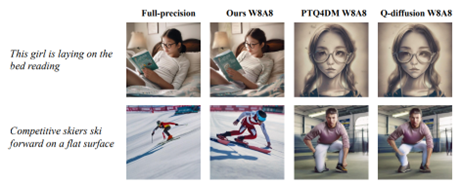
- Enabling Fast 2-bit LLM on GPUs: Memory Alignment, Sparse Outlier, and Asynchronous Dequantization by Shanghai Jiao Tong University and Tsinghua University (https://arxiv.org/pdf/2311.16442.pdf).The paper proposes range-aware quantization with memory alignment. It points out that the range of weights by groups varies. Thus, only 25% of the weights are quantized using 4-bit with memory alignment. Such a method reduces the accuracy loss for 2-bit Llama2-7b quantization from 8.7% to 2.9%. Authors show as well that only a small fraction of outliers exist in weights quantized using2-bit. These quantize these sparse outliers with < 3% increased average weight bit and improve the accuracy by >0.5%. They also accelerate GPU kernels by introducing asynchronous dequantization achieving 3.92× improvement on a kernel level.
- ZeroQuant(4+2): Redefining LLMs Quantization with a New FP6-Centric Strategy for Diverse Generative Tasks by DeepSpeed (https://arxiv.org/pdf/2312.08583.pdf).Authors show that popular data-aware LLM compression methods such as GPTQ can overfit to calibrated datasets especially on moderate-size LLMs (<=1B). They also illustrate that FP6, employing a basic round-to-nearest (RTN) algorithm and a per-channel quantization approach, consistently achieves accuracy on par with full-precision models. They propose an unpacking (mapping) scheme for FP8 so that it can be efficiently used with FP16 inference.
Pruning/Sparsity
- Sparse Fine-tuning for Inference Acceleration of Large Language Models by IST Austria, Skoltech & Yandex, and Neural Magic (https://arxiv.org/pdf/2310.06927.pdf). The paper analyses the challenges of LLMs pruning, namely loss spikes leading to divergence, poor recovery from fine-tuning, and overfitting. To overcome these issues, authors incorporate standard cross-entropy, output knowledge distillation, and a type of per-token ℓ2 knowledge distillation on top of SparseGPT method. They show that the resulting sparse models can be executed with inference speedups on CPU and GPU, especially when stacking with INT8quantization. The code is available: https://github.com/IST-DASLab/SparseFinetuning.
- ReLU Strikes Back: Exploiting Activation Sparsity in LLMs by Apple. (https://arxiv.org/pdf/2310.04564.pdf). This work advocates to reinstate ReLU as main activation function in LLMs due to its intriguing property – high post-ReLU activation sparsity can be translated to computational efficiency with sparse runtime. To overcome training from scratch and for LLMs employing GeLU/SiLU, the paper proposes “Relufication”, a two-stage uptraining by first replacing non-ReLU activations in pre-trained LLMs with ReLU, and then appending ReLU to normalization layers in second stage for more sparsity. With increase of activation sparsity, the authors also observe high overlapping activated neurons during decoding (termed aggregated sparsity) and suggest weight reuse to alleviate memory transfer. The authors show application of aggregated sparsity in speculative decoding and demonstrate 27% speedup of OPT-6.7B at a minor degradation of perplexity.
- Deja Vu: Contextual Sparsity for Efficient LLMs at Inference Time by Rice University, Zhe Jiang University, Stanford University, University of California, ETH Zurich, Adobe Research, MetaAI, Carnegie Mellon University (https://proceedings.mlr.press/v202/liu23am/liu23am.pdf). Authors propose a contextual dynamic sparsity method for LLMs. Contrary to a usual sparsity approach where a model is pruned once and then inferenced on every input sample in the same pruned state, here authors compute the set of pruned operations on the run resulting in a more flexible pruning scheme. Foreach transformer layer this is achieved by predicting set of MHA heads and MLP matrix columns to exclude based on previous layers activations. Prediction is performed by small separately trained perceptron networks. To remove the performance bottleneck produced by the need to inference of perceptron networks authors propose to make sparsity predictions for (i+1)-th transformer layer based on activations from (i-1)-th layer, resulting in parallel computation of i-th layer and sparsity sets for (i+1)-th layer. This is viable due to shown similarity between activations of neighboring layers in LLMs. For OPT-175Bmodel the approach achieves over 6x performance improvement compared to Hugging Face implementation and over 2x improvement compared to state-of-the-art FasterTransformer model.
- SparseByteNN: A Novel Mobile Inference Acceleration Framework Based on Fine-Grained Group Sparsity by ByteDance (https://arxiv.org/pdf/2310.19509.pdf). The paper introduces SparseByteNN, consisting of three components: a)compression algorithm component, which provides out-of-the-box pruning capabilities for pre-trained models b) model conversion tool, which converts the model IR of the training framework into Model IR of sparse engine c) sparse inference engine, which provides efficient inference implementation compatible with CPUs for fine-grained kernel group sparsity. Experimental results on Qualcomm 855 show that for 30% sparse MobileNet-v1, SparseByteNN achieves 1.27×speedup over the dense version. The code will be available at: https://github.com/lswzjuer/SparseByteNN.
Neural Architecture Search
- LoNAS: Elastic Low-Rank Adapters for Efficient Large Language Models by Anonymous (https://openreview.net/pdf?id=pzB-1OCS6gd). Researchers demonstrate a novel integration of low-rank (LoRA)adapters with Neural Architecture Search. LoNAS efficiently fine-tunes and compress large language models (LLMs). A weight-sharing super-network is generated using the frozen weights of the input model, and the attached elastic low-rank adapters. The reduction in trainable parameters results in less the memory requirements to train the super-network, enabling the manipulation of LLMs in resource-constrained devices, without sacrificing the performance of the resulting compressed models. LoNAS’ high-performing compressed models result in faster inference times, cost savings during the model’s lifetime, and an increase in the range of devices in which large language models can be deployed. Experiments’ results on six reasoning datasets demonstrate the benefits of LoNAS.
- Bridging the Gap between Foundation Models and Heterogenous Federated Learning by Iowa State U. and Intel Labs (https://arxiv.org/abs/2310.00247). This paper explores the application of Neural Architecture Search (NAS) in combination with Federated Learning (FL). The proposed framework, Resource-aware Federated Foundation Models (RaFFM) introduces model compression and salient parameter prioritization in the context of Federated Learning, allowing for the collaborative training of large foundation models using heterogeneous devices. Compared to traditional FL methods, RaFFM yields better resource utilization, without sacrificing in model performance.
- Rankitect: Ranking Architecture Search Battling World-class Engineers at Meta Scale by Meta Platforms (https://arxiv.org/pdf/2311.08430.pdf). Researchers at Meta demonstrate the real-world applications of Neural Architecture Search (NAS). They apply NAS to production models, e.g., Click Through Rate (CTR) model, on a system that serves billions of users. The baseline models explored in this work have already been optimized by world-class engineers. The proposed NAS framework, Rankitect, improves over existing models by exploring search spaces with no inductive bias from the baseline models, and discovers new models from scratch that outperform those hand-crafted by human experts. Rankitect also keeps human engineers in-the-loop by allowing the manual design of search spaces, which results in even more efficient models.
- QuadraNet: Improving High-Order Neural Interaction Efficiency with Hardware-Aware Quadratic Neural Networks by George Mason University, University of Maryland, University at Buffalo, Peking University (https://arxiv.org/pdf/2311.17956.pdf). This paper presents QuadraNet, a new neural network design methodology based on efficient quadratic neurons that captures high-order neural interactions similar to Transformer-based models. The design of this alternative to Transformer-based models is hardware-aware through the application of Neural Architecture Search(NAS). Experiments with QuadraNets show improvements of 1.5x in throughput without any reduction in accuracy compared to their Transformer-based counterparts.
Other
- Divergent Token Metrics: Measuring degradation to prune away LLM components – and optimize quantization by Aleph Alpha, Hessian.AI and German Universities. (https://arxiv.org/pdf/2311.01544.pdf). The work highlights that the commonly used perplexity (PPL) metric in compression research does not reflect the degradation of compressed model and cannot distinguish subtleties (see figure below). The authors propose a family of divergent token metrics (DTM), namely First Token Divergence, i.e., when the first diverging token happens w.r.t baseline generated text, as well as Share of Divergent Tokens denoting the total number of divergent tokens. In a series of experiments pertaining to layer-wise quantization or pruning, DTM-based ranking consistently outperforms PPL-based ranking methods.

- SIMPLIFYING TRANSFORMERBLOCKS by ETH Zurich (https://arxiv.org/pdf/2311.01906.pdf). The paper introduces a set of Transformer block pruning techniques that makes them more lightweight from the number of parameters and computations standpoint. This set includes: removing skip connection both in the Attention sub-block and Feed-Forward sub-block, removing value and projection parameters, removing normalization layers, and model depth scaling. Authors also show how to recover the accuracy after model perturbation using fine-tuning. The proposed method produces the decoder and decoder Transformer models that perform on part with their baselines: 15% faster training throughput, and using 15% fewer parameters.
- MobileDiffusion: Subsecond Text-to-Image Generation on Mobile Devices by Google (https://arxiv.org/pdf/2311.16567.pdf).The paper presents a comprehensive guide for crafting highly efficient text-to-image diffusion models. Authors applied the following tricks to highly optimize UNet model in the Diffusion pipeline: more transformers in the middle of Unet (at lower resolution), retaining cross-attention layers while discarding only the self-attention layers at high resolutions, sharing key-value projections, replacing gelu with swish, fine-tune softmax into relu, trim feed-forward layers, use separable convolution, prune redundant residual blocks, reduce sampling iterations, knowledge distillation. The resulting model is able to generate 512×512 images in sub-second on mobile devices: 0.2 second on iPhone 15 Pro.

- Online Speculative Decoding by UC Berkeley, UCSD, Sisu Data, SJTU (https://arxiv.org/pdf/2310.07177.pdf). Practical speedup of speculative decoding is often impeded by the capability gap between draft and target model which can be 10-20X gap in parameters, leading to high rejection of draft predictions and fallback to more forward passes of target model. This work proposes online fine-tuning of draft model by distillation with the readily available rejected predictions. The proposed solution incorporates a replay buffer tracking logits of draft and target model, and distillation backpropagation is executed at a regular interval. Experimental results demonstrate not only significant improvement in acceptance rate, translating up to a theoretical 3X of latency reduction, but also adaptability against distribution shift in input queries.
- Token Fusion: Bridging the Gap between Token Pruning and Token Merging by Michigan State University Samsung Research America (https://arxiv.org/pdf/2312.01026.pdf).The paper introduces a method (ToFu) that combines token pruning and token merging. ToFu dynamically adapts to each layer’s properties, ensuring optimal performance based on the model’s functional linearity with respect to the interpolation in its input. Authors exploit MLERP merging technique, an enhancement over traditional average merging, inspired by the SLERP method. This approach merges tokens while preserving their norm distribution. Evaluation shows that ToFu outperforms ToMe in terms of accuracy while showing the similar performance gain at inference.
Deep Learning Software
- Medusa: Simple Framework for Accelerating LLM Generation with Multiple Decoding Heads by Together.AI. Contemporary speculative decoding solutions (Leviathan et al., Chen et al.) require multiple models (target and draft models) which often involves intricate optimization& selection of draft models to attain practical acceleration. For simplicity, Together.AI unveils a user-friendly framework, Medusa, built a top of a research work in 2018, "Block wise Parallel Decoding", with multiple enhancements. Medusa simplifies the creation of draft models without separate models by extending base model with multiple decoding heads. By keeping the base model frozen, the Medusa heads are trained in a parameter-efficient way and all on a single GPU. Medusa also features a tree-based attention mechanism for parallel evaluation of the proposed candidates, and a truncated sampling for efficient creative generation. Results and framework can be found at https://github.com/FasterDecoding/Medusa.
- HyperAttention: Long-context Attention in Near-Linear Time by Yale University and Google https://github.com/insuhan/hyper-attn. Authors propose algorithm that consists of (1) finding heavy entries inattention matrix and (2) column subsampling. For (1), authors use the sorted locality sensitive hashing (sortLSH) based on the Hamming distance. Applying sortLSH makes heavy entries in the attention matrix (sorting rows/columns) located in near diagonal hence authors do block-diagonal approximation which can be done fast. The method supports casual masking. Code is available here: https://github.com/insuhan/hyper-attn.
- Flash-Decoding for long-context inference by Stanford University. Flash Attention v1 & v2 are designed and optimized primarily for training case and exhibit low utilization of compute units when applied for LLM generation, especially for long context. As identified cause is rooted in low- batch size (query tokens) in relative to context length, Flash Decoding extends flash attention by adding 2nd-level tiling over the keys/values to improve compute utilization while retaining memory efficiency of flash attention. On A100, the micro-benchmark for multi-head attention with flash decoding kernel achieves almost constant run-time as the sequence length scales to up to 64k, translating up to 8X speedup of CodeLLaMa-34b over vanilla flash attention at very long sequences. Implementation is available at official flash attention repo & xformers.
- LLM in a flash: Efficient Large Language Model Inference with Limited Memory by Apple (https://arxiv.org/pdf/2312.11514.pdf).The paper tackles the challenge of efficiently running LLMs that exceed the available DRAM capacity by storing the model parameters on flash memory but bringing them on demand to DRAM. The method involves constructing an inference cost model that harmonizes with the flash memory behavior, guiding to optimize in two critical areas: reducing the volume of data transferred from flash and reading data in larger, more contiguous chunks. Within this flash memory-informed framework, authors introduce two principal techniques. First, “windowing” strategically reduces data transfer by reusing previously activated neurons, and second, “row-column bundling”, tailored to the sequential data access strengths of flash memory, increases the size of data chunks read from flash memory. These methods collectively enable running models up to twice the size of the available DRAM, with a 4-5x and 20-25x increase in inference speed compared to naive loading approaches in CPU and GPU, respectively.
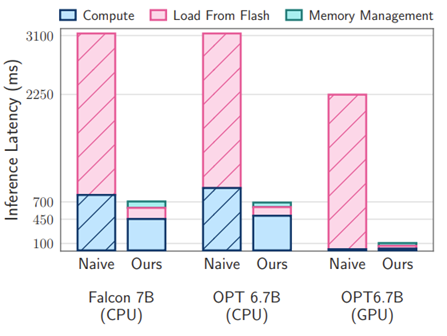
Accelerate DIEN for Click-Through-Rate Prediction with OpenVINO™
Author: Xiake Sun, Cecilia Peng
Introduction
A click-through rate (CTR) prediction model is designed to estimate how likely a user will click on an advertisement or item. Deployment of a CTR model is considered one of the core tasks in e-commerce, as its performance not only affects platform revenue but also influences customers’ online shopping experience.
Deep Interest Evolution Network (DIEN) developed by Alibaba Group aims to better predict customer’s CTR to improve the effectiveness of advertisement display. DIEN proposes the following two modules:
- Temporally captures and extracts latent interests based on customer history behaviors.
- Models an evolving process of user interests using GRU with an attentional update gate (AUGRU)
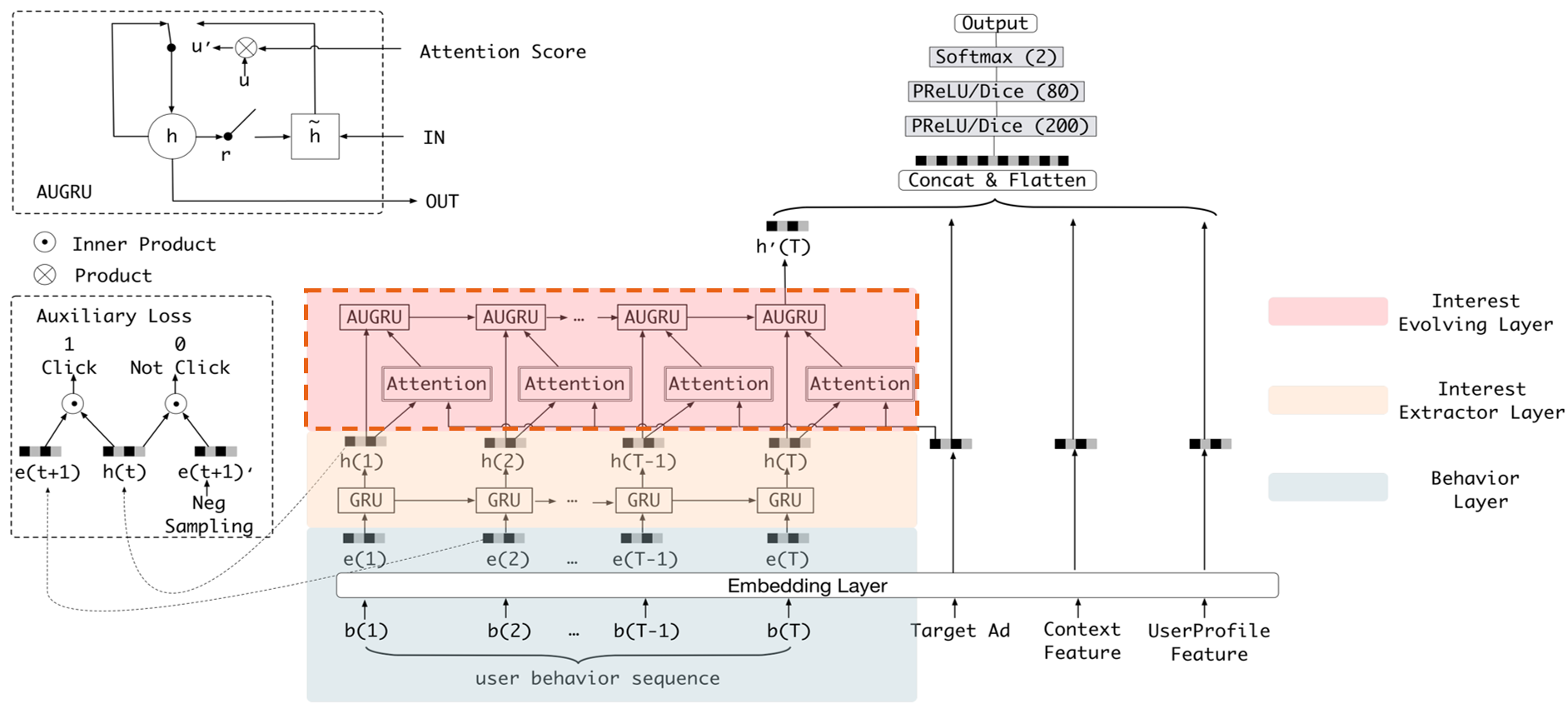
Figure 1 shows the structure of DIEN, with the help of AUGRU, DIEN can overcome the disturbance from interest drifting, which improves the performance of CTR prediction largely in online advertising system.
DIEN Optimization with OpenVINOTM
Here we introduce DIEN optimization with OpenVINOTM in two aspects: graph level and dynamism runtime optimization.
Graph Level Optimization
Figure 2 shows the AUGRU subgraph of DIEN visualized in Netron.

OpenVINOTM implements internal operations AUGRUCell and AUGRUSequence for better graph-level optimization. Each decomposed subgraph of GRU and AUGRU is fused into a corresponding cell operator respectively. What's more, in case of static sequence length, the group of consecutive cells are further fused into a sequence operator. In case of dynamic sequence length, however, the sequence is processed with a loop of cells due to the limitation of oneDNN RNN primitive. This loop of cells is TensorIterator and (AU)GRUCell. We will introduce the optimizations of TensorIterator in next session.
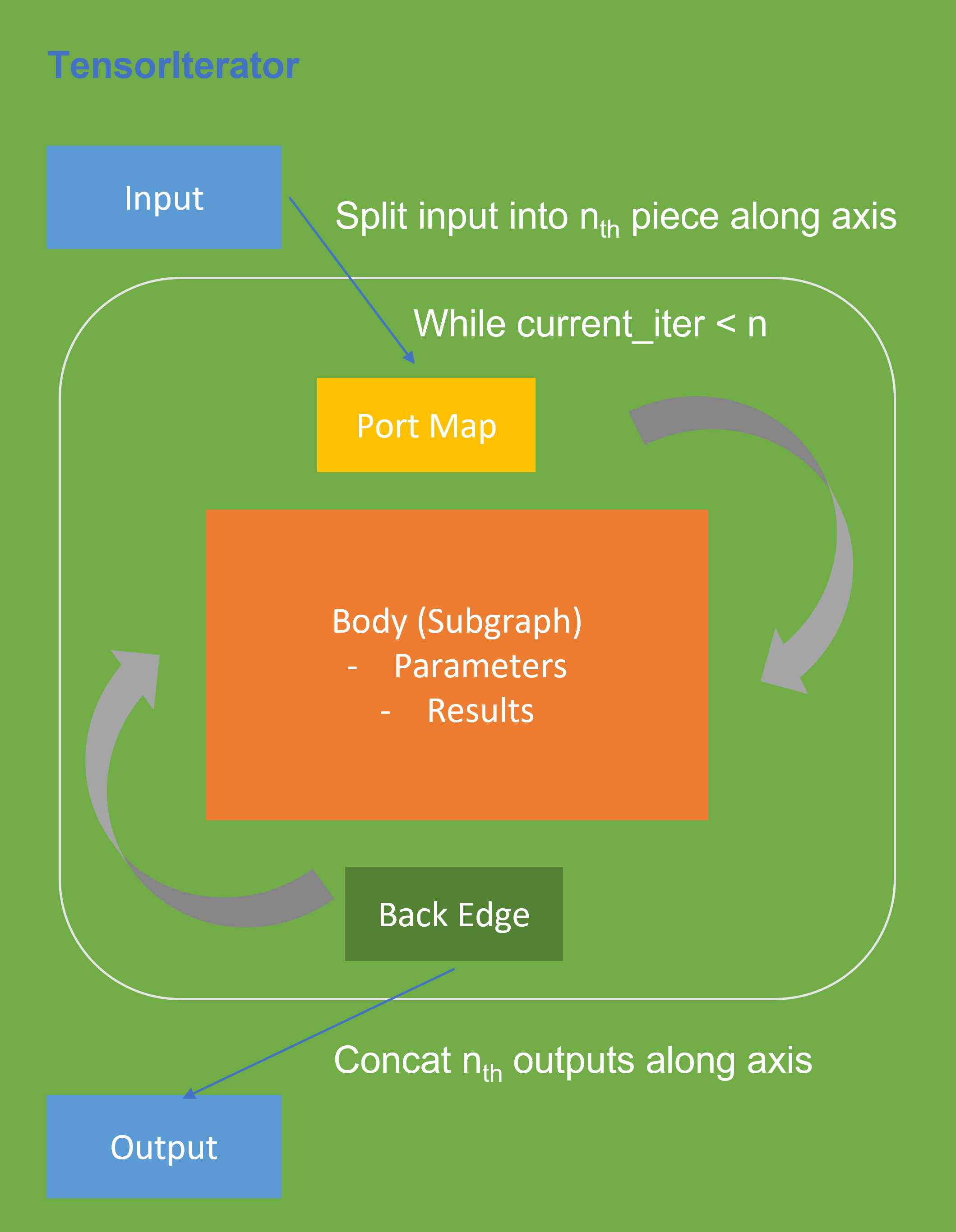
TensorIterator Runtime Optimization with Dynamic Shape
Before we dive into optimization details, let’s first checkout how OpenVINOTM TensorIterator operation works.
The TensorIterator layer performs recurrent execution of thenetwork, which is described in the body, iterating through the data. Figure 3 shows the workflow of OpenVINOTM Operation TensorIterator in a simplified view. For details, please refer to the specification.
Similar to other layers, TensorIterator has regular sections: input and output. It allows connecting TensorIterator to the rest of the IR. TensorIterator also has several special sections: body, port_map, back_edges. The principles of their work are described below.
- body is a network that will be recurrently executed. The network is described layer by layer as a typical IR network.
- port_map is a set of rules to map input or output data tensors of TensorIterator layer onto body data tensors. The port_map entries can be input and output. Each entry describes a corresponding mapping rule.
- back_edges is a set of rules to transfer tensor values from body outputs at one iteration to body parameters at the next iteration. Back edge connects some Result layers in body to Parameter layer in the same body.
If output entry in the Port map doesn’t have partitioning (axis, begin, end, strides) attributes, then the final value of output of TensorIterator is the value of Result node from the last iteration. Otherwise, the final value of output of TensorIterator is a concatenation of tensors in the Result node for all body iterations.
We use Intel® VTune™ Profiler to run benchmark_app with DIEN FP32 IR model on Intel® Xeon® Gold 6252N Processor for performance profiling.
Cache internal reorder primitives in TensorIterator
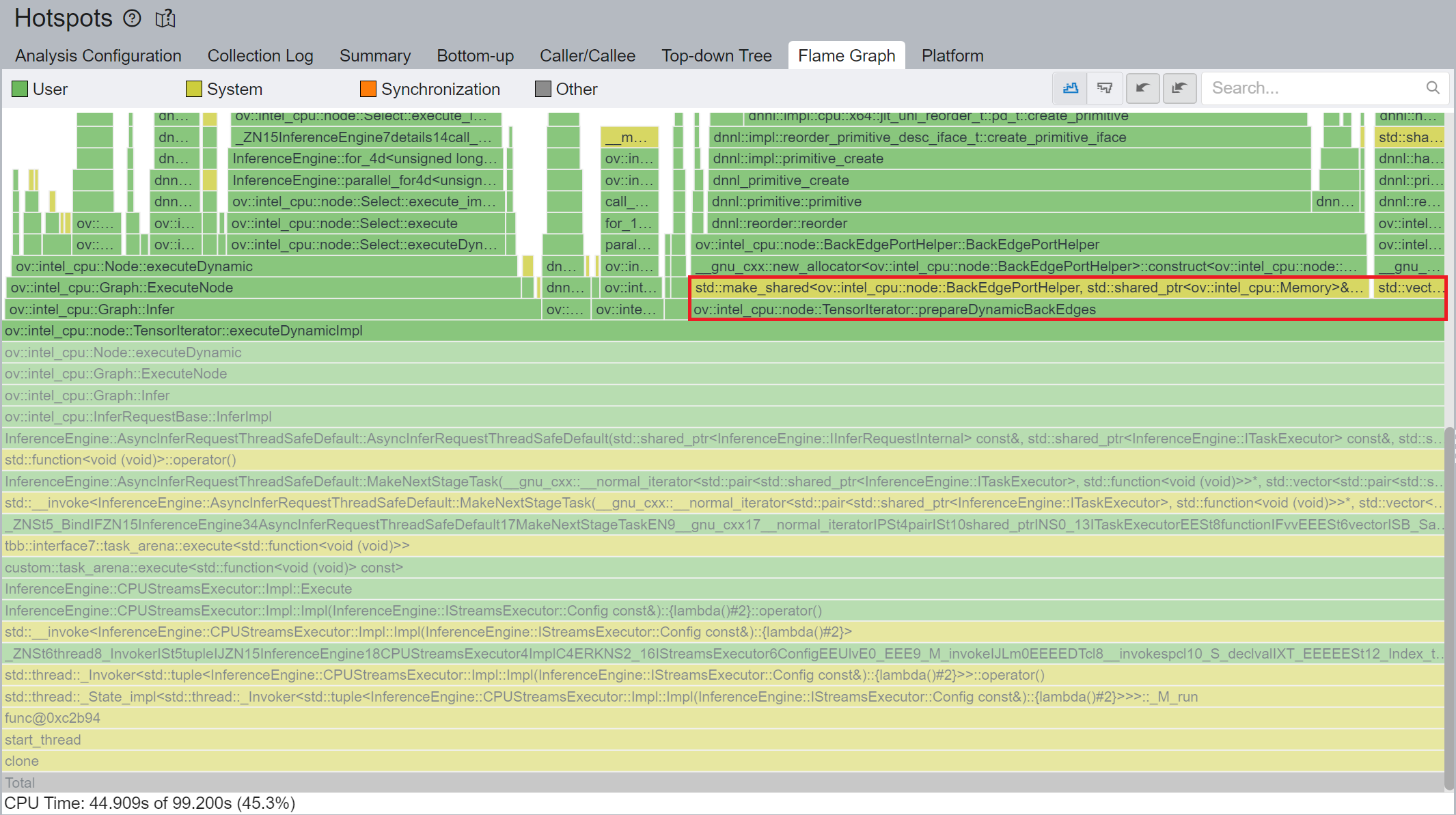
Figure 4 shows that TensorIterator::prepareDynamicBackEdges() spends nearly 45% CPU time to create the reorder primitives. DIEN FP32 model has 2 TensorIterator, eachTensorIterator runs 100 iterations in body with the same input/output shape regarding the current batch. Besides, each TensorIterator has 7 back edges, which means the reorder primitive are frequently created.
So, we propose to cache internal reorder primitive in TensorIterator to optimize back edge memory copy logic. With this optimization, the performance with dynamic shape can be improved by 8x times.
Memory allocation and reuse optimization in TensorIterator
As Figure 3 shows, if we have split input as nth piece to loop in body, at the end, the outputs of TensorIterator will be a concatenation of tensors in the Result node for all body iterations, which can lead to performance overhead. Based on previous optimization we re-run performance profiling using benchmark_app with DIEN FP32 IR model on Intel® Xeon® Gold 6252N Processor as showed in Figure 5.
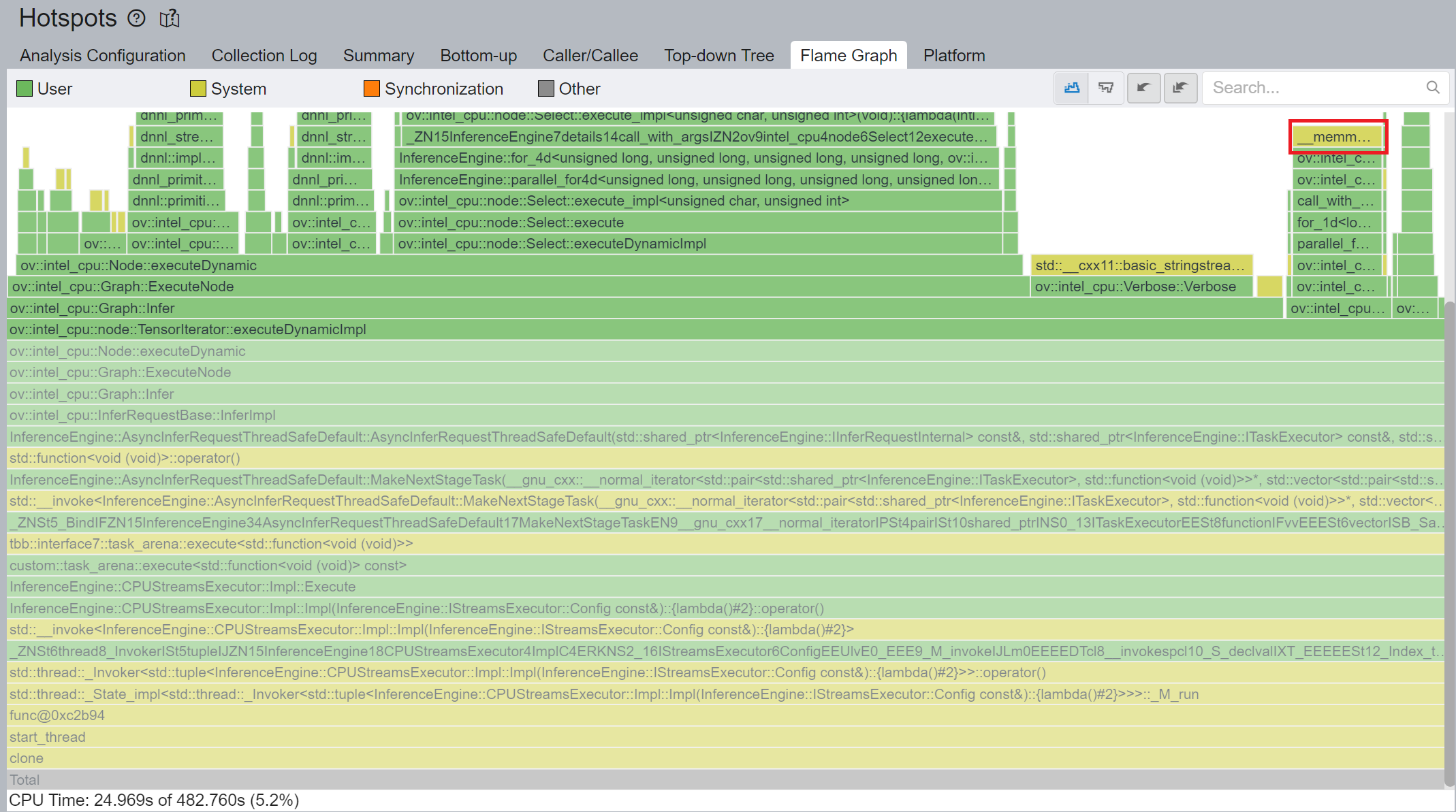
CPU plugin TensorIterator supports both two operators - TensorIterator and Loop. The outputs of each iteration could be concatenated and return to users. Since the output size is not always known before the execution, the legacy implementation is to dynamically allocate the concatenated output buffer.
We propose two points from the memory allocation standpoint:
- In the case of TensorIterator number of iterations is determined by the size of the axis we are slicing. So, if TensorIterator body one ach iteration will produce the same shape on output we can easily preallocate enough memory before the TI computation, The same for Loop with trip count input - we can just read the value from this input, make shape inference for the body and this determines the required amount of memory.
- More complicated story is when we don't know exact number of iterations before Loop inference (e.g., number of iterations is determined by ExecutionCondition input). In that case do the following: let’s have an output buffer where we put the Loop output. Once the buffer doesn't have enough space, we reallocate it on new size based on a simple and effective dynamic array algorithm.
OpenVINOTM implemented memory allocation and reuse optimization in TensorIterator to significantly reduce the number of reallocations and not to allocate to much memory at the same time. Experiments show that performance can be further improved by more than 20%.
DIEN OpenVINOTM Demo
Clone demo repository:
Prepare Amazon dataset:
Setup Python Environment:
Convert original TensorFlow model to OpenVINOTM FP32 IR:
Run the Benchmark with TensorFlow backend:
Run the Benchmark with OpenVINOTM backend using FP32 inference precision:
Run the Benchmark with OpenVINOTM backend using BF16 inference precision:
Please note, Xeon native supports BF16 infer precision since 4th Generation Intel® Xeon® Scalable Processors. Running BF16 on a legacy Xeon platform may lead to performance degradation.
Conclusion
In this blog, we introduce inference optimization of DIEN recommendation model with OpenVINOTM runtime as follows:
- For static input sequence length, AUGRU subgraph will be decomposed and fused as AUGRU and AUGRUSequence OpenVINOTM internal operation.
- For dynamic input sequence length, we propose cache internal reorder primitives and memory allocation and re-use optimization in TensorIterator.
- Provide a demo for model enabling and efficient inference of DIEN with OpenVINOTM runtime.
Reference
Deep Interest Evolution Network (DIEN)
Enable chatGLM by creating OpenVINO™ stateful model and runtime pipeline
Authors: Zhen Zhao(Fiona), Cheng Luo, Tingqian Li, Wenyi Zou
Introduction
Since the Large Language Models (LLMs) become the hot topic, a lot Chinese language models have been developed and actively deployed in optimization platforms. chatGLM is one of the popular Chinese LLMs which are widely been evaluated. However, ChatGLM model is not yet a native model in Transformers, which means there remains support gap in official optimum. In this blog, we provide a quick workaround to re-construct the model structure by OpenVINO™ opset contains custom optimized nodes for chatGLM specifically and these nodes has been highly optimized by AMX intrinsic and MHA fusion.
*Please note, this blog only introduces a workaround of optimization method by creating OpenVINO™ stateful model for chatGLM. This workaround has limitation of platform, which requires to use Intel® 4th Xeon Sapphire Rapids with AMX optimization. We do not promise the maintenance of this workaround.
Source link: https://github.com/luo-cheng2021/openvino/tree/luocheng/chatglm_custom/tools/gpt
To support more LLMs, including llama, chatglm2, gpt-neox/dolly, gpt-j and falcon. You can refer this link which not limited on SPR platform, also can compute from Core to Xeon:
Source link: https://github.com/luo-cheng2021/ov.cpu.llm.experimental
ChatGLM model brief
If we check with original model source of chatGLM, we can find that the ChatGLM is not compatible with Optimum ModelForCasualML, it defines the new class ChatGLMForConditionalGeneration. This model has 3 main modules (embedding, GLMBlock layers and lm_logits) during the pipeline loop, the structure is like below:
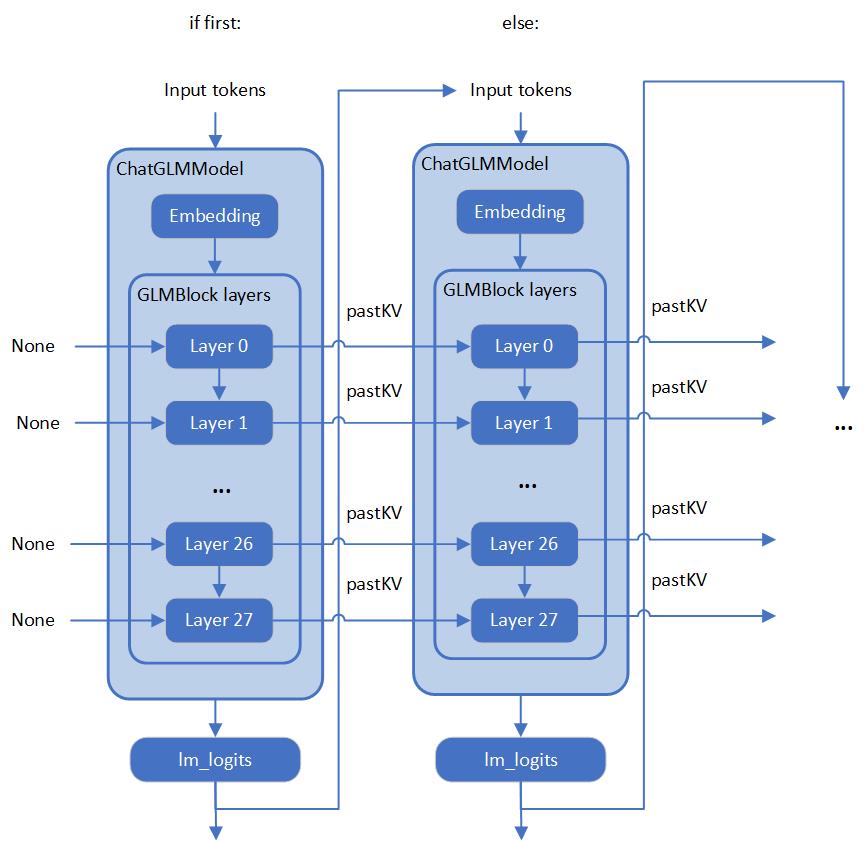
As you can see, the whole pipeline actually require model with two different graphs, the first-time inference with input prompt tokens do not require KV cache as inputs for GLMBlock layers. Since the second iteration, the previous results of QKV Attention should become the inputs of current round model inference. Along with the length of generated token increased, there will remain a lot of large sized memory copies between model inputs and outputs during pipeline inference. We can use ChatGLM6b default model configurations as an example, the memory copies between input and output arrays are like below pseudocode:
Therefore, two topics is the most important:
- How we can optimize model inference pipeline to eliminate memory copy between model inputs and outputs
- How we can put optimization efforts on GLMBlock module by reinvent execution graph
Extremely optimization by OpenVINO™ stateful model
Firstly, we need to analyze the structure of GLMBlock layer, and try to encapsulate a class to invoke OpenVINO™ opset with below workflow. Then serialize the graph to IR model(.xml, .bin).

To build an OpenVINO™ stateful model, you can refer to this document to learn.
https://docs.openvino.ai/2022.3/openvino_docs_OV_UG_network_state_intro.html
OpenVINO™ also provide model creation sample to show how to build a model by opset.
https://github.com/openvinotoolkit/openvino/blob/master/samples/cpp/model_creation_sample/main.cpp
It is clear to show that the emphasized optimization block is the custom op of Attention for chatGLM. The main idea is to build up a global context to store and update pastKV results internally, and then use intrinsic optimization for Rotary Embedding and Multi-Head Attentions. In this blog, we provide an optimized the attention structure of chatGLM with AMX intrinsic operators.
At the same time, we use int8 to compress the weights of the Fully Connected layer, you are not required to compress the model by Post Training Quantization (PTQ) or process with framework for Quantization Aware Training(QAT).
Create OpenVINO™ stateful model for chatGLM
Please prepare your hardware and software environment like below and follow the steps to optimize the chatGLM:
Hardware requirements
Intel® 4th Xeon platform(codename Sapphire Rapids) and above
Software Validation Environment
Ubuntu 22.04.1 LTS
python 3.10.11 for OpenVINO™ Runtime Python API
GCC 11.3.0 to build OpenVINO™ Runtime
cmake 3.26.4
Building OpenVINO™ Source
- Install system dependency and setup environment
- Create and enable python virtual environment
- Install python dependency
- Build OpenVINO™ with GCC 11.3.0
- Clone OpenVINO™ and update submodule
- Install python dependency for building python wheels
- Create build directory
- Build OpenVINO™ with CMake
- Install built python wheel for OpenVINO™ runtime and openvino-dev tools
- Check system gcc version and conda runtime gcc version. If the system gcc version is higher than conda gcc version like below, you should update conda gcc version for OpenVINO runtime. (Optional)
- convert pytorch model to OpenVINO™ IR
Use OpenVINO Runtime API to build Inference pipeline for chatGLM
We provide a demo by using transformers and OpenVINO™ runtime API to build the inference pipeline. In test_chatglm.py, we create a new class which inherit from transformers.PreTrainedModel. And we update the forward function by build up model inference pipeline with OpenVINO™ runtime Python API. Other member functions are migrated from ChatGLMForConditionalGeneration from modeling_chatglm.py, so that, we can make sure the input preparation work, set_random_seed, tokenizer/detokenizer and left pipelined operation can be totally same as original model source.
To enable the int8 weights compress, you just need a simple environment variable USE_INT8_WEIGHT=1. That is because during the model generation, we use int8 to compress the weights of the Fully Connected layer, and then it can use int8 weights to inference on runtime, you are not required to compress the model by framework or quantization tools.
Please follow below steps to test the chatGLM with OpenVINO™ runtime pipeline:
- Run bf16 model
- Run int8 model
Weights compression reduces memory bandwidth utilization to improve inference speed
We use VTune for performance comparison analysis of model weights bf16 and int8. Comparative analysis of memory bandwidth and CPI rate (Table 1). When model weight is compressed to int8, it can reduce memory bandwidth utilization and CPI rate.



Clockticks per Instructions Retired(CPI) event ratio, also known as Cycles per Instructions, is one of the basic performance metrics for the hardware event-based sampling collection, also known as Performance Monitoring Counter (PMC) analysis in the sampling mode. This ratio is calculated by dividing the number of unhalted processor cycles(Clockticks) by the number of instructions retired. On each processor the exact events used to count clockticks and instructions retired may be different, but VTune Profiler knows the correct ones to use.
A CPI < 1 is typical for instruction bound code, while a CPI > 1 may show up for a stall cycle bound application, also likely memory bound.
Conclusion
Along with the upgrading of OpenVINO™ main branch, the optimization work in this workaround will be generalized and integrated into official release. It will be helpful to scale more LLMs model usage. Please refer OpenVINO™ official release and Optimum-intel OpenVINO™ backend to get official and efficient support for LLMs.
Q4'24: Technology Update – Low Precision and Model Optimization
Authors
Alexander Kozlov, Nikolay Lyalyushkin, Nikita Savelyev, Souvikk Kundu, Andrey Anufriev, Pablo Munoz, Alexander Suslov, Liubov Talamanova, Daniil Lyakhov, Yury Gorbachev, Nilesh Jain, Maxim Proshin
Summary
What a quarter! Tons of works for Transformer model optimization in Q4’24 including fundamental ones such as “scaling lows for quantized LLMs“. Such a huge effort can indicate a growing adoption of LLMs and AI in general and the need for a further cost reduction. We had to extend the Highlights to six papers this time considering the amount of work being done.
Highlights
- Scaling Laws for Precision by Harvard, Stanford, MIT, Carnegie Mellon Universities, and Databricks (https://arxiv.org/pdf/2411.04330). In this work, authors devise “precision-aware” scaling laws for both training and inference. They propose that training in lower precision reduces the model’s effective parameter count, allowing predicting the additional loss incurred from training in low precision and post-train quantization. For inference, they find that the degradation introduced by post-training quantization increases as models are trained on more data, eventually making additional pretraining data actively harmful. For training, their scaling laws allow predicting the loss of a model with different parts in different precisions and suggest that training larger models in lower precision may be compute optimal. Authors unify the scaling laws for post and pretraining quantization to arrive at a single functional form that predicts degradation from training and inference in varied precisions. They fit on over 465 pretraining runs and validate our predictions on model sizes up to 1.7B parameters trained on up to 26B tokens.

- Low-Bit Quantization Favors Undertrained LLMs: Scaling Laws for Quantized LLMs with100T Training Tokens by University of Virginia, Tencent AI Lab Seattle (https://arxiv.org/pdf/2411.17691).Authors propose a perspective that one can use to measure an LLM’s training levels and determine the number of training tokens required for fully training LLMs of various sizes. Moreover, authors use the scaling laws to predict the quantization performance of different-sized LLMs trained with 100 trillion tokens. Our projection shows that the low-bit quantization performance of future models, which are expected to be trained with over 100 trillion tokens, may NOT be desirable. This poses a potential challenge for low-bit quantization in the future and highlights the need for awareness of a model’s training level when evaluating low-bit quantization research. Checkpoints are available at: https://huggingface.co/Xu-Ouyang.

- Hymba: A Hybrid-head Architecture for Small Language Models by Nvidia, Georgia Institute of Technology, and HKUST (https://www.arxiv.org/abs/2411.13676).The paper introduces a family of small language models featuring a hybrid-head parallel architecture that integrates transformer attention mechanisms with state space models (SSMs) for enhanced efficiency. Additionally, authors introduce learnable meta tokens that are prepended to prompts, storing critical information. This model is further optimized by incorporating cross-layer key-value (KV) sharing and partial sliding window attention, resulting in a compact cache size. Hymba-1.5B-Base model surpasses all sub-2B public models in performance and even outperforms Llama-3.2-3B with1.32% higher average accuracy, an 11.67× cache size reduction, and 3.49×throughput. Models are available on the Hugging Face Hub.
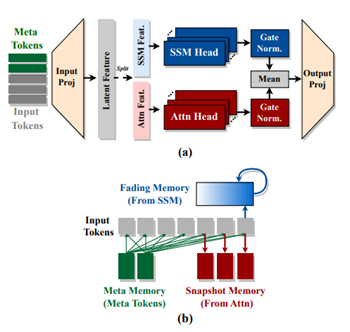
- THE SUPER WEIGHT IN LARGE LANGUAGE MODELS by Apple and University of Notre Dame (https://arxiv.org/pdf/2411.07191). This work presents a finding that pruning single parameters can destroy an LLM’s ability to generate text – increasing perplexity by 3 orders of magnitude and reducing zero-shot accuracy to guessing. It proposes a data-free method for identifying such parameters, termed super weights, using a single forward pass through the model. Authors find that these super weights induce correspondingly rare and large activation outliers, termed super activations. When preserved with high precision, super activations can improve simple round-to-nearest quantization to become competitive with state-of-the-art methods. For weight quantization, they similarly find that by preserving the super weight and clipping other weight outliers, round-to-nearest quantization can scale to much larger block sizes than previously considered. The code is available at n https://github.com/mengxiayu/LLMSuperWeight.

- Pushing the Limits of Large Language Model Quantization via the Linearity Theorem by Yandex, HSE University, ISTA, GenAI CoE, KAUST, Neural Magic (https://arxiv.org/pdf/2411.17525). The paper presents a “linearity theorem” establishing a direct relationship between the layer-wise ℓ2 reconstruction error and the model perplexity increase due to quantization. This enables two novel applications: (1) a simple data-free LLM quantization method using Hadamard rotations and MSE-optimal grids, dubbed HIGGS, which outperforms all prior data-free approaches such as the extremely popular NF4 quantized format, and (2) an optimal solution to the problem of finding non-uniform per-layer quantization levels which match a given compression constraint in the medium-bit width regime, obtained by reduction to dynamic programming. Authors demonstrate improved accuracy-compression trade-offs on Llama-3.1 and 3.2- family models, as well as on Qwen-family models.
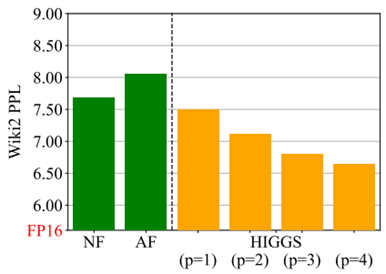
- SANA:EFFICIENT HIGH-RESOLUTION IMAGE SYNTHESIS WITH LINEAR DIFFUSION TRANSFORMERS by NVIDIA, MIT, Tsinghua University (https://arxiv.org/pdf/2410.10629). Authors introduce Sana, a text-to-image frame work that can generate images up to 4096×4096 resolution. Core designs include: (1) Deep compression autoencoder: unlike traditional AEs, which compress images only 8×,authors trained an AE that can compress images 32×, effectively reducing the number of latent tokens. (2) Linear DiT: they replace all vanilla attention in DiT with linear attention (3) Decoder-only text encoder: they replaced T5 with modern decoder-only small LLM as the text encoder and designed complex human instruction with in-context learning to enhance the image-text alignment. (4) Efficient training and sampling: they propose Flow-DPM-Solver to reduce sampling steps. As a result, Sana-0.6B is very competitive with modern giant diffusion model (e.g. Flux-12B), being 20times smaller and 100+ times faster in measured throughput. Project web page with code: https://nvlabs.github.io/Sana/.

Papers with notable results
Quantization
- VPTQ: EXTREME LOW-BIT VECTOR POST-TRAINING QUANTIZATION FOR LARGE LANGUAGE MODELS by Microsoft and University of Science and Technology of China (https://arxiv.org/abs/2409.17066). The authors introduce Vector Post-Training Quantization and use Second-Order Optimization to formulate the LLM VQ problem and guide the algorithm design by solving the optimization. They further refine the weights using Channel-Independent Second-Order Optimization for a granular VQ. In addition, by decomposing the optimization problem, authors propose a brief codebook initialization algorithm and extend VPTQ to support residual and outlier quantization, which enhances model accuracy and further compresses the model. The method achieves good results on llama-2 and llama-3 model families, resulting in a 1.6-1.8× increase in inference throughput compared to SOTA. The code is available at https://github.com/microsoft/VPTQ.
- ADDITION IS ALL YOU NEED FOR ENERGY-EFFICIENT LANGUAGE MODELS by BitEnergy AI (https://arxiv.org/pdf/2410.00907). Authors propose the linear-complexity multiplication algorithm that approximates floating point number multiplication with integer addition operations. The new algorithm costs significantly less computation resource than 8-bit floating point multiplication but achieves higher precision. Compared to 8-bit floating point multiplications, the proposed method achieves higher precision but consumes significantly less bit-level computation which can potentially reduce 95% energy cost by elementwise floating point tensor multiplications and 80% energy cost of dot products. A numerical analysis and experiments indicate that the method with 4-bit mantissa achieves comparable precision as float8 e4m3 multiplications, and with 3-bit mantissa outperforms float8 e5m2. Evaluation results on popular benchmarks show that directly applying L-Mul to the attention mechanism is almost lossless.
- BitNet a4.8: 4-bit Activations for 1-bit LLMs by Microsoft and University of Chinese Academy of Sciences (https://arxiv.org/pdf/2411.04965). In this work, authots introduce BitNet a4.8, enabling 4-bit activations for 1-bit LLMs. BitNet a4.8 employs a hybrid quantization and sparsification strategy to mitigate the quantization errors introduced by the outlier channels. Specifically, they utilize 4-bit activations for inputs to the attention and feed-forward network layers, while sparsifying intermediate states followed with 8-bit quantization. Extensive experiments demonstrate that BitNet a4.8 achieves performance comparable to BitNet b1.58 with equivalent training costs, while being faster in inference with enabling 4-bit (INT4/FP4) kernels. Additionally, BitNet a4.8 activates only 55% of parameters and supports 3-bit KV cache.
- MagR: Weight Magnitude Reduction for Enhancing Post-Training Quantization by Uniiversity at Albany and IBM (https://arxiv.org/pdf/2406.00800). MagR is an optimization-based preprocessing technique for improving post-training quantization. It solves an l_∞-regularized problem to reduce outlier weights and center them around zero, enabling smoother and more efficient quantization. Unlike linear transformations that require extra steps at inference, MagR is a non-linear transformation that adds no overhead. Experiments show state-of-the-art results, including a Wikitext2 perplexity of 6.7 on the LLaMA2-70B model using per-channel INT2 weight quantization.
- Cherry on Top: Parameter Heterogeneity and Quantization in Large Language Models by Shanghai University of Finance and Economics (https://arxiv.org/pdf/2404.02837). This paper identifies “cherry” parameters in large language models—those few parameters with a disproportionately large effect on performance—while most parameters matter far less. Building on this insight, the authors introduce CherryQ, a quantization technique that maintains these critical parameters in high precision and aggressively quantizes the rest. CherryQ delivers improved perplexity and downstream task results, enabling efficient LLM deployment. Remarkably, a 3-bit quantized Vicuna-1.5 model matches the performance of 16-bit models, illustrating the potential of leveraging parameter heterogeneity for more efficient inference.
- QTIP: Quantization with Trellises and Incoherence Processing by Cornell University (https://arxiv.org/pdf/2406.11235). QTIP is a new PTQ approach leveraging trellis-coded quantization (TCQ) for ultra-high-dimensional vector quantization of LLM weights. Unlike conventional VQ methods whose codebook size grows exponentially with dimension, TCQ uses a stateful decoder to maintain efficiency as dimensions scale. QTIP provides a hardware-friendly “bitshift” trellis structure and can be tuned for lookup-only or computed lookup-free decoding. This allows faster, more memory-efficient inference and achieves state-of-the-art quantization quality, outperforming previous VQ-based methods.
- ESPACE: Dimensionality Reduction of Activations for Model Compression by NVIDIA (https://arxiv.org/pdf/2410.05437). ESPACE introduces a new LLM compression method based on dimensionality reduction of activations rather than weight decomposition. By projecting activations onto pre-calibrated principal components, ESPACE retains model expressivity without retraining. It achieves weight compression indirectly through matrix multiplication associativity. Theoretically, it ensures optimal computational accuracy when constructing projection matrices. Experiments show up to 50% compression on GPT3, Llama2, and Nemotron4 with minimal accuracy loss, and in some cases, improved perplexity. ESPACE also speeds up inference. Compared to existing tensor decomposition methods, ESPACE advances state-of-the-art LLM compression.
- Delta-CoMe: Training-Free Delta-Compression with Mixed-Precision for Large Language Models by several Chinese universities (https://arxiv.org/pdf/2406.08903). This work addresses compressing delta weights for fine-tuned LLMs, where maintaining task-specific performance is challenging using low-rank or low-bit methods. Observing that delta weights’ singular values are long-tailed, the authors propose a mixed-precision delta quantization approach. By assigning higher-bit precision to more influential singular vectors, their method preserves accuracy. Experiments on diverse fine-tuned LLMs—including math, code, and chat models—show that this approach matches full-precision performance and significantly outperforms standard low-rank and low-bit baselines. It is also compatible with various backbone models, such as Llama-2, Llama-3, and Mistral.
- StepbaQ: Stepping backward as Correction for Quantized Diffusion Models by MediaTek and Purdue University (https://openreview.net/pdf?id=cEtExbAKYV). StepbaQ reframes quantization error in diffusion models as a “stepback” in their denoising process. By analyzing how this accumulated error distorts the sampling trajectory, StepbaQ introduces a correction mechanism that uses quantization error statistics from a small calibration dataset. Without altering quantization settings, it significantly improves model quality. For instance, StepbaQ boosts the FID score of quantized SD v1.5 by 7.30 under W8A8, and SDXL-Turbo by 17.31 under W4A8. This plug-and-play solution enhances performance on resource-constrained devices while maintaining broad applicability.
- LLMCBench: Benchmarking Large Language Model Compression for Efficient Deployment by Beihang University, ETH Zurich and Canerige Mellon University (https://arxiv.org/pdf/2410.21352). LLMCBench is a comprehensive benchmark designed to evaluate large language model compression techniques under realistic conditions. Moving beyond limited and specialized assessments, it tests various models, datasets, and metrics. LLMCBench establishes clearly defined evaluation tracks based on real production requirements and conducts extensive experiments with multiple mainstream compression methods. Through in-depth analysis, it offers insights into the strengths and weaknesses of these approaches. Ultimately, LLMCBench aims to guide the selection and design of effective compression algorithms, serving as a valuable resource for future research and development in LLM efficiency.
- DuQuant: Distributing Outliers via Dual Transformation Makes Stronger Quantized LLMs (https://duquant.github.io/). Generalization of the SmoothQuant algorithm which allows to mitigate the massive outliers and quantize not just LLM weights but activations as well. Shows promising results for LLama2/3 -8B W6A6 and W4A4 quantization. The code is available at: https://github.com/Hsu1023/DuQuant.
- Efficient Multi-task LLM Quantization and Serving for Multiple LoRA Adapters (https://openreview.net/pdf?id=HfpV6u0kbX). Multi quantized Lora adapters quantization via techniques like Multi-Lora GPTQ and LoRa Inlaid. Technics to dynamically add a new task/dataset to existing quantized LLM are discussed in the paper, promising pipeline for quantized LLM serving / update is presented.
- PROGRESSIVE MIXED-PRECISION DECODING FOR EFFICIENT LLM INFERENCE. Samsung AI Center, Cambridge UK, Imperial College London UK (https://arxiv.org/abs/2410.13461). The authors propose a novel phase-aware method that selectively allocates precision during different phases of LLM inference, achieving both strong context extraction during prefill and efficient memory bandwidth utilization during decoding. To further address the memory-boundedness of the decoding phase, the authors introduce Progressive Mixed-Precision Decoding (PMPD), a technique that enables the gradual lowering of precision deeper in the generated sequence, together with a spectrum of precision-switching schedulers that dynamically drive the precision lowering decisions in either task-adaptive or prompt-adaptive manner. Extensive evaluation across diverse language tasks shows that when targeting Nvidia GPUs, PMPD achieves 1.4−12.2× speedup in LLM linear layers over fp16 models, while when targeting an LLM-optimized NPU, our approach delivers a throughput gain of 3.8−8.0× over fp16 models and up to 1.54× over uniform quantization approaches while preserving the output quality.
- AMXFP4: TAMING ACTIVATION OUTLIERS WITH ASYMMETRIC MICROSCALING FLOATING-POINT FOR 4-BIT LLM INFERENCE by Hanyang University and Rebellions Inc. (https://arxiv.org/pdf/2411.09909). Authors propose Asymmetric Microscaling 4-bit Floating-Point (AMXFP4) for efficient LLM inference. This data format leverages asymmetric shared scales to mitigate outliers while naturally capturing the asymmetry introduced by group-wise quantization. Unlike conventional 4-bit quantization methods that rely on data rotation and costly calibration, AMXFP4 uses asymmetric shared scales for direct 4-bit casting, achieving better quantization accuracy across various LLM tasks, including multi-turn conversations, long-context reasoning, and visual question answering The code is available at https://github.com/aiha-lab/MX-QLLM.git.
- SageAttention2 Technical Report: Accurate 4 Bit Attention for Plug-and-play Inference Acceleration by Tsinghua University (https://arxiv.org/pdf/2411.10958). Authors propose an improvement over the previous version of SageAttention method which utilizes 4-bit matrix multiplication (Matmul) alongside additional precision-enhancing techniques. First, they propose to quantize matrixes (Q, K) to INT4 in a warp-level granularity and quantize matrixes to FP8. Second, they propose a method to smooth Q and V, enhancing the accuracy of attention. Third, they propose an adaptive quantization method to ensure the end-to-end metrics over various models. Authors claim a good performance improvement at small drop of accuracy for large language processing, image generation, and video generation. The codes are available at https://github.com/thu-ml/SageAttention.
- CATASTROPHIC FAILURE OF LLM UNLEARNING VIA QUANTIZATION (https://openreview.net/pdf?id=lHSeDYamnz). The paper reveals that applying quantization to models that have undergone unlearning can restore the "forgotten" information. Authors conduct experiments using various quantization techniques across multiple precision levels to evaluate this phenomenon. They find that for unlearning methods with utility constraints, the unlearned model retains an average of 21% of the intended forgotten knowledge in full precision, which significantly increases to 83% after 4-bit quantization. They also provide a theoretical explanation for the observed phenomenon and propose a quantization-robust unlearning strategy aimed at mitigating this intricate issue. Results highlight a fundamental tension between preserving the utility of the unlearned model and preventing knowledge recovery through quantization, emphasizing the challenge of balancing these two objectives. The code is available at: https://anonymous.4open.science/r/FailureUnlearning-20DE.
- Llama Guard 3-1B-INT4: Compact and Efficient Safeguard for Human-AI Conversations by Meta (https://arxiv.org/pdf/2411.17713). Author used a complex approach to optimize Llama Guard 3-1B for mobile platforms. Namely, they reduce the number of decoder blocks and MLP width of Llama Guard 3-1B-INT4 using a block-level and neuron-level sensitivity analysis, respectively. They use quantization-aware training (QAT) to reduce the weight bitwidth to 4 and the activation bitwidth to 8, such that the model size is cut down by 4× and the model can be efficiently run via ExecuTorch’s XNNPACK backend. They make use of the fact that Llama Guard models only require a limited output vocabulary and reduce the unembedding layer output shape from 128k to 20. Finally, the authors fine-tune the model with distillation from a Llama Guard 2-8B teacher to recover any lost model quality resulting from the compression steps.
- MPQ-DM: Mixed Precision Quantization for Extremely Low Bit Diffusion Models by Institute of Computing Technology, University of Chinese Academy of Sciences, ETH Zurich, Beijing Jiaotong University (https://arxiv.org/pdf/2412.11549). The paper presents a Mixed-Precision Quantization method for Diffusion Models. It mainly relies on two techniques: (1) To mitigate the quantization error caused by outlier severe weight channels, authors propose an Outlier-Driven Mixed Quantization (OMQ) technique that uses Kurtosis to quantify outlier salient channels and apply optimized intra-layer mixed-precision bit-width allocation to recover accuracy performance within target efficiency. (2) To robustly learn representations crossing time steps, they construct a Time-Smoothed Relation Distillation (TRD) scheme between the quantized diffusion model and its full-precision counterpart, transferring discrete and continuous latent to a unified relation space to reduce the representation inconsistency. The method achieves good generation results on public benchmarks in low-bit quantization settings, e.g. W3A6, W3A4. Code is planned to be released here.
- Panacea: Novel DNN Accelerator using Accuracy-Preserving Asymmetric Quantization and Energy-Saving Bit-Slice Sparsity by POSTECH, University of Michigan (https://arxiv.org/pdf/2412.10059). The paper discloses how to build AI accelerator that leverages Bit-Slice Sparsity for the most prominent integer quantization scheme W-sym, A-asym. In contrast to the previous bit-slice computing, the accelerator compresses frequent nonzero slices, generated by asymmetric quantization, and skips their operations. To increase the slice level sparsity of activations, authors also introduce two algorithm hardware co-optimization methods: a zero-point manipulation and a distribution-based bit-slicing.
- Efficiency Meets Fidelity: A Novel Quantization Framework for Stable Diffusion by Zhejiang University and vivo Mobile Communication Co (https://arxiv.org/pdf/2412.06661). The paper introduces a mix-precision quantization strategy, multi-timestep activation quantization, and time information precalculation techniques to ensure high fidelity image generation of Stable Diffusion models in comparison to floating-point counterparts. The method achieves a good consistency of the image generation under the W8A8 and W4A8 settings.
- PREFIXQUANT: STATIC QUANTIZATION BEATS DYNAMIC THROUGH PREFIXED OUTLIERS IN LLMS by The University of Hong Kong, Shanghai AI Laboratory, Tongji University (https://arxiv.org/pdf/2410.05265). The paper proposes a technique that isolates outlier tokens offline without re-training. Specifically, it identifies high-frequency outlier tokens and prefixes them in the KV cache, preventing the generation of outlier tokens during inference and simplifying quantization. The method achieves very promising results in LLM static quantizaiton. For instance, in W4A4KV4 Llama-3-8B, with per-tensor static quantization it achieves a 7.43 WikiText2 perplexity and 71.08% average accuracy on 5 common-sense reasoning tasks. Additionally, the inference speed of W4A4 quantized models using PrefixQuant is 1.60× to 2.81× faster than FP16. The code is available at https://github.com/ChenMnZ/PrefixQuant.
- MixPE: Quantization and Hardware Co-design for Efficient LLM Inference by The Chinese University of Hong, Tsinghua University, Huawei Noah’s Ark Lab (https://arxiv.org/pdf/2411.16158). The paper proposes performing dequantization after per-group mixed-precision GEMM, significantly reducing dequantization overhead. Second, instead of relying on conventional multipliers, the method utilizes efficient shift&add operations for multiplication, optimizing both computation and energy efficiency. Experimental results demonstrate that the proposed design achieves better performance and energy trade-offs.
- “GIVE ME BF16 OR GIVE ME DEATH”? ACCURACY-PERFORMANCE TRADE-OFFS IN LLM QUANTIZATION by Neural Magic, Institute of Science and Technology Austria (https://arxiv.org/pdf/2411.02355). A thorough investigation, encompassing over 500,000 individual evaluations, yields several key findings: (1) FP8 weight and activation quantization (W8A8-FP) is lossless across all model scales, (2) INT8 weight and activation quantization (W8A8-INT) incurs surprisingly low 1-3% accuracy degradation, and (3) INT4 weight-only quantization (W4A16-INT) is competitive with 8-bit integer weight and activation quantization. They find that W4A16 offers the best cost-efficiency for synchronous deployments and for asynchronous deployment on mid-tier GPUs. At the same time, W8A8 formats excel in asynchronous “continuous batching” deployment of mid- and large-size models on high-end GPUs.
- GWQ: Gradient-Aware Weight Quantization for Large Language Models by PKU, CASIA, THU, USTB, UNITN, ETHz, PolyU, UCAS (https://arxiv.org/pdf/2411.00850). The authors propose gradient-aware weight quantization that leverages gradients to localize outliers, requiring only a minimal amount of calibration data for outlier detection. It retains the weights corresponding to the top 1% outliers preferentially at FP16 precision, while the remaining non-outlier weights are stored in a low-bit format. GWQ found experimentally that utilizing the sensitive weights in the gradient localization model is more scientific than utilizing the sensitive weights in the Hessian matrix localization model. The method shows accurate results for both LLM and VLM quantization.
- SDP4Bit: Toward 4-bit Communication Quantization in Sharded Data Parallelism for LLM Training by Indiana University, ByteDance, and University of Houston (https://arxiv.org/pdf/2410.15526). The paper proposes a method that reduces the communication of weights and gradients during the training to nearly 4 bits via two techniques: quantization on weight differences, and two-level gradient smooth quantization. Furthermore, the method presents an algorithm system co-design with runtime optimization to minimize the computation overhead of compression. Authors empirically evaluate the accuracy on the pre-training of GPT models with up to 6.7 billion parameters, and the results demonstrate a negligible impact on training loss. Furthermore, speed experiments show up to 4.08× speedup in end-to-end throughput on a scale of 128 GPUs.
- Quamba: A Post-Training Quantization Recipe for Selective State Space Models by University of Texas at Austin, National Yang Ming Chiao Tung University, and Cornell University (https://arxiv.org/pdf/2410.13229). Authors propose a static 8-bit per-tensor SSM quantization method which suppresses the maximum values of the input activations to the selective SSM for finer quantization precision and quantizes the output activations in an outlier-free space with Hadamard transform. 8-bit weight-activation quantized Mamba 2.8B SSM benefits from hardware acceleration and achieves a 1.72 × lower generation latency on an Nvidia Orin Nano 8G, with only a 0.9% drop in average accuracy on zero-shot tasks. Code is released at https://github.com/enyac-group/Quamba.
- RESTRUCTURING VECTOR QUANTIZATION WITH THE ROTATION TRICK by Stanford University and Google DeepMind (https://arxiv.org/pdf/2410.06424). The paper proposes a way to propagate gradients through the vector quantization layer of VQ-VAEs. The method smoothly transforms each encoder output into its corresponding codebook vector via a rotation and rescaling linear transformation that is treated as a constant during backpropagation. As a result, the relative magnitude and angle between encoder output and codebook vector becomes encoded into the gradient as it propagates through the vector quantization layer and back to the encoder. Еhis restructuring improves reconstruction metrics, codebook utilization, and quantization error. Code is available at https://github.com/cfifty/rotation_trick.
Pruning / Sparsity
- MaskLLM: Learnable Semi-Structured Sparsity for Large Language Models by NVIDIA National University of Singapore (https://arxiv.org/pdf/2409.17481). The paper introduces several fundamental findings on applying N:M sparsity to LLM models. It explicitly models N:M patterns as a learnable distribution through Gumbel Softmax sampling. This approach facilitates end-to-end training on large-scale datasets and offers two notable advantages: 1) High-quality Masks - our method effectively scales to large datasets and learns accurate masks; 2) Transferability - the probabilistic modeling of mask distribution enables the transfer learning of sparsity across domains or tasks. The method achieves SOTA results on Wikitext and as well as shows lossless compression for many downstream language tasks. The code is available at https://github.com/NVlabs/MaskLLM.
- MRT5: DYNAMIC TOKEN MERGING FOR EFFICIENT BYTE-LEVEL LANGUAGE MODELS by Stanford University (https://arxiv.org/pdf/2410.20771). The paper introduces a more efficient variant of ByT5 that integrates a token deletion mechanism in its encoder to dynamically shorten the input sequence length. After processing through a fixed number of encoder layers, a learnt delete gate determines which tokens are to be removed and which are to be retained for subsequent layers. MrT5 effectively “merges” critical information from deleted tokens into a more compact sequence, leveraging contextual information from the remaining tokens. In continued pre-training experiments, we find that MrT5 can achieve significant gains in inference runtime with minimal effect on performance. Code is available here: https://github.com/jkallini/mrt5.
- SQFT: Low-cost Model Adaptation in Low-precision Sparse Foundation Models by Intel Labs (https://aclanthology.org/2024.findings-emnlp.749.pdf). The authors propose and end-to-end solution for low-precision sparse parameter-efficient fine-tuning of large pre-trained models, allowing for effective model adaptation in resource-constrained environments. Additionally, an innovative strategy enables the merging of sparse weights with low-rank adapters without losing sparsity and accuracy, overcoming the limitations of previous approaches. SQFT also addresses the challenge of having quantized weights and adapters with different numerical precisions, enabling merging in the desired numerical format without sacrificing accuracy. Multiple adaptation scenarios, models, and comprehensive sparsity levels demonstrate the effectiveness of SQFT. Models and code are available at https://github.com/IntelLabs/Hardware-Aware-Automated-Machine-Learning.
- Post-Training Statistical Calibration for Higher Activation Sparsity by Intel Labs (https://arxiv.org/pdf/2412.07174). The paper presents a post-training activation pruning framework that (1) generalizes sparsification by input activations of Fully-Connected layers for generic and flexible application across Transformers, and (2) features a simple Mode-Centering technique to pre-calibrate activation distributions for maximizing post-training sparsity. The results demonstrate robust Pareto efficiency compared to prior methods, translating to a 1.5x additional LLM decoding speedup against] at iso model quality. The effectiveness of the method is empirically verified across a wide range of models, including recent Transformer Decoders, MoE, Mamba2, Encoding Transformer, and pre-quantized models. The code is available at: https://github.com/IntelLabs/SCAP.
- HashAttention: Semantic Sparsity for Faster Inference by UC Berkeley and ETH Zurich (https://arxiv.org/pdf/2412.14468). The paper proposes an approach that is casting pivotal token identification as a recommendation problem. Given a query, it encodes keys and queries in Hamming space capturing the required semantic similarity using learned mapping functions. The method identifies pivotal tokens for a given query in this Hamming space using bitwise operations, and only these pivotal tokens are used for attention computation. It can reduce the number of tokens used by a factor of 1/32× for the Llama-3.1-8B model with LongBench, keeping average quality loss within 0.6 points, while using only 32 bits per token auxiliary memory. Code is planned to be released.
- BEYOND 2:4: EXPLORING V:N:M SPARSITY FOR EFFICIENT TRANSFORMER INFERENCE ON GPUS by Tsinghua University, Huawei Noah’s Ark Lab, Beijing Jiaotong University (https://arxiv.org/pdf/2410.16135). Authors propose three approaches to enhance the applicability and accuracy of V:N:M-sparse Transformers, including heuristic V and M selection, V:N:M-specific channel permutation and three-staged LoRA training techniques. Experimental results show that, with with this, the DeiT-small achieves lossless accuracy at 64:2:5 sparsity, while the DeiT-base maintains accuracy even at 64:2:8 sparsity. In addition, the fine-tuned LLama2-7B at 64:2:5 sparsity performs comparably or better than training-free 2:4 sparse alternatives on downstream tasks.
Other
- InfiniPot: Infinite Context Processing on Memory-Constrained LLMs from by Qualcomm AI Research , Qualcomm Korea YH (https://arxiv.org/pdf/2410.01518). The paper introduces a KV cache control framework designed to enable pre-trained LLMs to manage extensive sequences within fixed memory constraints efficiently, without requiring additional training. The method leverages Continual Context Distillation (CCD), an iterative process that compresses and retains essential information through novel importance metrics, maintaining critical data. This distillation process is based on the combination of CE-loss over the predicted tokens and Attention scores. Evaluations indicate that the method significantly outperforms models trained for long contexts in various NLP tasks.
- DEEP COMPRESSION AUTOENCODER FOR EFFICIENT HIGH-RESOLUTION DIFFUSION MODELS by MIT, Tsinghua University, and NVIDIA (https://arxiv.org/pdf/2410.10733). Authors highlight that existing autoencoders have demonstrated impressive results at a moderate spatial compression ratio (e.g., 8×) but fail to maintain satisfactory reconstruction accuracy for high spatial compression ratios (e.g., 64×). They address this by introducing two techniques: (1) Residual Autoencoding, where we design our models to learn residuals based on the space-to-channel transformed; (2) Decoupled High-Resolution Adaptation, a decoupled three-phase training strategy for mitigating the generalization penalty of high spatial-compression autoencoders. Authors improve the autoencoder’s spatial compression ratio up to 128 while maintaining the reconstruction quality achieving significant speedup without accuracy drop (19.1× inference speedup and 17.9× training speedup on H100 GPU). Code is available at https://github.com/mit-han-lab/efficientvit.
- EoRA: Training-free Compensation for Compressed LLM with Eigenspace Low-Rank Approximation by Nvidia (https://arxiv.org/pdf/2410.21271). The paper proposes a method that directly minimizes compression-induced errors without requiring gradient-based training small amount of calibration data. The method projects compression errors into the eigenspace of input activations, leveraging eigenvalues to effectively prioritize the reconstruction of high-importance error components. It shows good results for compressed LLaMA2/3 models on various tasks, such as language generation, commonsense reasoning, and math reasoning tasks (e.g., 31.31%/12.88% and 9.69% improvements on ARC-Easy/ARC-Challenge and MathQA when compensating LLaMA3-8B that is quantized to 4-bit and pruned to 2:4 sparsity).
- Eigen Attention: Attention in Low-Rank Space for KV Cache Compression by Purdue University (https://arxiv.org/pdf/2408.05646). Authors propose Eigen Attention, which performs the attention operation in a low-rank space, thereby reducing the KV cache memory overhead. The proposed approach is orthogonal to existing KV cache compression techniques and can be used synergistically with them. Experiments demonstrate that Eigen Attention results in up to 40% reduction in KV cache sizes and up to 60% reduction in attention operation latency with minimal drop in performance. Code is available at https://github.com/UtkarshSaxena1/EigenAttn.
- RAGCache: Efficient Knowledge Caching for Retrieval-Augmented Generation by Peking University and ByteDance (https://arxiv.org/pdf/2404.12457). Authors propose RAGCache, the system that caches the intermediate states of external knowledge and shares them across multiple queries to reduce the redundant computation. They design a prefix-aware GDSF replacement policy that leverages the characteristics of RAG to minimize the miss rate and a dynamic speculative pipelining approach to minimize the end-to-end latency. The experimental results show that RAGCache reduces the time to first token (TTFT) by up to 4× and improves the throughput by up to 2.1× compared to vLLM integrated with Faiss.
- STAR: Synthesis of Tailored Architectures by Liquid AI (https://arxiv.org/pdf/2411.17800). In this work, authors propose a NAS-based approach for the synthesis of LLM architectures. This approach combines a search space based on the theory of linear input-varying systems, supporting a hierarchical numerical encoding into architecture genomes. The genomes are automatically refined and recombined with gradient-free, evolutionary algorithms to optimize for multiple model quality and efficiency metrics. Using the method, authos optimize large populations of new architectures, leveraging diverse computational units and interconnection patterns, improving over highly-optimized Transformers and striped hybrid models on the frontier of quality, parameter size, and inference cache for autoregressive language modeling.
- SWITTI: Designing Scale-Wise Transformers for Text-to-Image Synthesis by Yandex Research, HSE University, MIPT, Skoltech, ITMO University (https://arxiv.org/pdf/2412.01819). The paper presents text-to-image transformer that employs architectural modifications to improve training stability and convergence and excludes explicit autoregression for more efficient sampling and better scalability. Compared to state-of-the-art text-to-image diffusion models, the model is up to 7× faster while demonstrating competitive performance. Additionally, the model reduces memory consumption during inference, previously needed for storing key-value (KV) cache, enabling better scaling to higher resolution image generation. The model has weaker reliance on the text at high-resolution scales. This observation allows to disable classifier-free guidance at the last two steps, resulting in further ∼20% acceleration and better generation of fine-grained details, as confirmed by human evaluation.
- SWIFTKV: FAST PREFILL-OPTIMIZED INFERENCE WITH KNOWLEDGE-PRESERVING MODEL TRANSFORMATION by Snowflake AI Research (https://arxiv.org/pdf/2410.03960). The paper presents a model transformation and distillation procedure specifically designed to reduce the time and cost of processing prompt tokens while preserving the quality of generated tokens. The method combines three key mechanisms: i) SingleInputKV, which prefills later layers’ KV cache using a much earlier layer’s output, allowing prompt tokens to skip much of the model computation, ii) AcrossKV, which merges the KV caches of neighboring layers to reduce the memory footprint and support larger batch size for higher throughput, and iii) a knowledge-preserving distillation to recover the accuracy. For Llama-3.1-8B and 70B, the method reduces the compute requirement of prefill by 50% and the memory requirement of the KV cache by 62.5% while incurring minimum quality degradation across a wide range of tasks. Optimized models are available here.
- KV PREDICTION FOR IMPROVED TIME TO FIRST TOKEN by Apple (https://arxiv.org/pdf/2410.08391). In this method, a small auxiliary model is used to process the prompt and produce an approximation of the KV cache used by a base model. This approximated KV cache is then used with the base model for autoregressive generation without the need to query the auxiliary model again. Authors demonstrate that the method produces a pareto-optimal efficiency-accuracy trade-off when compared to baselines. On TriviaQA, they demonstrate relative accuracy improvements in the range of 15%−50% across a range of TTFT FLOPs budgets. They also demonstrate accuracy improvements of up to 30% on HumanEval python code completion at fixed TTFT FLOPs budgets. We release our code here.
- MAMBAEXTEND: A TRAINING-FREE APPROACH TO IMPROVE LONG-CONTEXT EXTENSION OF MAMBA (https://openreview.net/pdf?id=LgzRo1RpLS). The paper discloses the method that aims to extend the context length of SSM models, in particular Mamba family. The method leverages a training-free approach to calibrate only the scaling factors of discretization modules for different layers. Authors demonstrate both gradient-based and gradient-free zeroth-order optimization to learn the optimal scaling factors for each Mamba layer, requiring orders of magnitude fewer updates as opposed to the parameter fine-tuning-based alternatives. The method shows good accuracy on the Pile and Longbench benchmarks.
- Exploiting LLM Quantization by ETH Zurich (https://arxiv.org/pdf/2405.18137). A method which produces a malicious LLM from an original LLM. Malicious model performs similarly while in FP32 precision but malicious after the quantization. LLM -> malicious LLM -> Repairing malicious LLM via projected gradient descent subject to quantization blocks of the malicious LLM
- DEEP COMPRESSION AUTOENCODER FOR EFFICIENT HIGH-RESOLUTION DIFFUSION MODELS by MIT, Tsinghua University, and NVIDIA (https://arxiv.org/pdf/2410.10733). The proposed method is aimed to optimize image generation autoencoders by introducing two key techniques: (1) Residual Autoencoding, where authors design models to learn residuals based on the space-to-channel transformed features to alleviate the optimization difficulty of high spatial-compression autoencoders; (2) Decoupled High-Resolution Adaptation, a decoupled three-phase training strategy for mitigating the generalization penalty of high spatial-compression autoencoders. The method improves the autoencoder’s spatial compression ratio up to 128 while maintaining the reconstruction quality. Authors achieve significant speedup without accuracy drop. For example, on ImageNet 512 × 512, the model provides 19.1× inference speedup and 17.9× training speedup on H100 GPU for UViT-H while achieving a better FID. Code is available at: https://github.com/mit-han-lab/efficientvit.
- DUOATTENTION: EFFICIENT LONG-CONTEXT LLM INFERENCE WITH RETRIEVAL AND STREAMING HEADS by MIT, Tsinghua University, SJTU, University of Edinburgh, NVIDIA (https://arxiv.org/pdf/2410.10819). In this paper, authors identify that only a fraction of attention heads, a.k.a, Retrieval Heads, are critical for processing long contexts and require full attention across all tokens. In contrast, all other heads, which primarily focus on recent tokens and attention sinks–referred to as Streaming Heads–do not require full attention. They introduce a framework that only applies a full KV cache to retrieval heads while using a light-weight, constant-length KV cache for streaming heads, which reduces both LLM’s decoding and pre-filling memory and latency. DuoAttention uses a lightweight, optimization-based algorithm with synthetic data to identify retrieval heads accurately. The method reduces long-context inference memory by up to 2.55× for MHA and 1.67× for GQA models while speeding up decoding by up to 2.18× and 1.50× and accelerating pre-filling by up to 1.73× and 1.63× for MHA and GQA models, respectively. Code is available at: https://github.com/mit-han-lab/duo-attention.
Software
- KV-COMPRESS: PAGED KV-CACHE COMPRESSION WITH VARIABLE COMPRESSION RATES PER ATTENTION HEAD by Cloudflare (https://arxiv.org/pdf/2410.00161). KV-Compress introduces a method to reduce the KV cache memory footprint by selectively compressing attention heads based on their importance. While early approaches measure KV importance by aggregating attention across all past queries, recent works show performance improvements by focusing on the final prompt tokens within a limited observation window. KV-Compress evicts contiguous KV blocks within a PagedAttention framework, reducing the memory footprint proportionally to the theoretical compression rate. Extending Ada-SnapKV, it supports per-layer and per-head variable compression rates, achieving state-of-the-art results on the LongBench suite. The "query-group-compression" technique further compresses the KV cache of GQA models without expanding it into the dimension of total query heads, achieving up to a 4x additional reduction. Integrated within vLLM, KV-Compress demonstrates the first end-to-end benchmarks of an eviction-based KV cache compression method within a paged-attention-enabled framework for efficient LLM inference. Code is available at https://github.com/IsaacRe/vllm-kvcompress.
- Introducing Machete, a Mixed-Input GEMM Kernel Optimized for NVIDIA Hopper GPUs.
- AMD released TensorCast, a casting/quantization PyTorch-based library to emulate various precisions: https://github.com/ROCm/tensorcast.
- MInference: Million-Tokens Prompt Inference for Long-context LLMs. A research project that is driven by Microsoft for a long-context text generation tasks. It contains implementation of several state-of-the-art methods.
Q2'24: Technology Update – Low Precision and Model Optimization
Authors
Alexander Kozlov, Nikita Savelyev, Vui Seng Chua, Souvikk Kundu, Nikolay Lyalyushkin, Andrey Anufriev, Pablo Munoz, Alexander Suslov, Liubov Talamanova, Yury Gorbachev, Nilesh Jain, Maxim Proshin
Summary
This quarter we see an increasing interest in KV-cache optimization of Large Language and Vision Models. This actually expected as KV-cache is getting a bottleneck after the weight compression problem is solved to some degree. We also believe that KV-cache optimization will continue being a hot topic as it is also involved in the Video Generations scenario where we see a lot of work going on nowadays.
Highlights
- QServe: W4A8KV4 Quantization and System Co-design for Efficient LLM Serving by MIT, NVIDIA, UMass Amherst, MIT-IBM Watson AI Lab (https://arxiv.org/pdf/2405.04532). A regular work from Song Han Lab which is a comprehensive study of deep LLM optimization and a reference design of a tool for LLM serving. The LLM optimization part includes: W4A8 and 4-bit KV-cache quantization approach; Progressive quantization of weights, to comply with 8-bit compute after dequantizing4-bit weights to 8-bits; SmoothAttention method, to reduce the error of 4-bit quantization of Key cache that is compatible with RoPE operation and can be fused into a preceding Linear layer; Progressive quantization of weights, to comply with 8-bit compute after dequantizing4-bit weights to 8-bits. The inference part contains tips and tricks to design efficient inference kernels and execution pipelines on the Nvidia GPUs. The method shows superior results comparing to competitive solutions and demonstrates the ability to substantially reduce LLM serving costs. Some code and pre-compiled binaries are available here: https://github.com/mit-han-lab/qserve.
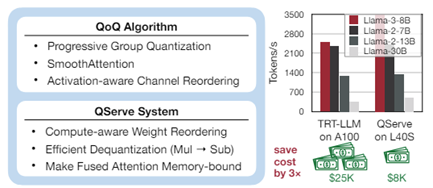
- ZipCache: Accurate and Efficient KV Cache Quantization with Salient Token Identification by Houmo AI and Chinese universities (https://arxiv.org/pdf/2405.14256).Authors present a KV cache quantization method for LLMs. First, they construct a strong baseline for quantizing KV cache. Through the proposed channel-separable token-wise quantization scheme, the memory overhead of quantization parameters is substantially reduced compared to fine-grained group-wise quantization. To enhance the compression ratio, they propose a normalized attention score. The quantization bit-width for each token is adaptively assigned based on their saliency. The authors also develop an approximation method that decouples the saliency metric from full attention scores compatible with FlashAttention. Experiments demonstrate that the method achieves good compression ratios at fast generation speed, for example, when evaluating Mistral-7B model on GSM8k dataset, the method is capable of compressing the KV cache by 4.98×,with only a 0.38% drop in accuracy.

- BitsFusion: 1.99 bits Weight Quantization of Diffusion Model by Snap Inc. and Rutgers University (https://arxiv.org/pdf/2406.04333). The paper provides a thorough analysis of UNet weight-only quantization of Stable Diffusion 1.5 model. The authors propose an approach for mixed-precision quantization of diffusers. They quantize different layers into different bits according to their quantization error. The authors also introduce several techniques to initialize the quantized model to improve performance, including time embedding pre-computing and caching, adding balance integer, and alternating optimization for scaling factor initialization. Finally, they propose a two-stage Quantization-aware training where distillation is used at the first stage. The quantized model achieves very good results on various benchmarks. Code will be released here: https://github.com/snap-research/BitsFusion.

- Applying t-Distributions to Explore Accurate and Efficient Format[KA1] s for LLMs by Cornell University and Google (https://arxiv.org/abs/2405.03103). The paper investigates non-uniform quantization data formats by profiling the distributions of weight and activation across 30 models, including both LLM and non-LLM models. The authors discovered that Student’s t-Distribution is a better fit than the Gaussian distribution due to its flexible parameterization, which can resemble Gaussian, Cauchy, or other distributions observed indifferent neural networks. The authors derived Student Float (SF4) using a similar design process to Normal Float (NF4). SF4 outperforms NF4, FP4, and Int4 in accuracy retention across most cases and model architectures, making it a strong drop-in replacement for lookup-based datatypes like NF4. The paper proposes using SF4as a reference to extend supernormal support for existing datatypes like E2M1(one variant of FP4) and APoT4,by reassigning negative zero to a useful value, which is otherwise wasted. Additionally, the paper examines the Pareto frontier of datatypes in terms of model accuracy and MAC chip area, concluding that APoT4 and its supernormal extension are Pareto optimal for a set of models smaller than 7B parameters.
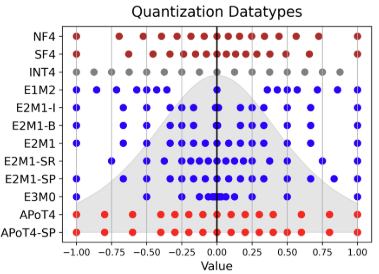
- ShiftAddLLM: MatMul-free LLM via Inference Time Reparameterization by Intel, Google Deep Mind, Google, Georgia Tech (https://arxiv.org/pdf/2406.05981).Authors developed an inference time reparameterization for traditional LLMs layers with MatMul ops to convert them to layers with Shift-Add and LUT query-based operations only. Specifically, authors quantize each weight matrix into binary matrices paired with group-wise scaling factors. The associated multiplications are reparameterized into (1) shifts between activations and scaling factors and (2) queries and adds according to the binary matrices. To reduce accuracy loss, they present a multi-objective optimization method to minimize both weight and output activation reparameterization errors. Additionally, based on varying sensitivity across layers to reparameterization, they develop an automated bit allocation strategy to further reduce memory usage and latency. The code is available at: https://github.com/GATECH-EIC/ShiftAddLLM.
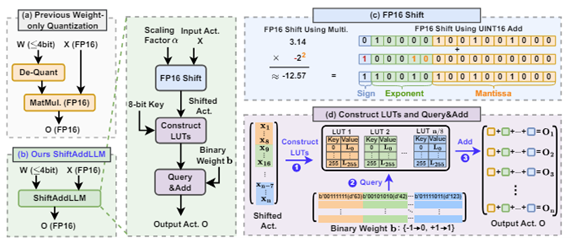
Quantization
- QServe: W4A8KV4 Quantization and System Co-design for Efficient LLM Serving by MIT, NVIDIA, UMass Amherst, MIT-IBM Watson AI Lab (https://arxiv.org/pdf/2405.04532). A regular work from Song Han Lab which is a comprehensive study of deep LLM optimization and a reference design of a tool for LLM serving. The LLM optimization part includes: W4A8 and 4-bit KV-cache quantization approach; Progressive quantization of weights, to comply with 8-bit compute after dequantizing4-bit weights to 8-bits; SmoothAttention method, to reduce the error of 4-bit quantization of Key cache that is compatible with RoPE operation and can be fused into a preceding Linear layer; Progressive quantization of weights, to comply with 8-bit compute after dequantizing4-bit weights to 8-bits. The inference part contains tips and tricks to design efficient inference kernels and execution pipelines on the Nvidia GPUs. The method shows superior results comparing to competitive solutions and demonstrates the ability to substantially reduce LLM serving costs. Some code and pre-compiled binaries are available here: https://github.com/mit-han-lab/qserve.
- LQER: Low-Rank Quantization Error Reconstruction for LLMs by Imperial College London London and University of Cambridge (https://arxiv.org/pdf/2402.02446). The paper combines quantization and low-rank approximation techniques to achieve accurate and efficient LLM optimization. The method employs MXINT4 datatype (int4 + shared exponent for 4 elements) for weight quantization while quantizing activation into 8 or 6 bits with per-token scaling factors. The method also introduces 8-bit LoRA adapters to restore accuracy after weight quantization. It does not use any kind of fine-tuning. Instead, it introduces the error decomposition into two low-rank matrices. The method achieves very accurate results in W4A8 and W4A6 settings, especially on Llama-2 model family.
- LLM-QBench: A Benchmark Towards the Best Practice for Post-training Quantization of Large Language Models by Beihang University, SenseTime Research, and Nanyang Technological University (https://arxiv.org/pdf/2405.06001).The paper focuses on identifying the most effective practices for quantizing LLMs, with the goal of balancing performance with computational efficiency. Fora fair analysis, the authors develop a quantization toolkit LLMC and design four crucial principles considering the inference efficiency, quantized accuracy, calibration cost, and modularization. By benchmarking on various models and datasets with over 500 experiments, three takeaways corresponding to calibration data, quantization algorithm, and quantization schemes are derived. Finally, a best practice of LLM PTQ pipeline is constructed. All the benchmark results and the toolkit can be found at https://github.com/ModelTC/llmc.
- SKVQ: Sliding-window Key and Value Cache Quantization for Large Language Models Houmo AI by Houmo AI and Chinese universities (https://arxiv.org/pdf/2405.06219). The paper addresses the problem of extremely low bit-width KV cache quantization. To achieve this, it proposes a method that rearranges the channels of the KV cache in order to improve the similarity of channels in quantization groups and applies clipped dynamic quantization at the group level. Additionally, the method ensures that the most recent window tokens in the KV cache are preserved with high precision. This helps maintain the accuracy of a small but important portion of the KV cache. Evaluation on LLMs demonstrates that the method surpasses previous quantization approaches, allowing for quantization of the KV cache to 2-bit keys and 1.5-bit values with minimal loss of accuracy. The code is available at https://github.com/cat538/SKVQ.
- Integer Scale: A Free Lunch for Faster Fine-grained Quantization of LLMs by Meituan (https://arxiv.org/pdf/2405.14597). The paper proposes a scheme to use integer scales when computing dot products of W4A8quantized LLMs. It allows keeping group scales for weights in the integer precision as well and using INT32 buffer as the accumulator of partial dot products. An additional floating point scale is required and applied to the super-group of dot products between weights and activations. It brings the proposed method close to the known double quantization approach. The paper provides extensive evaluation data for Llama2 and Llama3 models showing close results to the baseline floating-point scales.
- Mitigating Quantization Errors Due to Activation Spikes in GLU-Based LLMs by Hanyang University (https://arxiv.org/pdf/2405.14428).The paper aims at reducing the accuracy degradation of fully-quantized LLM models (both weights and activations are quantized). Authors propose two empirical methods, Quantization-free Module (QFeM) and Quantization-free Prefix (QFeP), to isolate the activation spikes during quantization that cause most of the accuracy drop. Essentially, they propose a way to identify what layers are more error-prone and keep these layers in the floating-point precision. The code is available at https://github.com/onnoo/activation-spikes.
- AdpQ: A Zero-shot Calibration Free Adaptive Post Training Quantization Method for LLMs by Huawei Noah Lab and McGill University (https://arxiv.org/pdf/2405.13358).This paper presents a novel zero-shot adaptive PTQ method for LLMs that does not require any calibration data. Inspired by Adaptive LASSO regression model, the authors proposed approach that tackles the challenge of outlier activations by separating salient weights using an adaptive soft-thresholding method. Guided by Adaptive LASSO, this method ensures that the quantized weights distribution closely follows the originally trained weights and eliminates the need for calibration data entirely. The method achieves good results at much faster quantization time.
- PTQ4SAM: Post-Training Quantization for Segment Anything by Beihang University (https://arxiv.org/pdf/2405.03144).A practical study on quantization of the Segment Anything model. The authors observe a challenging bimodal distribution for quantization and analyze its characteristics. To overcome it, they propose a Bimodal Integration (BIG)strategy, which automatically detects it and transforms the bimodal distribution to normal distribution equivalently. They also present the Adaptive Granularity Quantization which represents diverse post-Softmax distributions accurately with appropriate granularity. Experiments show that the method can achieve good results even in low-bit quantization settings (6 or4 bits). Code is available at https://github.com/chengtao-lv/PTQ4SAM.
- QNCD: Quantization Noise Correction for Diffusion Models by Kuaishou Technology (https://arxiv.org/pdf/2403.20137). Authors identify two primary quantization challenges for Duffusion models: intra and inter quantization noise. Intra quantization noise, exacerbated by embeddings in the resblock module, extends activation quantization ranges, increasing disturbances in each single denoising step. Besides, inter quantization noise stems from cumulative quantization deviations across the entire denoising process, altering data distributions step-by-step. Authors propose embedding-derived feature smoothing for eliminating intra quantization noise and a runtime noise estimation module for dynamically filtering inter quantization noise. Experiments demonstrate that the method achieves good results in W4A8 and W8A8 quantization settings on ImageNet (LDM-4). Code is available at: https://github.com/huanpengchu/QNCD.
- SliM-LLM: Salience-DrivenMixed-Precision Quantization for Large Language Models by The ETH Zürich, University of Hong Kong, and Beihang University (https://arxiv.org/pdf/2405.14917).The paper focuses on the problem of ultra-low bit weight quantization of LLMs. Specifically, it proposes the method relies on two novel techniques: (1)Salience-Determined Bit Allocation utilizes the clustering characteristics of salience distribution to allocate the bit-widths of each quantization group. This increases the accuracy of quantized LLMs and maintains the inference efficiency high; (2) Salience-Weighted Quantizer Calibration optimizes the parameters of the quantizer by considering the element-wise salience within the group. The method is evaluated in two setups for quantization parameters tuning: greedy search and gradient based search. Evaluation shows good results on Llama 1/2/3 models. Code is available at https://github.com/Aaronhuang-778/SliM-LLM.
- LCQ: Low-Rank Codebook based Quantization for Large Language Models by Nanjing University (https://arxiv.org/pdf/2405.20973). The paper proposes a method for LLM optimization using customized low-ranking codebooks the rank of which can be larger than one, for quantization. A gradient-based optimization algorithm is proposed to optimize the parameters of the codebook. The method also adopts a double quantization strategy for compressing the parameters of the codebook, which can reduce the storage cost of the codebook. Experiments show that achieves better accuracy than existing methods with a negligibly extra storage cost.
- P2 -ViT: Power-of-Two Post-Training Quantization and Acceleration for Fully Quantized Vision Transformer by Nanjing University and Sun Yat-sen University (https://arxiv.org/pdf/2405.19915). The paper introduces a Power-of-Two (PoT) post-training quantization and acceleration framework for ViT models. The authors analyze ViTs’ properties and develop a dedicated quantization scheme. This scheme incorporates techniques such as adaptive PoT rounding and PoT Aware smoothing, allowing for the efficient quantization of ViTs with PoT scaling factors. By doing this, computationally expensive floating-point multiplications and divisions with in the re-quantization process can be traded with hardware-efficient bitwise shift operations. Furthermore, we introduce a coarse-to-fine automatic mixed-precision quantization methodology for better accuracy-efficiency trade-offs. Finally, authors build a dedicated accelerator engine to better everage our algorithmic properties for enhancing hardware efficiency. Code is available at: https://github.com/shihuihong214/P2-ViT.
- QJL: 1-Bit Quantized JLTransform for KV Cache Quantization with Zero Overhead by New York University and Adobe Research (https://arxiv.org/pdf/2406.03482).The paper studies problems of KV-cache quantization of LLMs, specifically the Key part as it is more error-prone when lowering its precision. Authors propose an approach that consists of a Johnson-Lindenstrauss (JL) transform followed by sign-bit quantization for Key cache. They introduce an asymmetric estimator for the inner product of two vectors and demonstrate that applying the method to one vector and a standard JL transform without quantization to the other provides an unbiased estimator with minimal distortion. They also developed a CUDA-based implementation for optimized computation. When applied across various LLMs and NLP tasks to quantize the KV cache to only 3 bits, the method demonstrates a more than fivefold reduction in KV cache memory usage without an insignificant accuracy drop. Codes will be available at https://github.com/amirzandieh/QJL.
- ViDiT-Q: Efficient and Accurate Quantization of Diffusion Transformers for Image and Video Generation by Tsinghua University, Infinigence AI, 3Microsoft, and Shanghai Jiao Tong University (https://arxiv.org/pdf/2406.02540).The paper tackles the problems of accurate quantization of diffusion vision transformer models. Essentially, authors apply dynamic 8-bit per-token quantization to activations. They also propose to smooth activation with a Smoothquant-like approach but with different α factors tuned to each iteration of the diffusion process. Finally, authors propose to select a per-layer weight bit-width (e.g.W4A8, W6A6, or W8A8) depending on the sensitivity and position of the layer in the Transformer block. All these tricks lead to very good accuracy results in the image and video generation tasks.
- Instance-Aware Group Quantization for Vision Transformers by Yonsei University and Articron (https://arxiv.org/pdf/2404.00928). In this paper an approach for instance-aware group quantization for ViTs(IGQ-ViT) is introduced. According to the approach, channels of activation maps are dynamically split into multiple groups where each group has its own set of quantization parameters. Authors also extend their scheme to quantize softmax attentions across tokens. IGQ-ViT demonstrates superior accuracy results across image classification, object detection and instance segmentation task. Authors claim that performance overhead induced by dynamic quantization is no more than 4% compared to layer-wise quantization.
- Reg-PTQ: Regression-specialized Post-training Quantization for Fully Quantized Object Detector by Beihang University (https://openaccess.thecvf.com/content/CVPR2024/papers/Ding_Reg-PTQ_Regression-specialized_Post-training_Quantization_for_Fully_Quantized_Object_Detector_CVPR_2024_paper.pdf). In this paper authors explore full quantization of object detection models contrary to most existing approaches which quantize only detection backbones and keep detection head in original precision. Based on the findings, the reason behind poor quantization of detector heads is that they are optimized to solve regression tasks. Specifically, authors argue that (1) regressors are more sensitive to perturbation compared to classifiers, (2) minimizing quantization error does not necessarily result in optimal scaling factors for regressor and(3) regressors weights follow non-uniform distribution contrary to classifiers. To tackle these problems a novel Reg-PTQ method is introduced. Based on the results it achieves 7.6x and 5.4x reduction in computation and storage consumption under INT4 precision with little performance degradation.
- Towards Accurate Post-training Quantization for Diffusion Models (https://openaccess.thecvf.com/content/CVPR2024/papers/Wang_Towards_Accurate_Post-training_Quantization_for_Diffusion_Models_CVPR_2024_paper.pdf). In this paper authors propose a method for accurate post-training quantization of diffusion models. The main idea is to split diffusion timesteps for each layer into groups where each group corresponds to its own set of quantization parameters. Such split is obtained by minimizing some optimization objective on a calibration dataset. Besides this, a special timestep selection method is employed for sampling timesteps for calibration. Overall, the method demonstrates superior generation quality results over such baselines as LSQ, PTQ4DM and Q-Diffusion.
Pruning/Sparsity
- Effective Interplay between Sparsity and Quantization: From Theory to Practice by Google and EcoCloud (https://arxiv.org/pdf/2405.20935). Authors provide the theoretical analysis of how sparsity and quantization interact. Mathematical proofs establish that applying sparsity before quantization (S → Q) is the optimal sequence for compression. Authors demonstrate that sparsity and quantization are not orthogonal operations. Combining them introduces additional errors beyond the sum of their individual errors. They validate theoretical findings through experiments covering a diverse range of models, including prominent LLMs (OPT, LLaMA) and ViTs. The code will be published at: https://github.com/parsa-epfl/quantization-sparsity-interplay.
- Prompt-prompted Mixture of Experts for Efficient LLM Generation by CMU (https://arxiv.org/pdf/2404.01365). Authors introduce GRIFFIN, a training-free MoE that selects unique FF experts at the sequence level for efficient generation across a plethora of LLMs with different non-ReLU activation functions. This is possible due to a critical observation that many trained LLMs naturally produce highly structured FF activation patterns within a sequence, which we call flocking. Despite the method’s simplicity, it shows with 50% of the FF parameters, GRIFFIN maintains the original model’s performance with little to no degradation on a variety of classification and generation tasks, all while improving latency (e.g. 1.25× speed-up in Llama 213B on an NVIDIA L40). Code is available at https://github.com/hdong920/GRIFFIN.
- Sparse maximal update parameterization: A holistic approach to sparse training dynamics by Cerebras Systems (https://arxiv.org/pdf/2405.15743).This paper addresses the common issue in sparse training where hyper parameters from dense training are reused, leading to suboptimal convergence, and requiring extensive tuning for different sparsity ratios. The researchers introduce a novel sparse training methodology called Sparse Maximal Update Parameterization (SuPar), which extends the maximal update parameterization (uP)to sparse training. SuPar involves reparameterizing (see Table 1) weight initialization and learning rates relative to changes in sparsity, effectively preventing exploding or vanishing signals and maintaining stable activation, gradient, and weight update scales across varying sparsity levels and model widths. SuPar reparameterization is remarkable, it allows zero-shot hyperparameter transfer, i.e. practitioners can now tune small proxy models(dense/sparse) and transfer optimal HPs directly to models at scale for any model sparsity, thus enhancing the efficiency and reducing the cost of sparse model development. Experiments demonstrate that SμPar sets the Pareto frontier best loss across all sparsities and widths, including large dense model with width equal to GPT-3 XL.
- Sparse Expansion and Neuronal Disentanglement by MIT, IST Austria, Neural Magic (https://arxiv.org/pdf/2405.15756). Sparse Expansion is an approach of converting dense LLMs to mixture of sparse experts to attain inference efficiency. The method begins with applying dimensionality reduction (PCA) on the inputs of FFN linear layers, followed by a k-means clustering. The intuition is that tokens within a cluster share a sparse expert better without significant distortion. SparseGPT is then used to create a sparse expert for each cluster group. During inference, the PCA and k-means models act as routers, directing tokens to the appropriate sparse expert based on their cluster. While this increases the overall model size, acceleration is achieved through the conditional execution of experts and the sparse execution of these experts, with minimal cost for the routers. The paper includes layer-wise speedup benchmarks and shows that Sparse Expansion outperforms other one-shot sparsification approaches in perplexity for the same inference FLOP budget per token. A significant portion of the paper is dedicated to the concept of neuron entanglement, explaining, and quantifying the efficacy of sparse expansion.
- MULTIFLOW: Shifting Towards Task-Agnostic Vision-Language Pruning by University of Trento and Cisco Research (https://arxiv.org/pdf/2404.05621). Authors highlight that existing techniques for pruning of Visual-Language models(VLMs) are task-specific and propose a task-agnostic method for pruning VLMs. The proposed Multimodal Flow Pruning framework has the following properties: (1) the importance of a weight is computed based on saliency of the neurons it connects; and (2) parameters are pruned considering features of which modality they are used to compute allowing to avoid pruning too much from a single modality and too little from another. Experiments show that the proposed MULTIFLOW method outperforms recent more sophisticated competitors.
Other methods
- Flash Diffusion: Accelerating Any Conditional Diffusion Model for Few Steps Image Generation by Jasper Research (https://arxiv.org/pdf/2406.02347). The paper proposes a LoRA-compatible distillation method aiming at reducing the number of sampling steps required to generate high-quality samples from a trained diffusion model. Authors emphasize the versatility of the method through an extensive experimental study across various tasks (text-to-image, image inpainting, super-resolution, face-swapping), diffusion model architectures (SD1.5, SDXL and Pixart-α) and illustrate its compatibility with adapters. The method is relatively lightweight and can optimize SD1.5 model with 2 Nvidia H100 80GB with 13 hours of fine-tuning. Code is available at https://github.com/gojasper/flash-diffusion.
- GaLore: Memory-Efficient LLM Training by Gradient Low-Rank Projection by California Institute of Technology, Meta AI, University of Texas at Austin, and Carnegie Mellon University (https://arxiv.org/pdf/2403.03507). The paper introduces a Gradient Low-Rank Projection (GaLore), a training strategy that allows full-parameter learning but is more memory-efficient than common low-rank adaptation methods such as LoRA. The idea is to use PCA after a number of training steps to obtain a gradient projection matrix and use it to get a low-rank gradient matrix that is used for weights update. The approach reduces memory usage by up to 65.5% in optimizer states while maintaining both efficiency and performance for pre-training. 8-bit GaLore further reduces optimizer memory by up to 82.5% and total training memory by 63.3%, compared to a BF16 baseline. It demonstrates the feasibility of pre-training a 7B model on consumer GPUs with 24GB memory. The code is available at: https://github.com/jiaweizzhao/GaLore.
- MiniCache: KV Cache Compression in Depth Dimension for Large Language Models by ZIP Lab of Monash and Zhejiang University (https://arxiv.org/pdf/2405.14366).The authors propose a training-free KV cache compression technique by merging KV tokens across every two consecutive transformer layers, based on the observation that KV tokens are highly similar across depth, especially from the middle to the last transformer layers. Specifically, a pair of K/V projections from two consecutive layers can be encoded into respective scaling factors and a shared directional vector computed via Spherical Linear Interpolation(SLERP). To address the information loss from merging dissimilar tokens, the algorithm uses angular-based distance to filter KV positions for retention. The algorithm is straightforward, involving calibration of only two hyperparameters, and it has demonstrated to enhance a 4X compressed KV cache by4-bit quantization to over 5X compression while retaining reasonable accuracy of instruction-tuned Mistral, LLama2-7B across benchmarks.
- Scalable MatMul-free Language Modeling by University of California, Soochow University, LuxiTech (https://arxiv.org/pdf/2406.02528). Authors develop a MatMul-free language model by using additive operations in dense layers and element-wise Hadamard products for self-attention-like functions. Specifically, ternary weights eliminate MatMul in dense layers, similar to BNNs. To remove MatMul from self-attention, they optimize the Gated Recurrent to rely solely on element-wise products and show that this model competes with state-of-the-art Transformers while eliminating all MatMul operations. To quantify the hardware benefits of lightweight models, the authors provide an optimized GPU implementation in addition to a custom FPGA accelerator. By using fused kernels in the GPU implementation of the ternary dense layers, training is accelerated by 25.6% and memory consumption is reduced by up to 61.0% over an unoptimized baseline on GPU. Furthermore, by employing lower-bit optimized CUDA kernels, inference speed is increased by 4.57 times, and memory usage is reduced by a factor of 10 when the model is scaled up to 13B parameters. The code is available at https://github.com/ridgerchu/matmulfreellm.
- Unlocking Efficiency in Large Language Model Inference: A Comprehensive Survey of Speculative Decoding by Hong Kong Polytechnic, Peking University, Microsoft Research Asia and Alibaba (https://arxiv.org/abs/2401.07851). While LLMs are proliferating over the past two years, Speculative Decoding (SD) has emerged as a crucial paradigm to accelerate autoregressive generation. This survey is among the first to provide a comprehensive introduction and overview of the state of the art in SD, highlighting key developments in this space. A main contribution of this work is the introduction of Spec-Bench, a unified benchmark for evaluating SD methods across standardized subtasks such as multi-turn conversation, summarization, RAG, translation, question answering, and mathematical reasoning. The codes and benchmarks for various SD methods on RTX 3090 and A100 GPUs are accessible for further exploration and validation.
- Speculative Decoding via Early-exiting for Faster LLM Inference with Thompson Sampling Control Mechanism by Meituan and Meta AI (https://arxiv.org/pdf/2406.03853).The paper introduces an early-exiting framework for generating draft tokens, which allows a single LLM to fulfill the drafting and verification stages. The model is trained using self-distillation. The authors conceptualize the generation length of draft tokens as a multi-armed bandit problem and propose a control mechanism based on Thompson Sampling, which leverages sampling to devise an optimal strategy. They conducted experiments on three benchmarks and showed that the method can significantly improve the model’s inference speed.
- LayerSkip: Enabling Early Exit Inference and Self-Speculative Decoding by Meta, University of Toronto, Carnegie Mellon University, University of Wisconsin-Madison, Dana-Farber Cancer Institute (https://arxiv.org/pdf/2404.16710).Authors research the idea of early exit in LLMs for speculative decoding. First, during training, they apply layer dropout, with low dropout rates for earlier layers and higher dropout rates for later layers, and an early exit loss where all transformer layers share the same exit. Second, during inference, they show that this training recipe increases the accuracy of early exit at earlier layers, without adding any auxiliary layers or modules to the model. Third, they present a self-speculative decoding solution where we exit at early layers and verify and correct with remaining layers of the model. They run experiments on different Llama model sizes on different types of training: pretraining from scratch, continual pretraining, finetuning on specific data domain, and finetuning on specific task, and show speedups of up to 2.16× on summarization for CNN/DM documents, 1.82× on coding, and 2.0× on TOPv2 semantic parsing task.
Software
- INT4 Decoding GQA CUDA Optimizations for LLM Inference by Meta(https://pytorch.org/blog/int4-decoding).The authors provide a comprehensive study and ten practical steps, including KV-cache quantization, to improve the performance of Grouped-query Attention. All these optimizations result in performance improvements of up to 1.8x on the NVIDIA A100 GPU and 1.9x on the NVIDIA H100 GPU.
- torchao: PyTorch Architecture Optimization by Meta (https://github.com/pytorch/ao). PyTorch library for quantization and sparsity. Currently-available features contain full models quantization, INT8, INT4, MXFP4,6,8 weight-only quantization and efficient model fine-tuning with GaLore method.
- Introducing Apple’s On-Device and Server Foundation Models by Apple (https://machinelearning.apple.com/research/introducing-apple-foundation-models). Apple has established a set of pre-trained and optimized models for its HW. The claim is that 3B LLM model can be run at 30t/s on iPhone 15 Pro. In terms of optimizations that are being used, authors claim weight palletization to 2 and 4 bits, quantization of embeddings and activations and efficient Key-Value (KV) cache update. They use their own AXLearn library built on top of JAX and XLA for model pre-training and fine-tuning.
- BitBLAS by Microsoft (https://github.com/microsoft/BitBLAS).A library to support mixed-precision BLAS operations on GPUs. BitBLAS aims to support efficient mixed-precision DNN model deployment, especially the quantization in large language models (LLMs), for example, the 𝑊4𝐴16 in GPTQ, the 𝑊2𝐴16 in BitDistiller, the 𝑊2𝐴8 in BitNet-b1.58.

